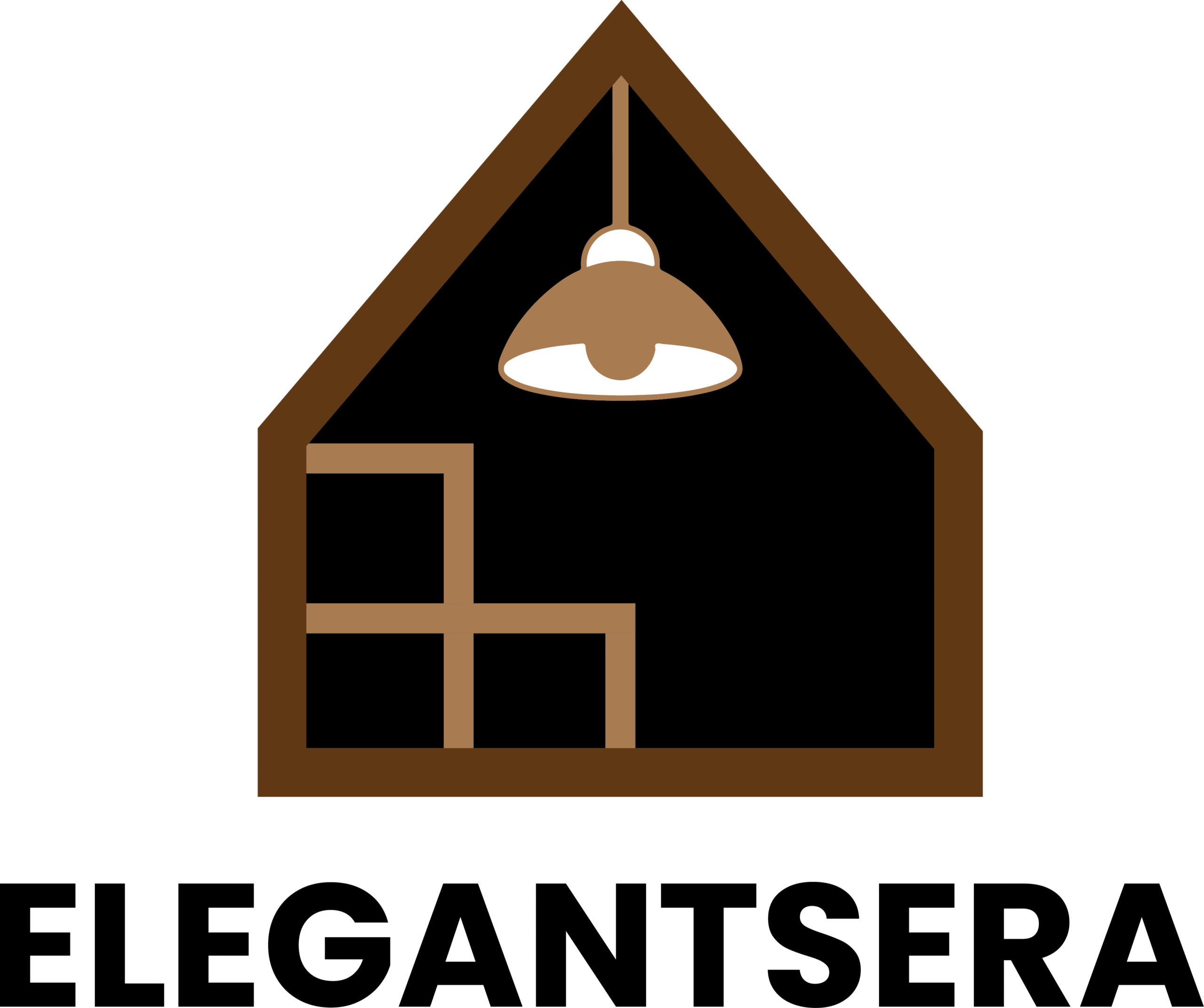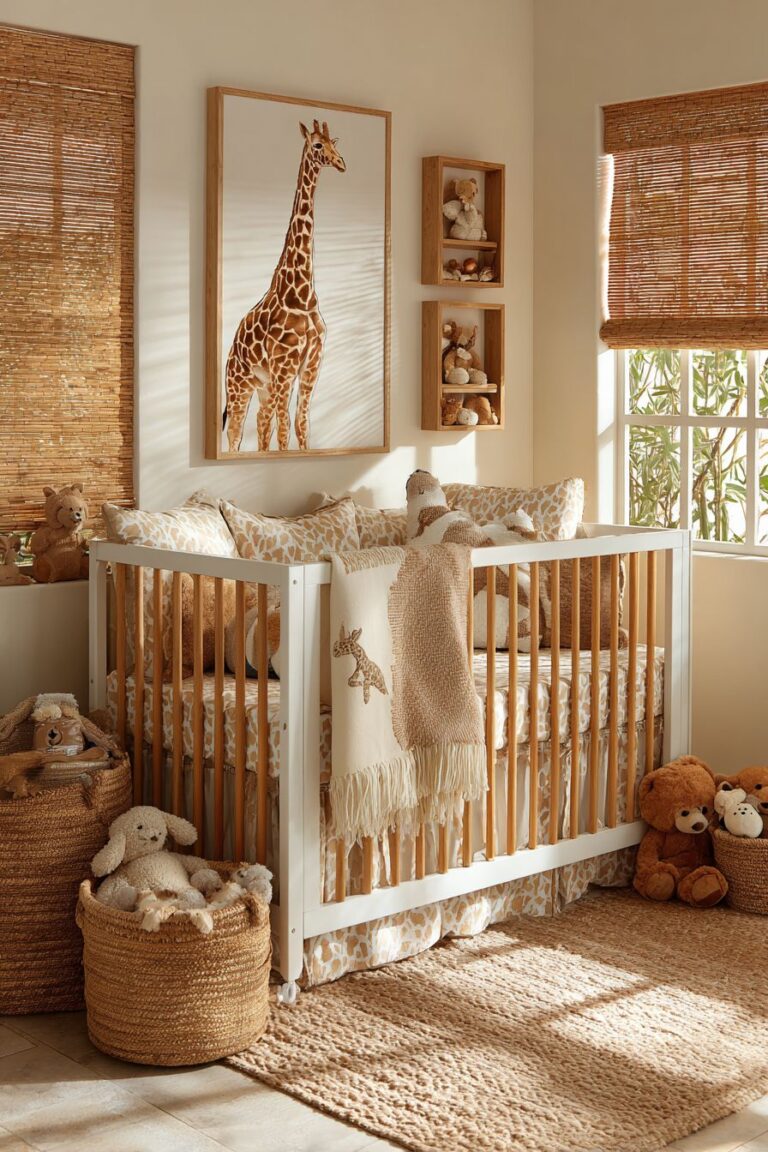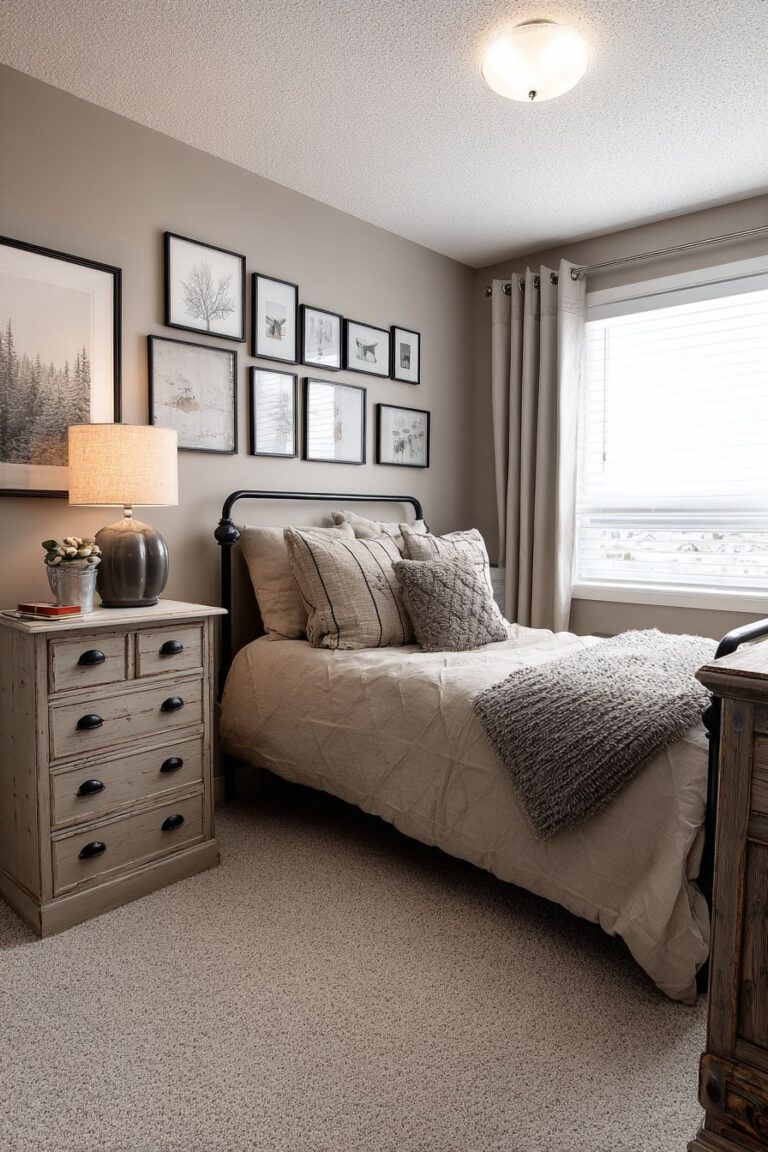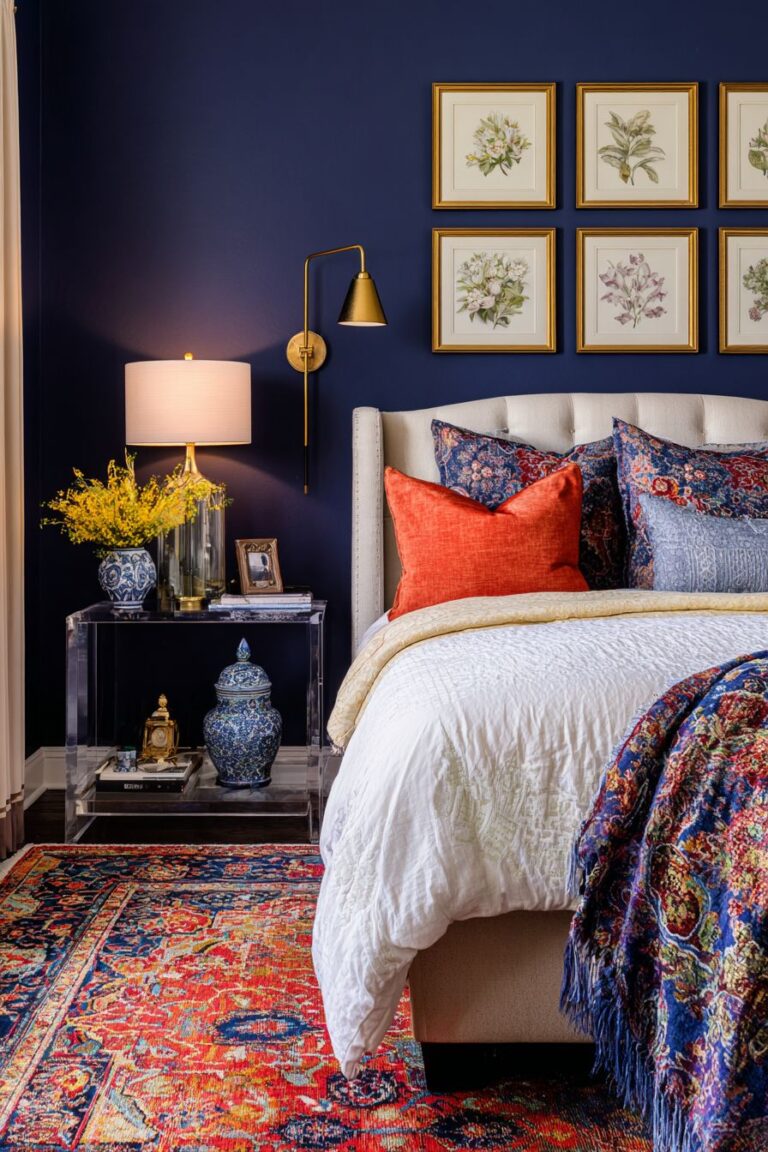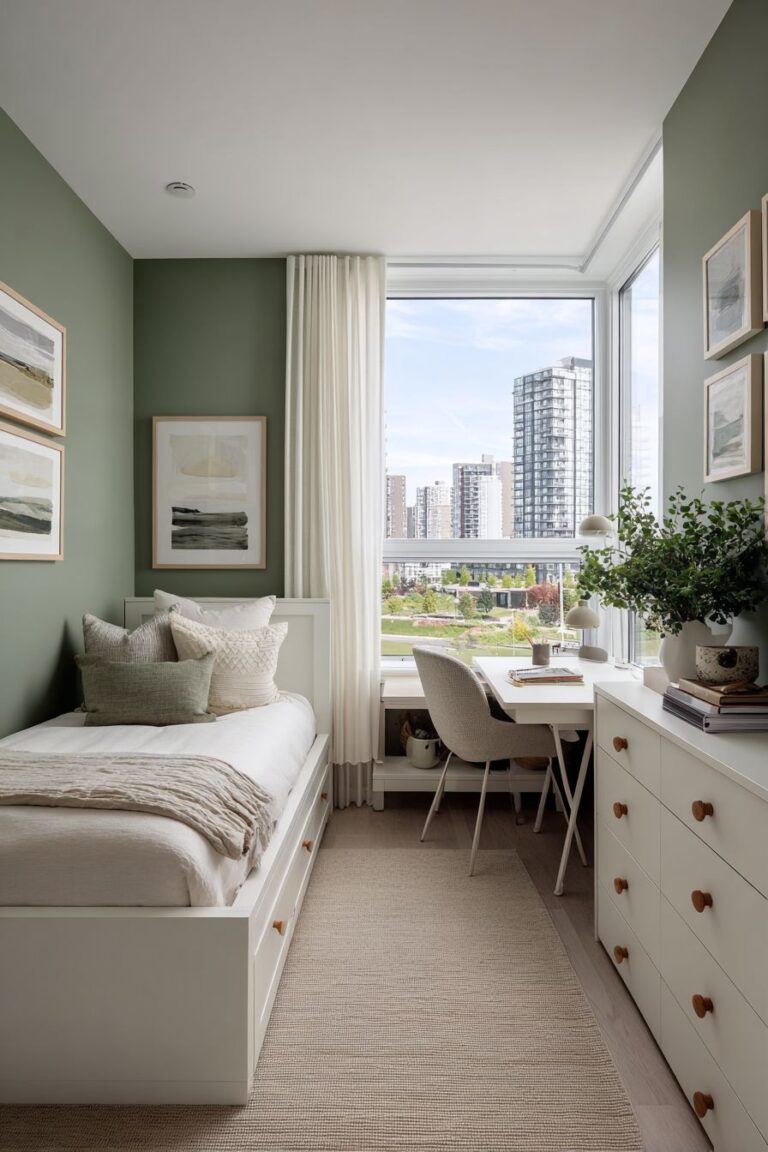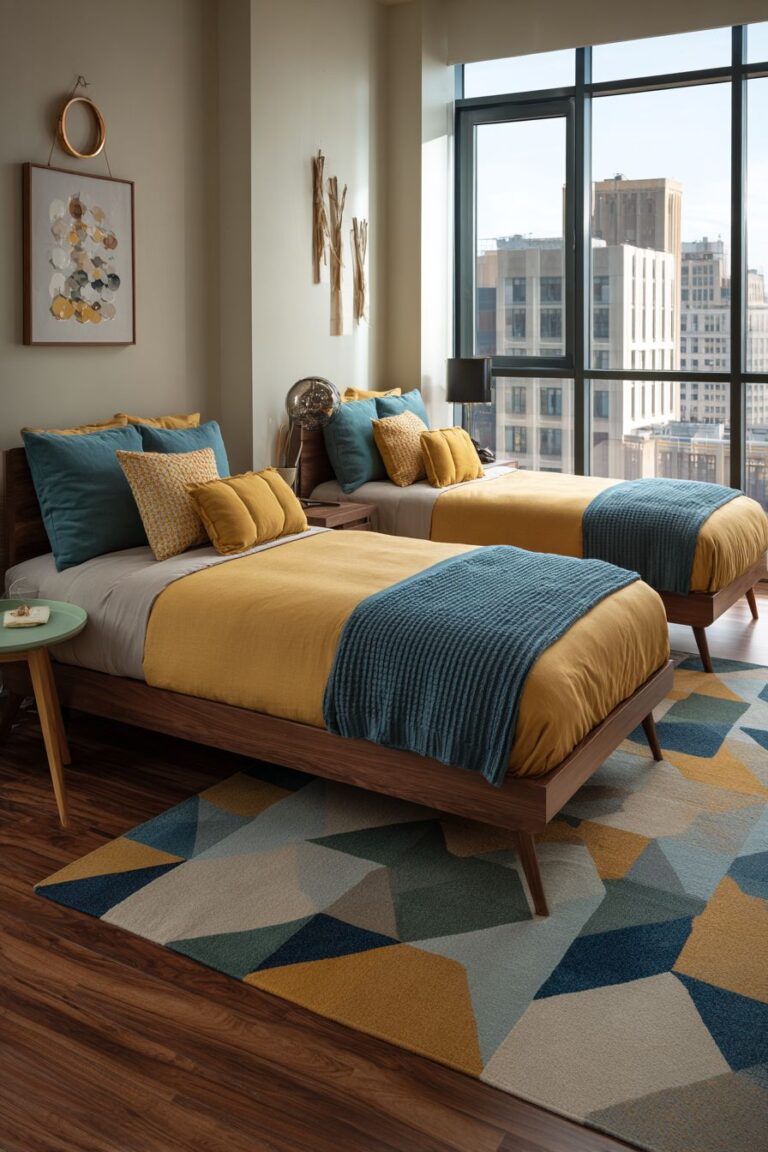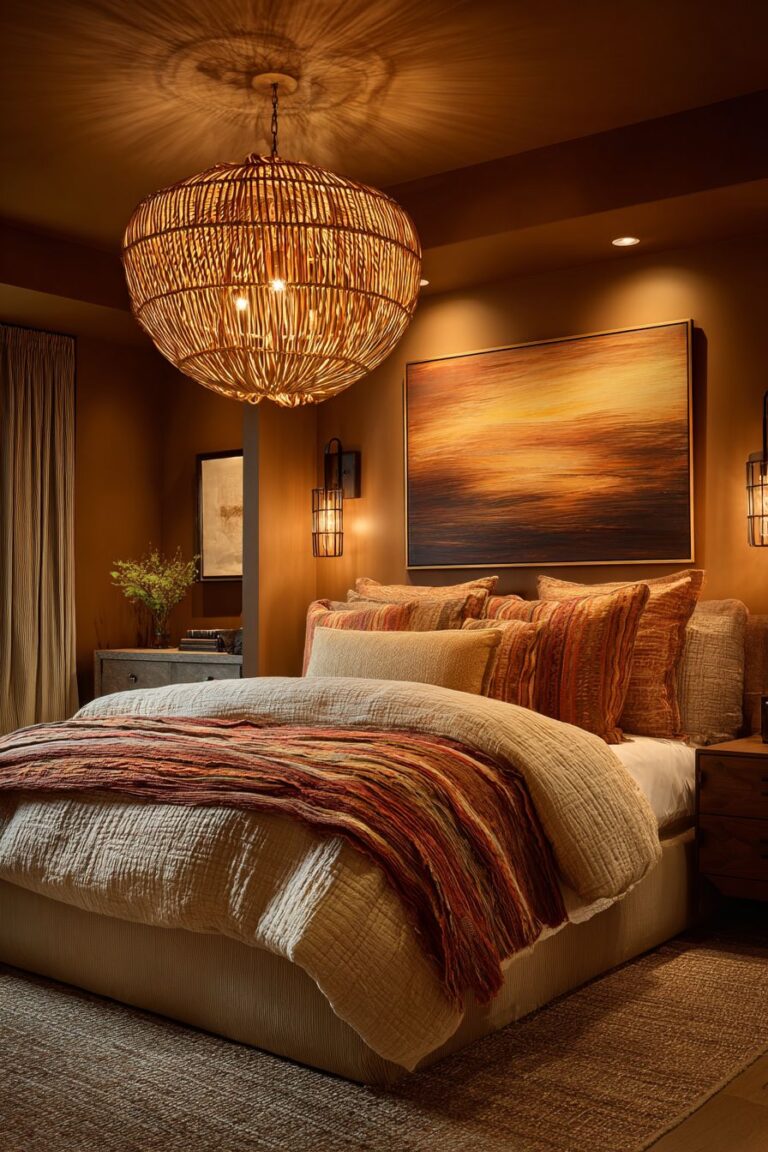19+ Timeless Mid Century Bedroom Ideas For Modern Living
The mid-century modern aesthetic has transcended its original era to become one of the most enduring and beloved interior design movements of our time. Born in the post-war period between the 1940s and 1960s, this design philosophy emphasized clean lines, organic forms, and a seamless integration of form and function that continues to resonate with homeowners today. A mid-century bedroom is more than just a sleeping space—it’s a carefully curated environment that balances minimalist principles with warm, inviting materials, creating a sanctuary that feels both timeless and refreshingly contemporary.
What makes mid-century bedroom design particularly compelling is its versatility and adaptability to modern lifestyles. Whether you’re drawn to the iconic furniture pieces with their distinctive tapered legs and sculpted forms, the rich warmth of teak and walnut woods, or the bold yet sophisticated color palettes of mustard yellows, olive greens, and burnt oranges, there’s a mid-century approach that can transform your bedroom into a haven of style and comfort. The movement’s emphasis on bringing the outdoors in through large windows, natural materials, and organic shapes creates spaces that feel connected to nature while maintaining a distinctly modern sensibility.
In this comprehensive guide, we’ll explore twenty distinct mid-century bedroom designs, each showcasing different aspects of this influential design movement. From the fundamental elements of platform beds and streamlined storage solutions to the finer details of lighting fixtures, textiles, and decorative accents, you’ll discover how to incorporate authentic mid-century style into your own bedroom. These designs demonstrate how thoughtful interior design can create functional, inspiring spaces that cater to diverse personalities and lifestyles while honoring the enduring principles that made mid-century modern design a cultural phenomenon.
1. Walnut Platform Bed With Geometric Textiles
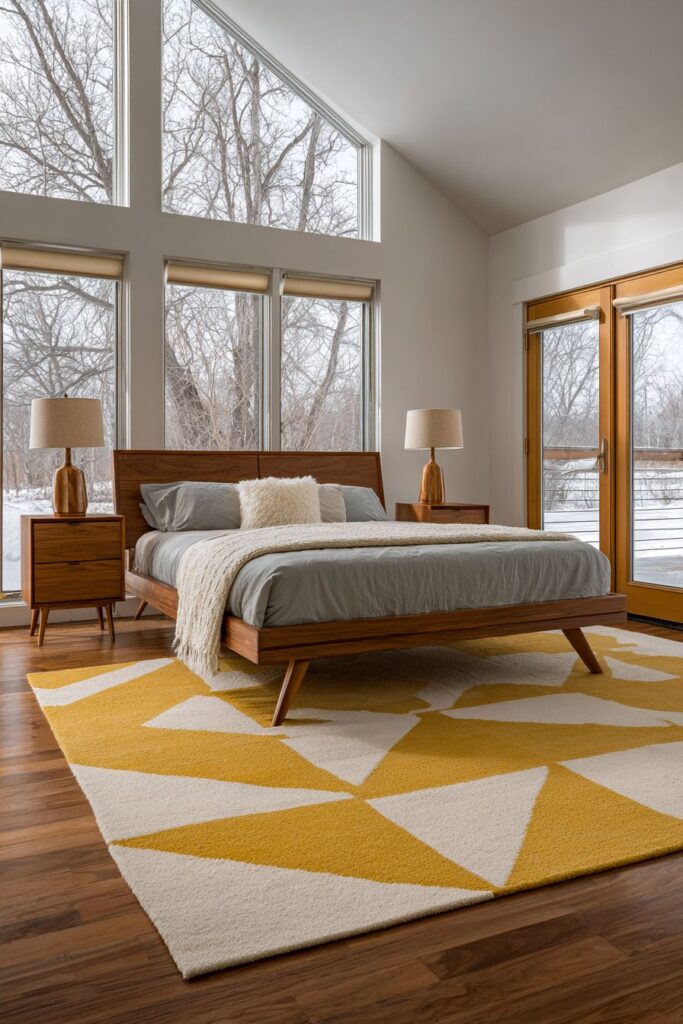
The quintessential mid-century bedroom begins with the foundation of a low-profile walnut platform bed, its tapered legs creating an elegant silhouette that appears to float above the floor. This centerpiece exemplifies the era’s commitment to clean lines and functional beauty, where every element serves a purpose while contributing to the overall aesthetic harmony. The warm, honey-toned walnut wood brings an organic richness to the space, its natural grain patterns creating visual interest without overwhelming the minimalist design philosophy.
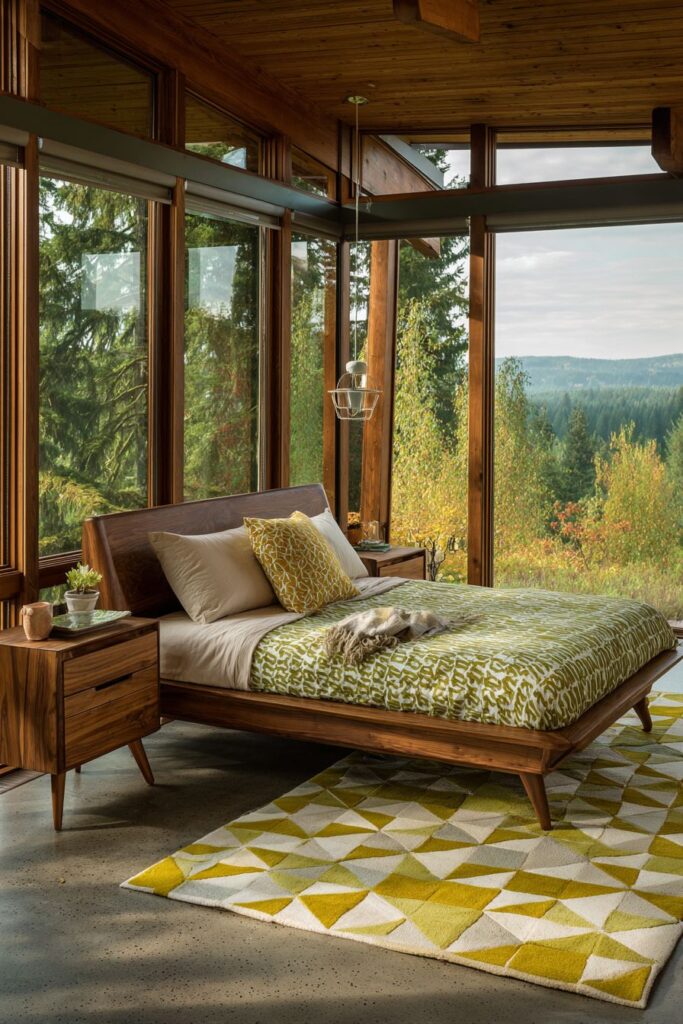
Flanking this stunning bed are matching nightstands with brass drawer pulls that catch and reflect the abundant natural light streaming through large windows. The hardware choices are deliberate—brass adds a touch of warmth and sophistication without the coldness of chrome or the heaviness of darker metals. These nightstands aren’t merely functional storage pieces; they’re sculptural elements that complement the bed’s proportions while maintaining the visual lightness characteristic of mid-century design.
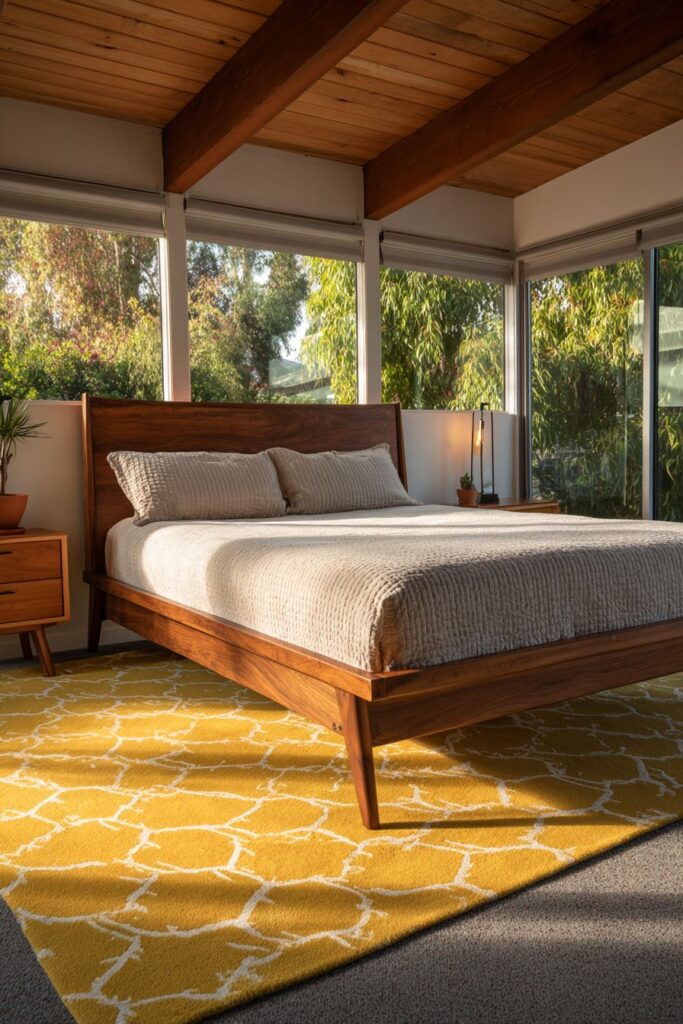
The geometric wool area rug in mustard yellow and cream anchors the entire composition, its bold pattern and warm color palette adding personality without disrupting the room’s serene atmosphere. This rug serves multiple purposes: it defines the sleeping zone, adds textural warmth underfoot, and introduces the era’s signature color story. The simple roller shades at the windows demonstrate the mid-century preference for functional window treatments that don’t compete with architectural features or furniture pieces, allowing abundant natural light to highlight the warm wood tones and minimal ornamentation that define this timeless style.
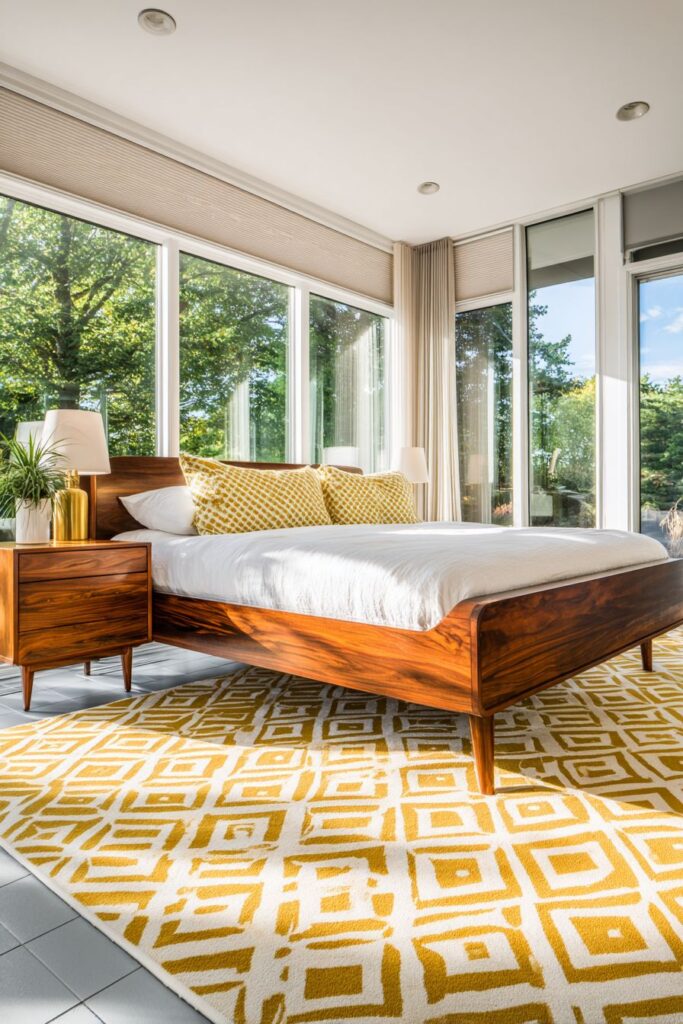
Key Design Tips:
- Select a platform bed with visible wood grain and tapered legs to establish authentic mid-century character
- Invest in matching bedroom furniture pieces to create cohesion while allowing each item to showcase its individual design merit
- Choose area rugs with geometric patterns in warm, saturated colors like mustard yellow, burnt orange, or teal to add visual interest at floor level
- Opt for minimal window treatments that maximize natural light while maintaining clean architectural lines
- Use brass hardware and accents sparingly to add warmth and period-appropriate detail
2. Olive Green Feature Wall With Teak Storage
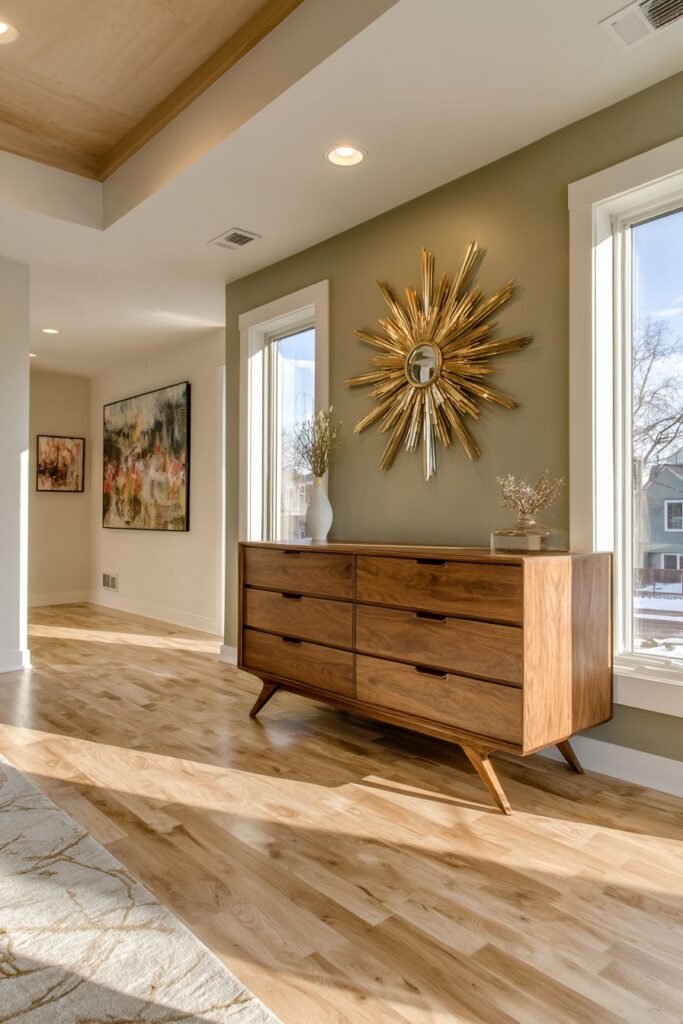
A sophisticated mid-century bedroom can be achieved through the strategic use of color, as demonstrated by a feature wall painted in warm olive green that serves as the perfect backdrop for a distinctive teak dresser with angled legs and recessed drawer handles. This earthy green hue was a favorite of mid-century designers, offering enough visual interest to create a focal point without overwhelming the space with excessive color. The teak dresser, with its rich reddish-brown tones and distinctive grain patterns, stands as a sculptural piece against this verdant backdrop, its angled legs providing the signature mid-century silhouette.
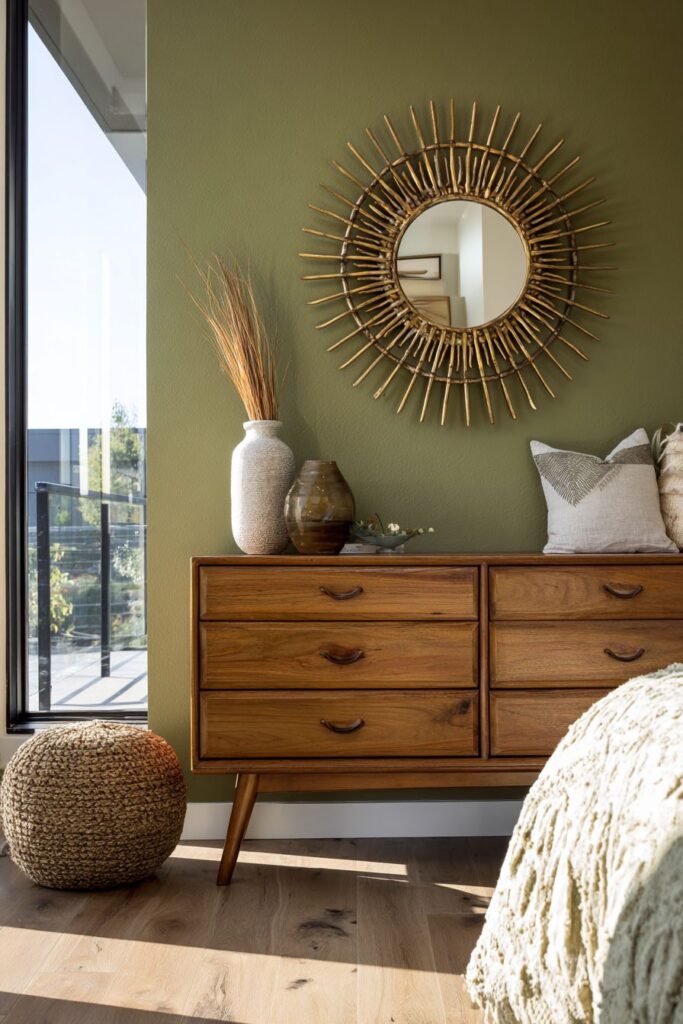
Above the dresser, a sunburst mirror in brass finish becomes a striking decorative element that serves both aesthetic and functional purposes. This iconic mirror design, with its radiating spokes resembling sun rays, captures and disperses natural daylight from nearby windows throughout the room, creating dynamic light patterns that change throughout the day. The brass finish echoes the warm metallic accents found in the dresser hardware, creating a cohesive material story that ties the vignette together.
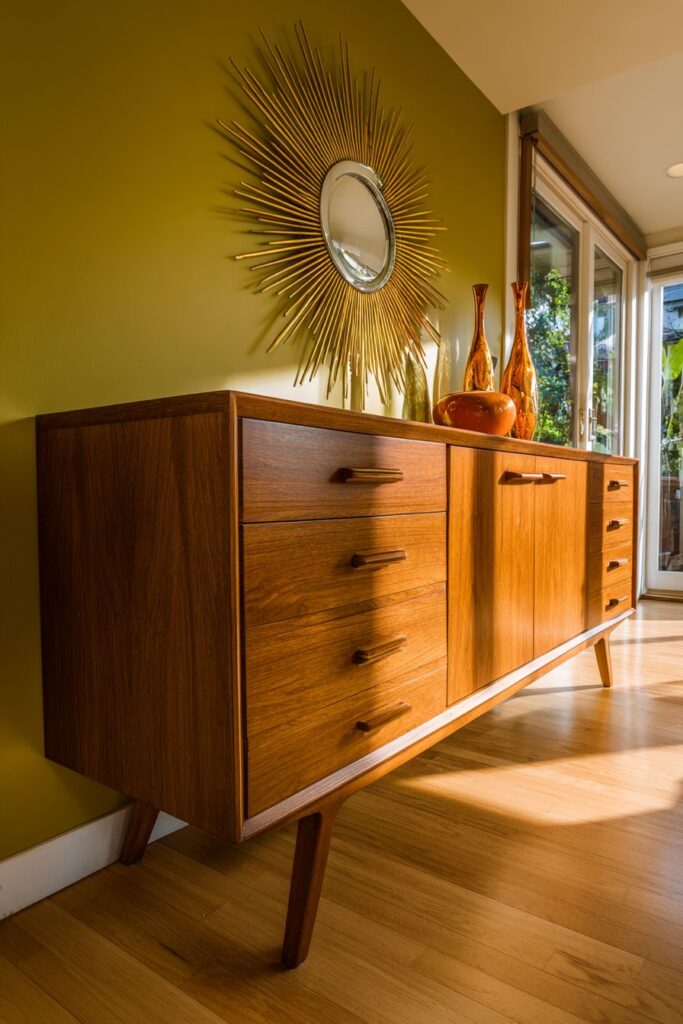
The flooring features light oak hardwood with visible grain patterns, providing a neutral foundation that allows the olive green wall and teak furniture to take center stage. This layering of wood tones—from the light oak floors to the medium teak dresser—demonstrates the mid-century mastery of working with natural materials in varying shades and species. The sophisticated color palette of warm earth tones creates a bedroom environment that feels both grounded and elevated, perfect for rest and rejuvenation.
Professional styling of this space emphasizes the authentic mid-century furniture pieces, allowing each element to contribute to the overall composition without cluttering the visual field. The recessed drawer handles on the dresser exemplify the era’s attention to streamlined details, where even the hardware becomes an integrated part of the furniture’s design rather than an afterthought.
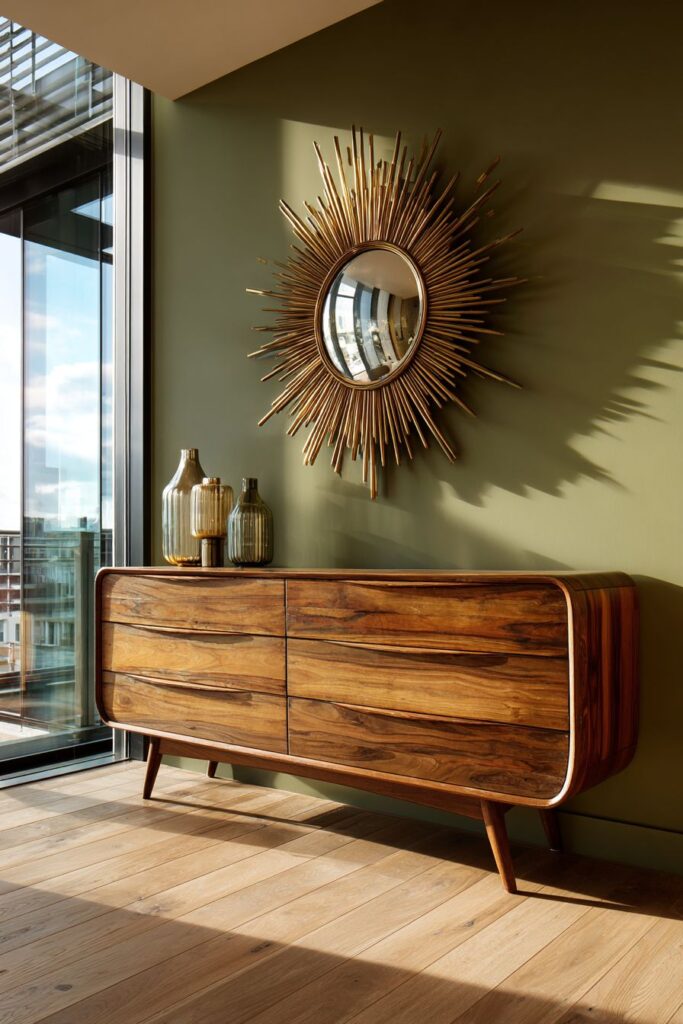
Key Design Tips:
- Paint one feature wall in warm olive green, sage, or another earth-tone color to create depth without overwhelming the space
- Invest in authentic teak furniture with angled legs and integrated hardware for genuine mid-century appeal
- Hang a sunburst mirror as a focal point that doubles as functional decor and light amplification
- Choose light-colored hardwood flooring to provide a neutral base that showcases furniture and accent colors
- Layer different wood tones thoughtfully, ensuring each species contributes to the overall warmth and visual interest
3. Indoor-Outdoor Integration With Teak Paneling
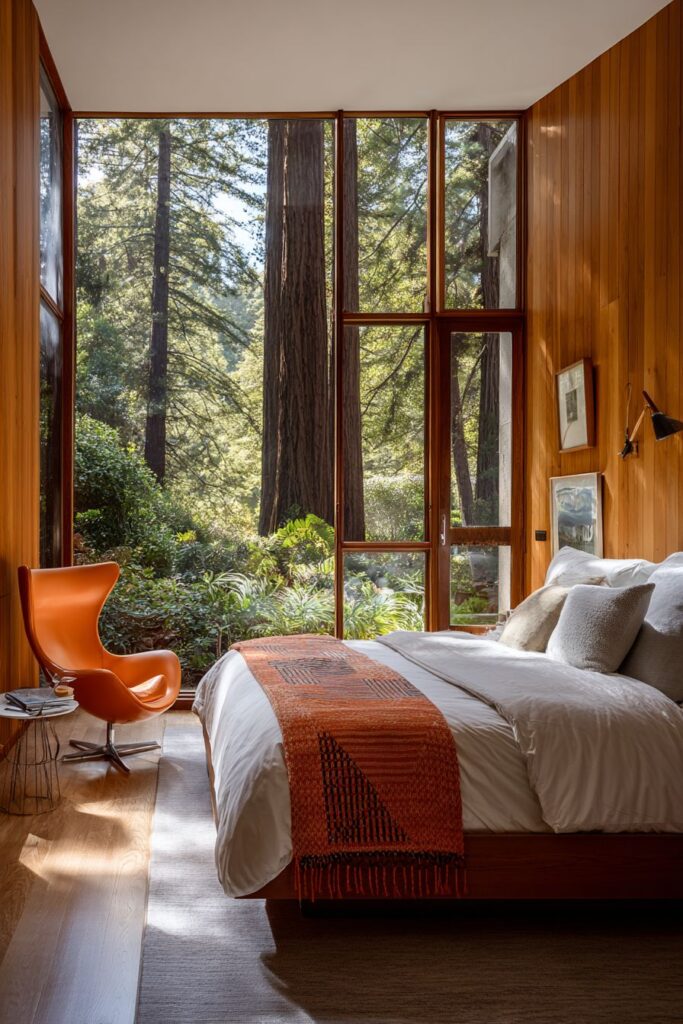
The mid-century modern movement revolutionized how we think about the relationship between interior and exterior spaces, and nowhere is this more beautifully demonstrated than in a bedroom featuring floor-to-ceiling windows framed by teak paneling. This architectural approach creates a seamless visual flow that blurs the boundaries between inside and outside, allowing occupants to feel connected to nature even while enjoying indoor comfort. The teak paneling adds warmth and organic texture while framing the expansive glass like a work of art, turning the outdoor view into a living mural that changes with the seasons and time of day.
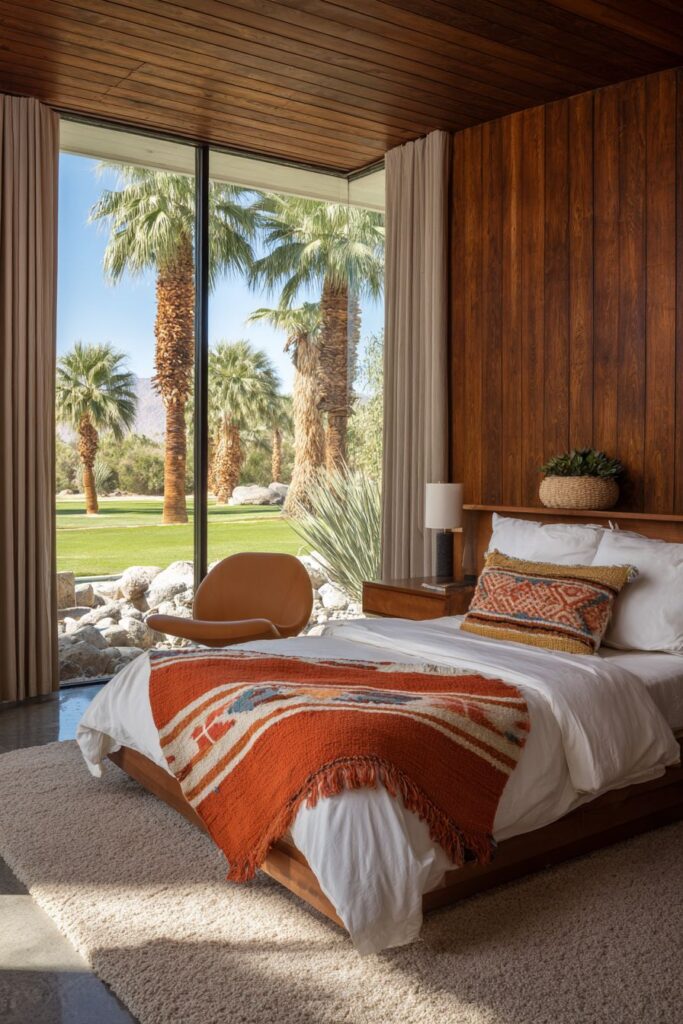
The room’s furnishings embrace simplicity with a platform bed dressed in crisp white linens that provide a clean, fresh foundation. An orange wool throw blanket with geometric patterns introduces a pop of the era’s beloved bold color, folded casually at the foot of the bed to suggest both comfort and careful styling. This juxtaposition of pure white and vibrant orange demonstrates the mid-century ability to balance restraint with moments of playful expression, creating visual interest without abandoning the overall minimalist aesthetic.
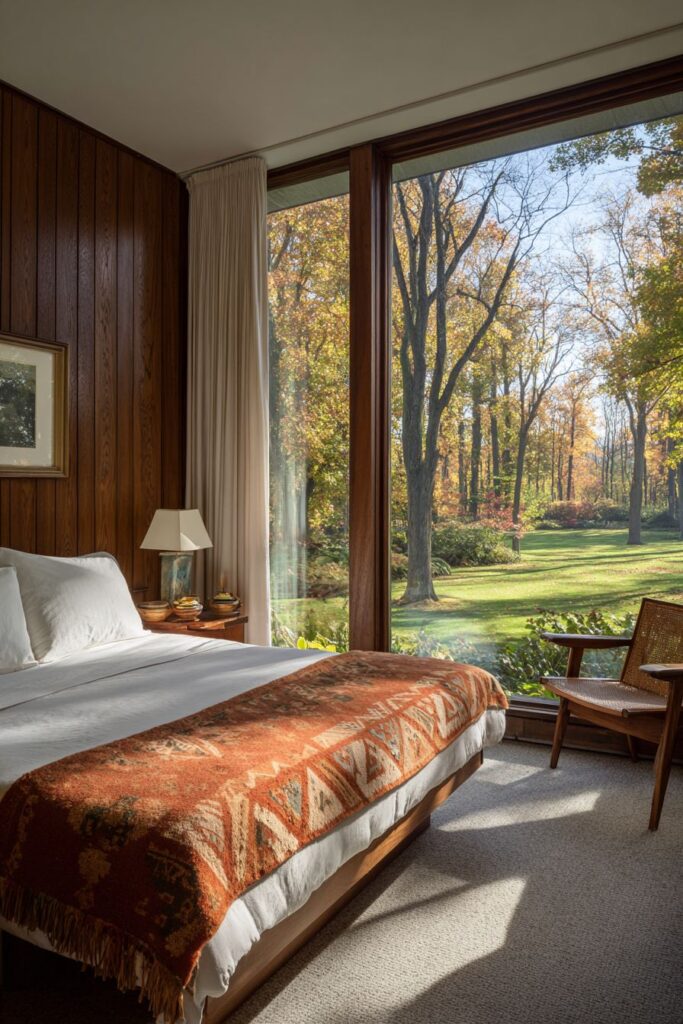
A molded fiberglass lounge chair sits in the corner near the window, representing the era’s embrace of innovative materials and manufacturing processes. This iconic furniture piece, with its sculptural curves and modern materials, serves as both functional seating and artistic statement. Natural morning light floods the space, highlighting the clean architectural lines and creating a sense of openness that makes the bedroom feel larger and more connected to the world beyond its walls.
The functional modernist aesthetic on display here prioritizes honest materials, purposeful design, and an uncluttered environment that allows each element to be appreciated on its own merits. The absence of heavy curtains or elaborate window treatments keeps the focus on the architecture itself and the natural beauty visible through the glass.
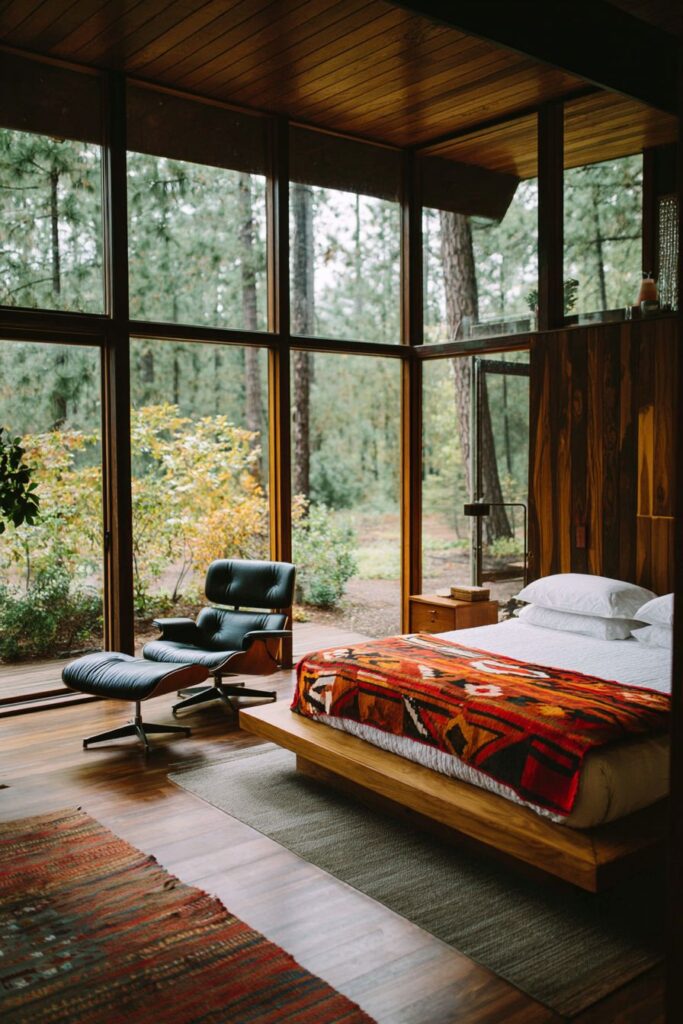
Key Design Tips:
- Maximize natural light with large windows or glass doors that connect the bedroom to outdoor views
- Frame windows with wood paneling in teak or walnut to add warmth while highlighting architectural features
- Keep bedding simple with white or neutral linens, adding color through throws and accent pillows
- Incorporate iconic mid-century furniture pieces like molded fiberglass or plastic chairs for authentic period appeal
- Maintain minimal window treatments to preserve the indoor-outdoor connection and maximize daylight
4. Reading Nook With Rosewood Lounge Chair
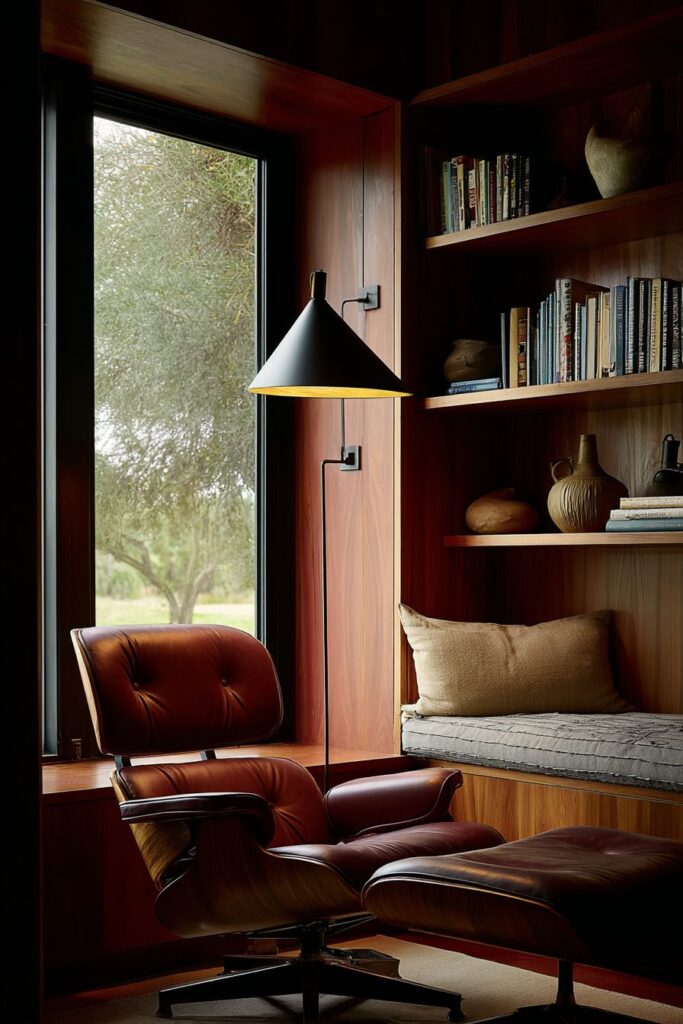
Every mid-century bedroom benefits from a dedicated space for relaxation beyond sleep, and a thoughtfully designed reading nook exemplifies how functional areas can be integrated seamlessly into the sleeping quarters. Positioned by a large picture window to capture natural light, an iconic leather and rosewood lounge chair with ottoman creates an inviting retreat for quiet contemplation and literature. This legendary furniture piece, with its carefully calculated ergonomics and luxurious materials, represents the pinnacle of mid-century furniture design where comfort and aesthetics achieve perfect balance.
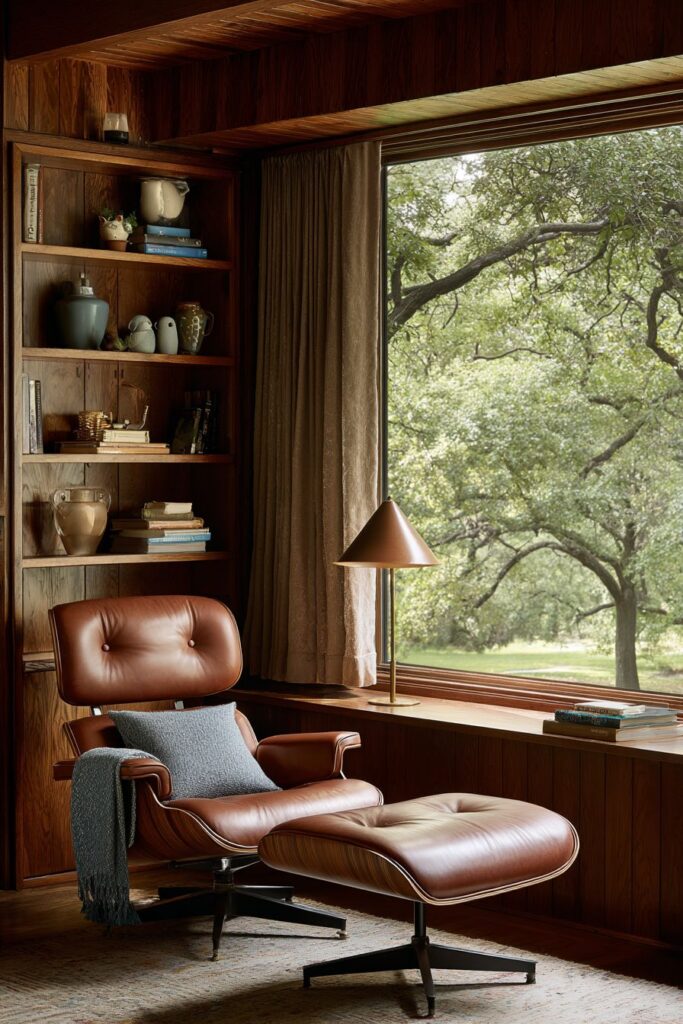
A slender floor lamp with a conical shade provides focused reading light for evening hours, its minimalist form complementing rather than competing with the lounge chair’s sculptural presence. The lamp’s placement is strategic—close enough to illuminate reading material effectively while maintaining a sense of openness in the corner space. Built-in walnut shelving displays vintage books and ceramic accessories, transforming functional storage into a curated display that reflects personal interests and adds visual warmth through the natural wood tones.
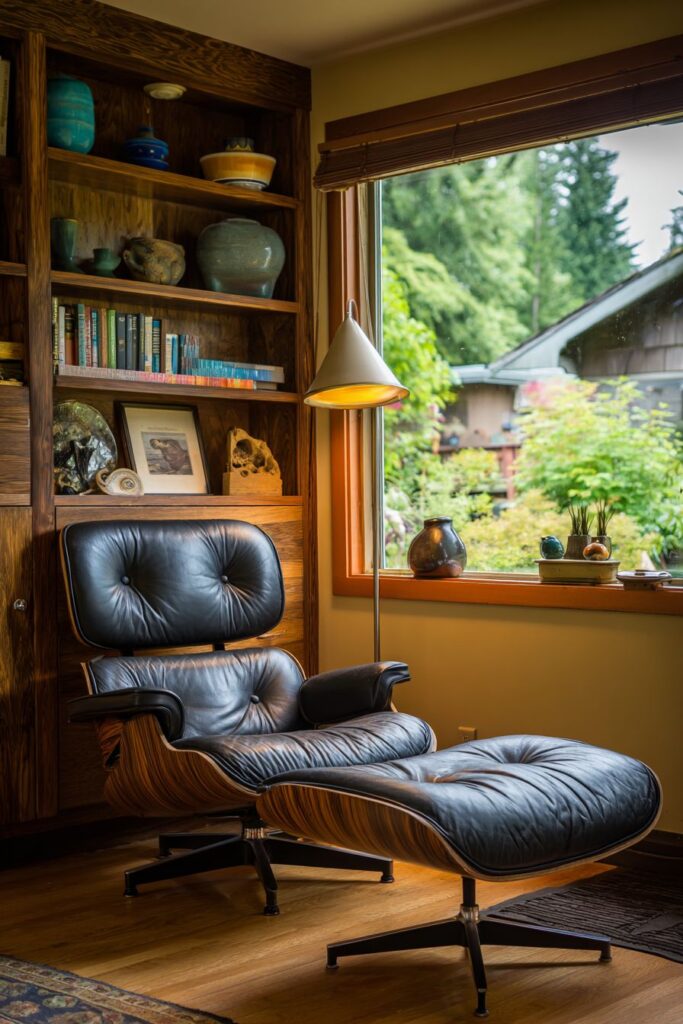
The practical integration of functional furniture demonstrates the mid-century commitment to thoughtful space planning, where every square foot serves a purpose without feeling cramped or overcrowded. The shelving’s clean lines and warm walnut finish provide both storage capacity and aesthetic appeal, housing a collection that adds personality to the space while maintaining the overall design cohesion. Ceramic accessories in period-appropriate glazes and forms add textural variety and subtle color accents that enhance without overwhelming.
Natural shadows and texture details visible in this vignette create depth and visual interest, showing how mid-century design embraces the play of light and shadow as integral design elements. The warm, lived-in quality of authentic mid-century design comes through in the careful layering of functional pieces, comfortable seating, and personal collections that make the space feel genuinely inhabited rather than staged.
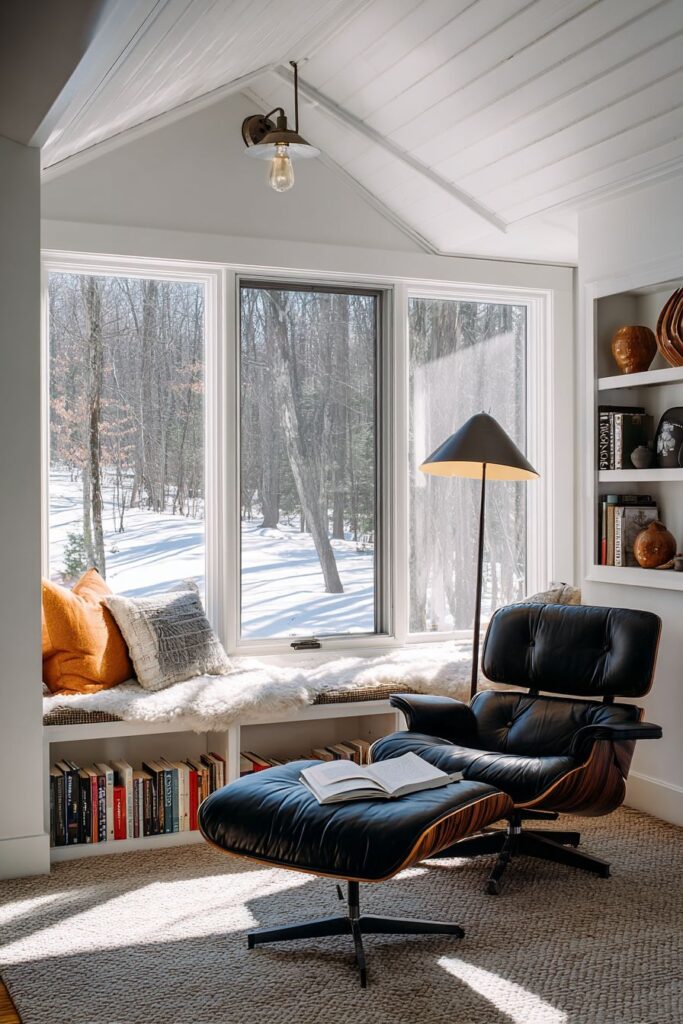
Key Design Tips:
- Create a dedicated reading area with an iconic lounge chair and ottoman positioned near natural light sources
- Install built-in shelving in walnut or teak to maximize storage while adding architectural interest
- Choose a slender floor lamp with directional lighting for functional task illumination without visual bulk
- Display books and decorative objects that reflect personal interests while maintaining the mid-century aesthetic
- Position furniture to take advantage of natural light during the day while ensuring adequate task lighting for evening use
5. Dramatic Globe Pendant Lighting
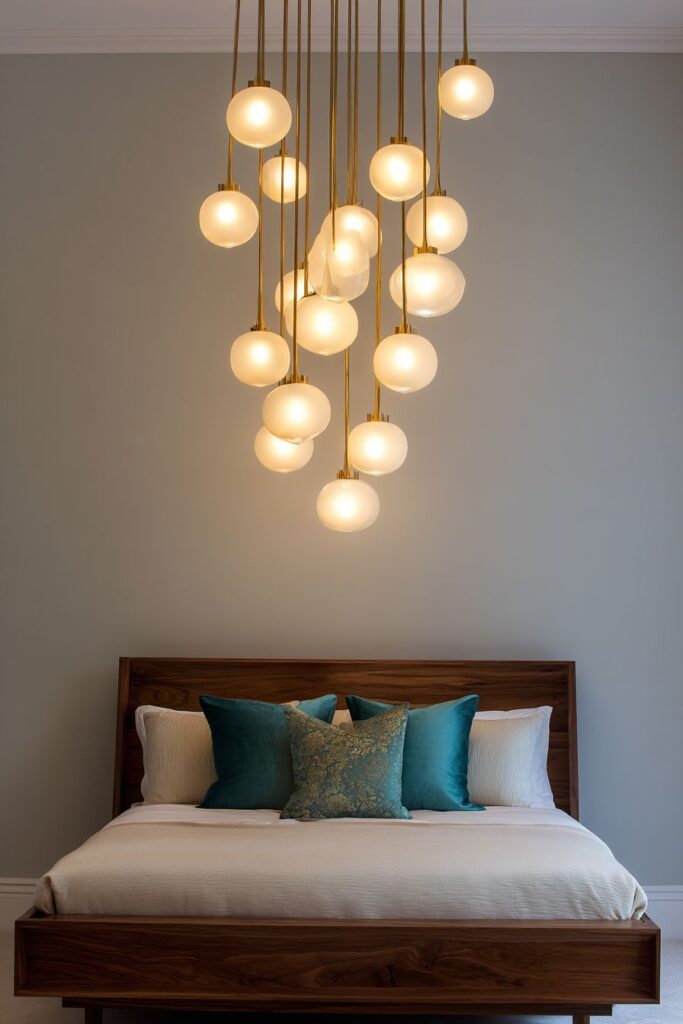
Lighting serves as both functional necessity and sculptural art in mid-century design, exemplified by a statement lighting fixture featuring multiple globe pendants in brass and frosted glass suspended at varying heights above the bed. This dramatic arrangement creates visual interest through its asymmetrical composition while providing ambient illumination that can be adjusted for different moods and activities. The combination of warm brass metalwork and soft frosted glass diffuses light gently throughout the room, avoiding harsh shadows while creating a sophisticated glow that enhances the bedroom’s atmosphere.
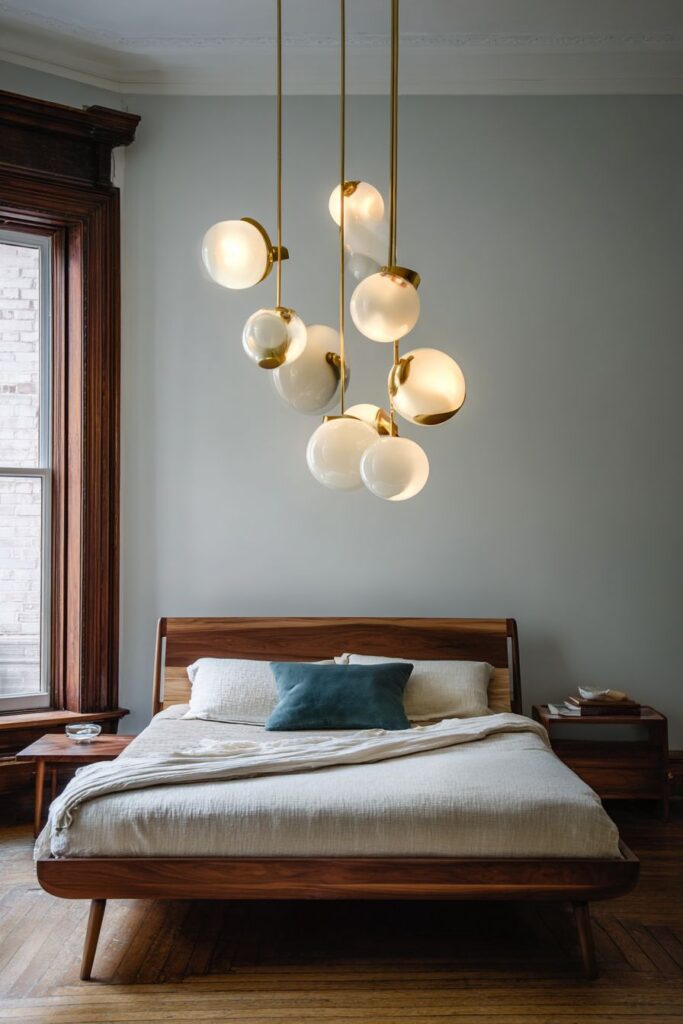
The bed frame beneath this lighting showcase is crafted from solid walnut with minimal detailing, allowing the spectacular overhead fixture to command attention without competition from overly ornate furniture. Dressed in neutral linens with a teal accent pillow, the bed provides a calm foundation that supports rather than distracts from the room’s focal point. This restraint in bedding choices demonstrates the mid-century principle that bold statements work best when balanced with simpler supporting elements.
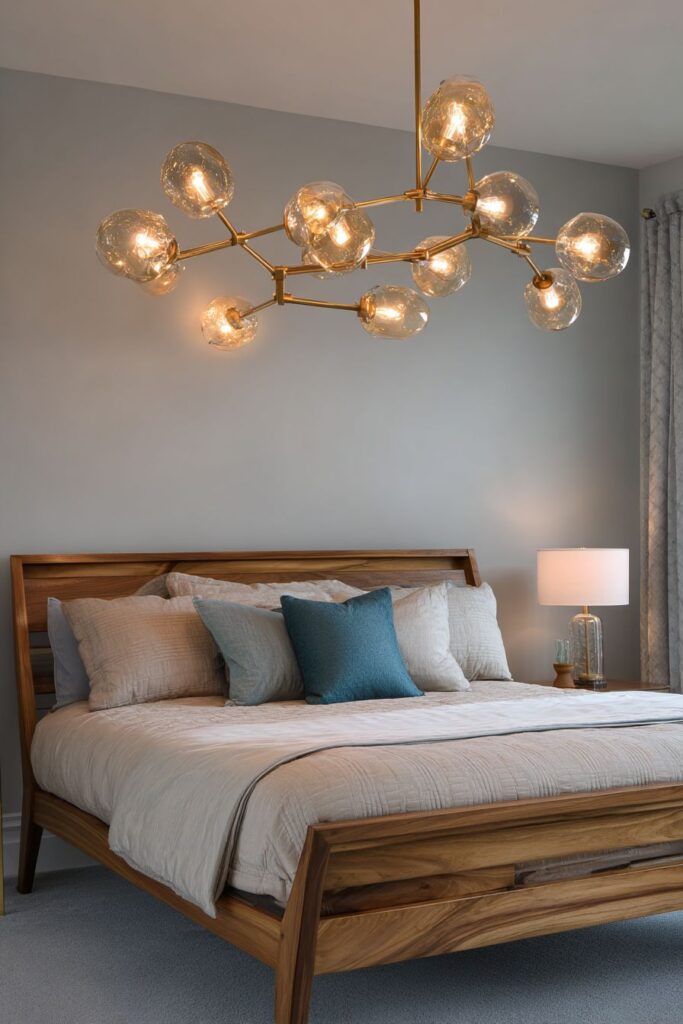
Light grey walls provide a subtle backdrop that allows both the dramatic lighting and warm wood furniture to stand out, creating depth through tonal variation rather than contrasting colors. This sophisticated neutral palette serves as a perfect canvas for the interplay of light and shadow created by the globe pendants, with the frosted glass creating soft pools of illumination that overlap and blend at different heights.
The functional aspect of this lighting design cannot be overlooked—by suspending pendants at various heights, the fixture provides both ambient room lighting and more focused illumination over the bed for reading or other activities. This layered approach to lighting reflects the mid-century understanding that good design must serve practical needs while elevating the everyday experience of inhabiting a space.
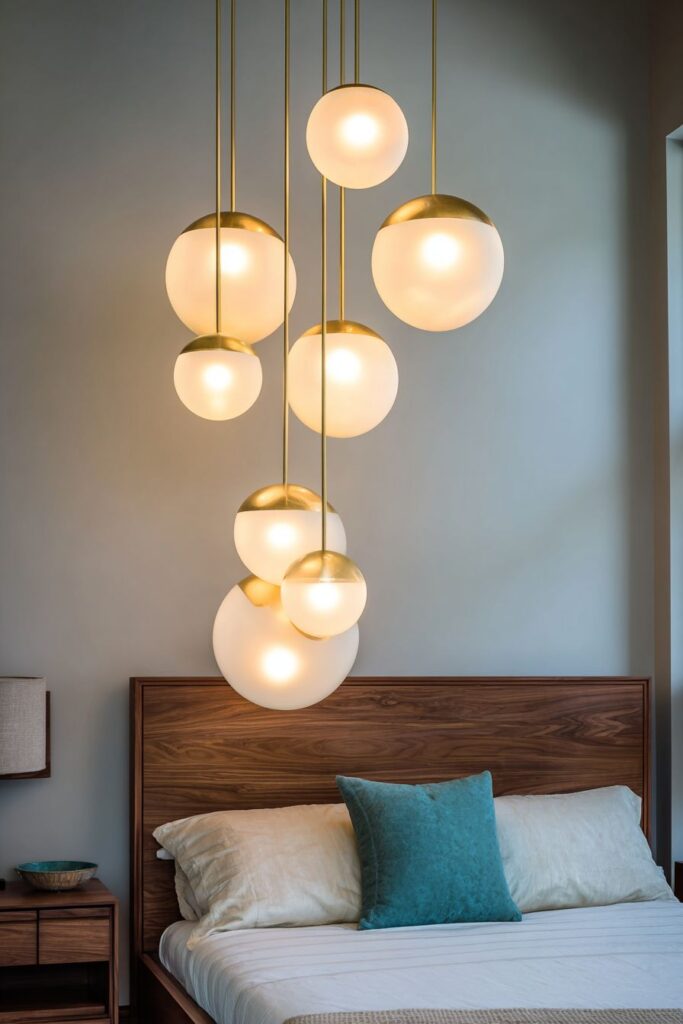
Key Design Tips:
- Choose statement lighting with multiple elements at varying heights to create visual drama and functional versatility
- Select fixtures combining brass and frosted glass for authentic mid-century appeal and soft light diffusion
- Keep bed frames simple with minimal detailing when featuring dramatic overhead lighting
- Use neutral wall colors as a backdrop that allows lighting fixtures and furniture to take center stage
- Layer ambient and task lighting to create flexibility for different times of day and activities
6. Built-In Teak Storage Wall
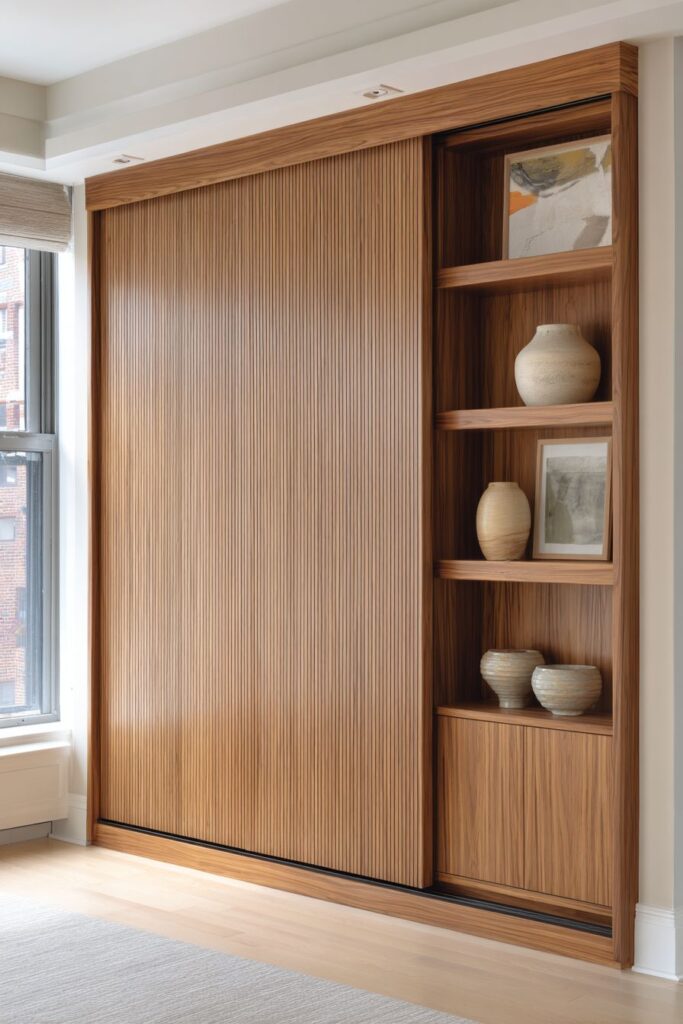
The mid-century approach to storage combines aesthetic beauty with practical capacity, demonstrated perfectly by a full wall of built-in teak cabinetry featuring sliding panel doors with vertical grain patterns. This custom millwork represents the era’s commitment to craftsmanship and attention to detail, where even utilitarian storage becomes an opportunity for design excellence. The sliding doors, with their pronounced vertical grain, create visual height and elegance while concealing everyday items that might otherwise create visual clutter.
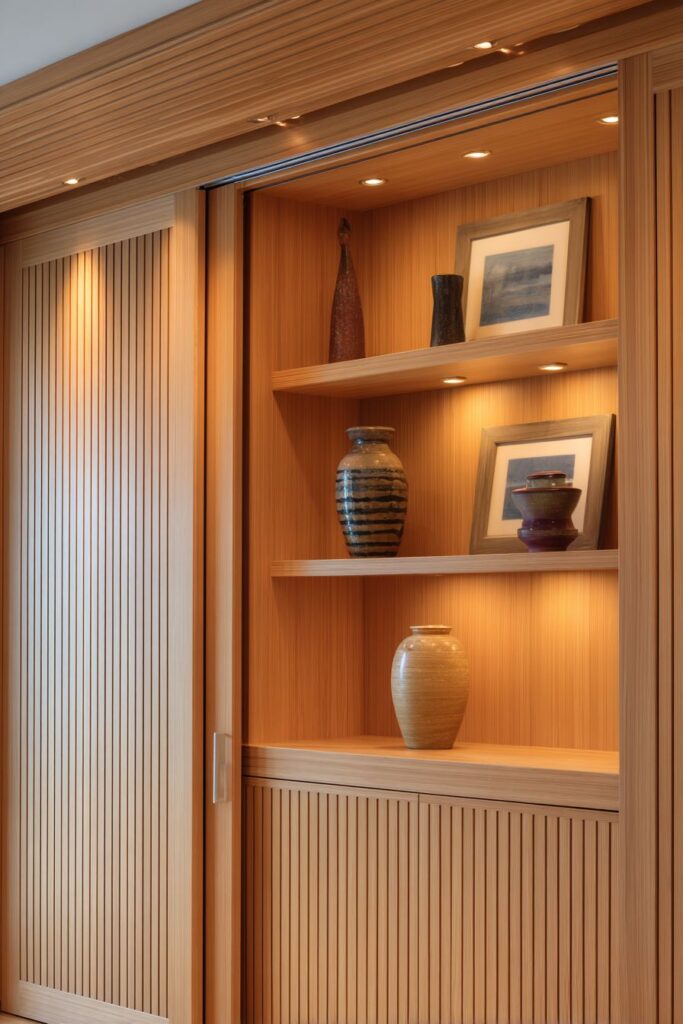
Open display shelves integrated within the cabinetry showcase period-appropriate ceramic vases and abstract art pieces, transforming the storage wall into a curated gallery that reflects personal taste while maintaining the clean aesthetic lines characteristic of mid-century design. These open sections provide visual relief from the expanse of closed cabinetry, creating rhythm and balance through the alternation of concealed and displayed items. The ceramic vases, with their distinctive mid-century glazes and organic forms, add color and sculptural interest to the composition.
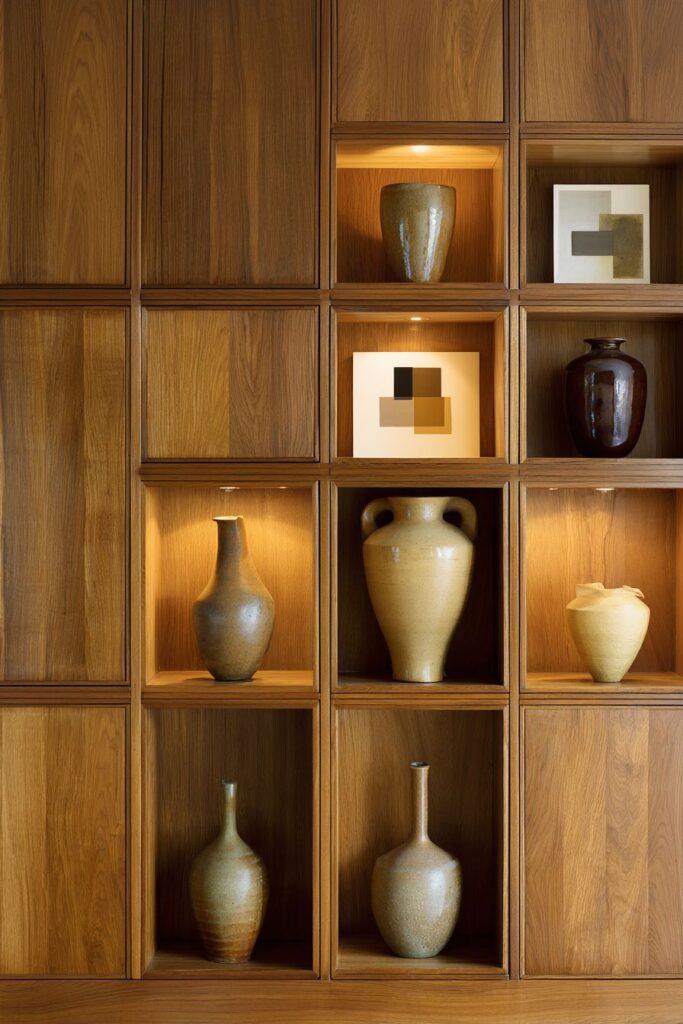
Recessed lighting within the shelving highlights the warm wood tones and displayed objects, creating depth and drama while serving the practical purpose of illuminating the storage area. This integrated lighting approach demonstrates the mid-century mastery of combining form and function, where even lighting fixtures become part of the architectural fabric rather than afterthoughts. The soft glow from within the shelving creates an inviting warmth that makes the storage wall feel like a living element of the room rather than a static backdrop.
The craftsmanship evident in this built-in solution—from the precision joinery to the carefully selected wood grain patterns—exemplifies why mid-century furniture and millwork remain highly valued today. The practical storage capacity, achieved without sacrificing aesthetic appeal, shows how thoughtful design can address real-world needs while creating spaces of enduring beauty.
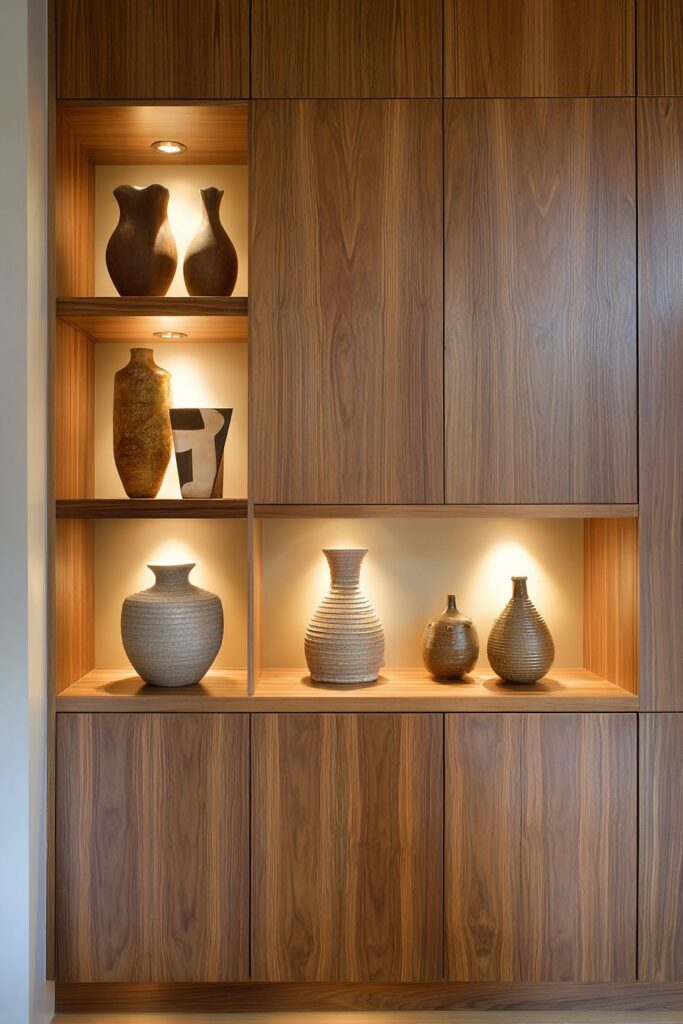
Key Design Tips:
- Invest in built-in storage with sliding doors to maximize capacity while maintaining clean lines
- Choose teak or walnut cabinetry with vertical grain patterns for visual height and authentic mid-century character
- Incorporate open shelving sections within closed storage to display curated objects and create visual rhythm
- Install recessed lighting within shelving to highlight wood tones and displayed items
- Select period-appropriate accessories like ceramic vases and abstract art to enhance the mid-century aesthetic
7. Integrated Workspace Solution
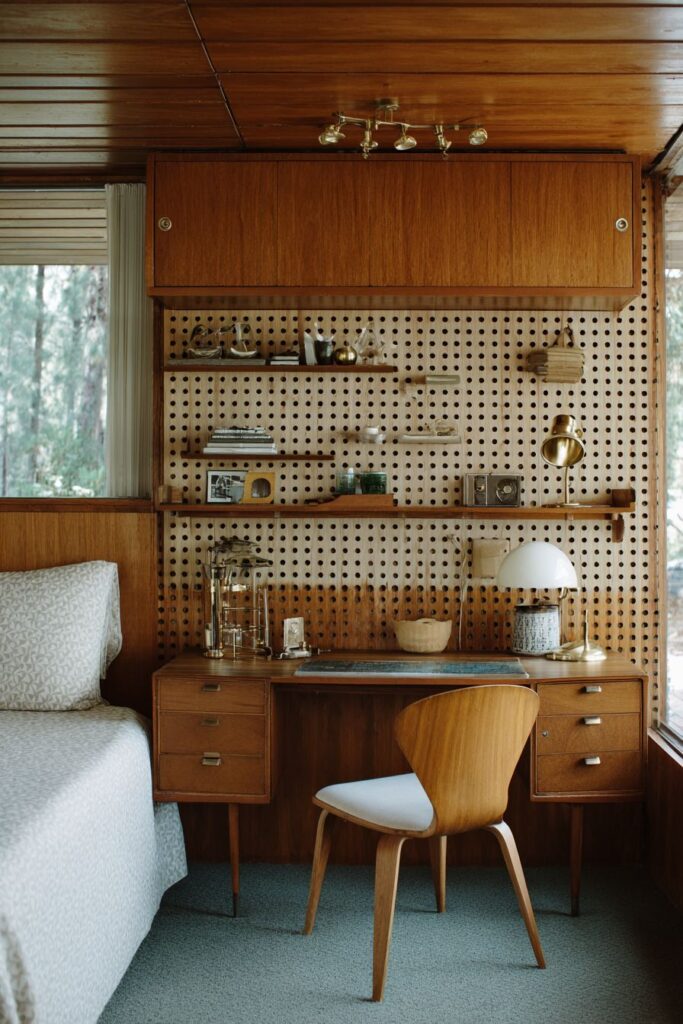
The mid-century era pioneered multifunctional living spaces, and a bedroom workspace demonstrates how sleeping and working areas can coexist harmoniously without compromising either function. A compact teak desk with tapered legs integrates seamlessly into the bedroom environment, its warm wood tones and clean lines complementing rather than clashing with bedroom furniture. Paired with a molded plywood chair that combines organic curves with modern materials, this workspace exemplifies the era’s innovative approach to furniture design and space utilization.
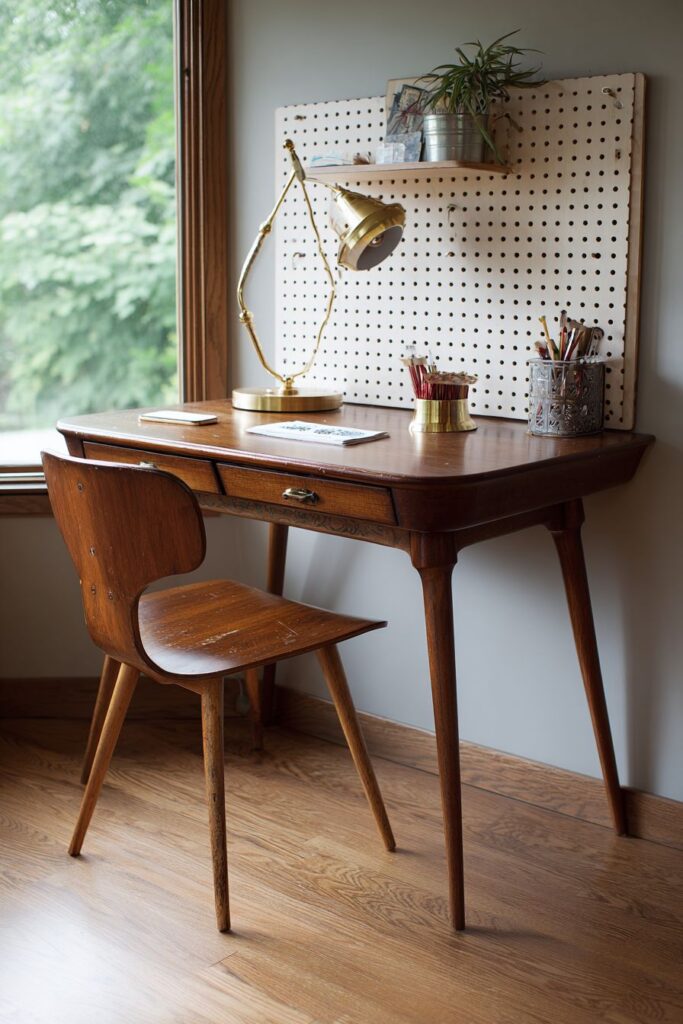
The desk surface displays a vintage desk lamp with brass accents that provides focused task lighting while serving as a decorative element that reinforces the mid-century aesthetic. Minimal office accessories keep the workspace uncluttered, reflecting the design philosophy that less is more when every item is chosen with care. Natural wood pegboard mounted above the desk provides organized storage for frequently used items, turning functional necessity into an attractive wall treatment that adds texture and visual interest.
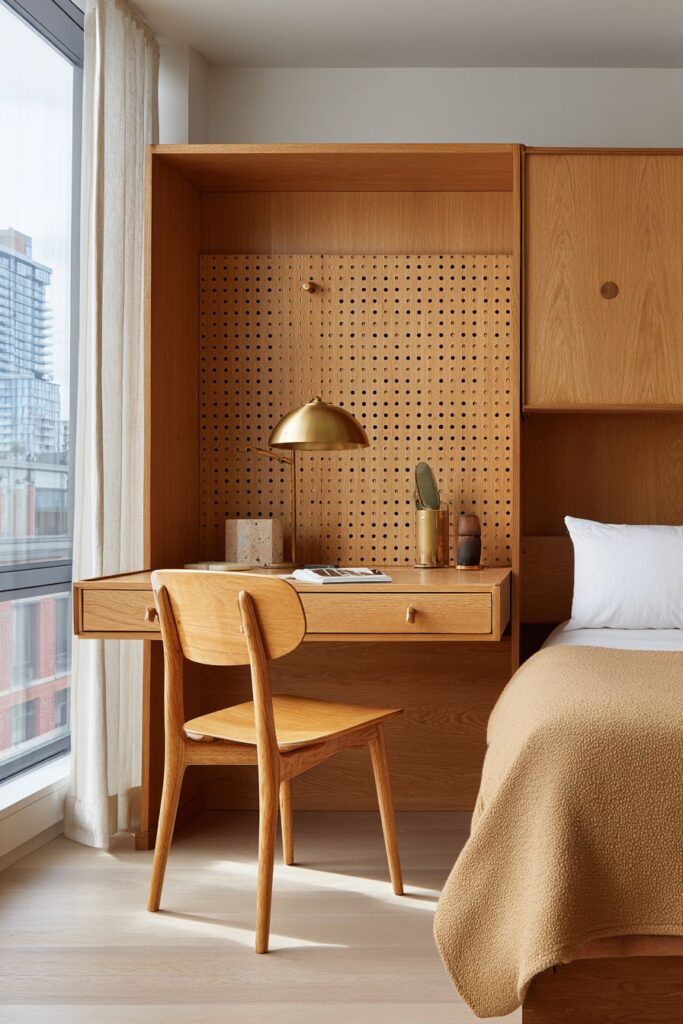
Natural lighting from a nearby window creates soft shadows on the desk surface, reducing eye strain during daytime work while connecting the workspace to the rhythm of natural day. This efficient use of space and multifunctional design approach shows how even modest-sized bedrooms can accommodate diverse activities without feeling cramped or chaotic. The tapered legs on both desk and chair maintain visual lightness, preventing the furniture from overwhelming the room despite its functional presence.
The integration of work and rest spaces reflects contemporary living patterns where home offices have become increasingly important, proving that mid-century design principles remain relevant for modern needs. By choosing furniture scaled appropriately for bedroom use and maintaining the overall aesthetic cohesion, the workspace becomes a natural extension of the room rather than an awkward addition.
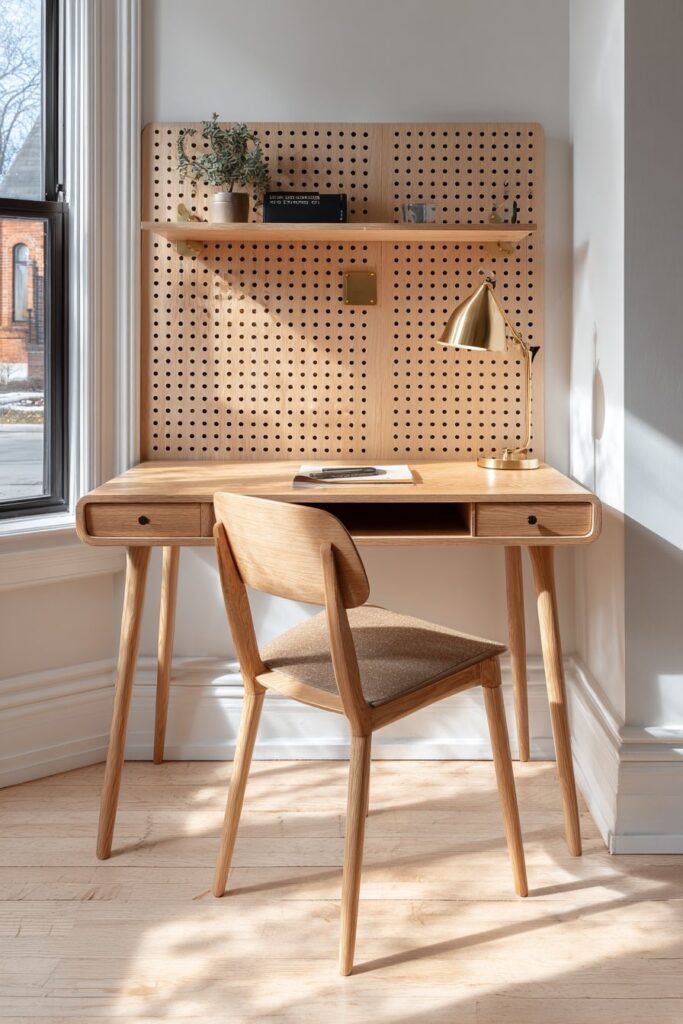
Key Design Tips:
- Select a compact desk with tapered legs that complements bedroom furniture in both scale and style
- Choose a molded plywood or similar mid-century chair that provides comfort without visual bulk
- Install pegboard or wall-mounted organizers to maximize vertical storage and minimize desk clutter
- Position the workspace near windows to take advantage of natural light during daytime hours
- Keep desk accessories minimal and period-appropriate to maintain aesthetic cohesion with the bedroom
8. Textured Wood Slat Wall Treatment
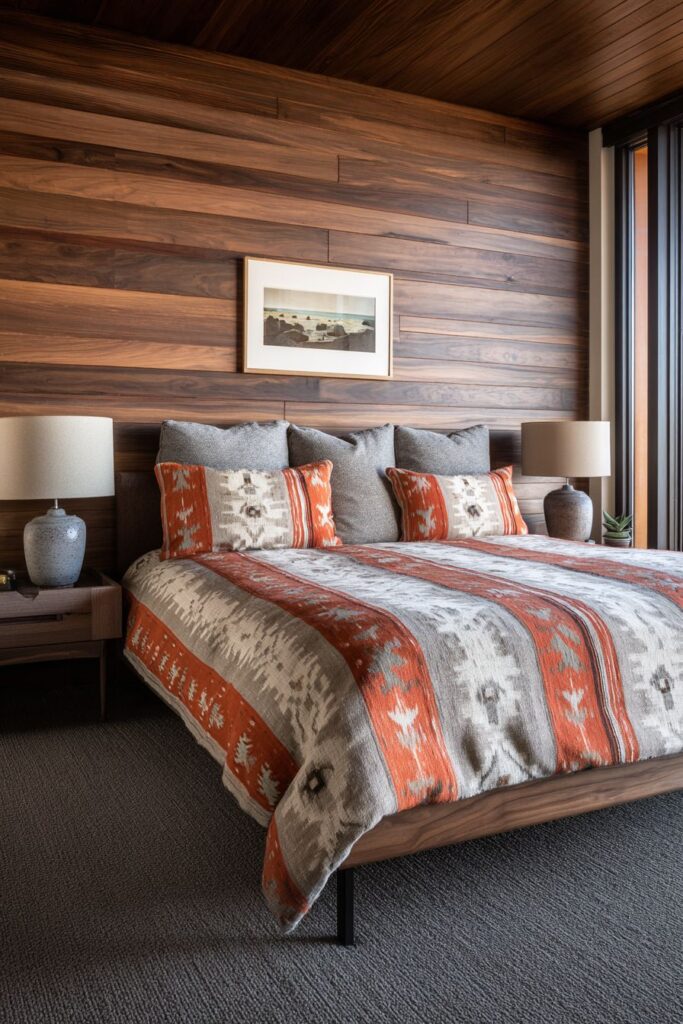
Texture plays a crucial role in mid-century bedroom design, and horizontal wood slat paneling in warm walnut tones creates stunning visual interest behind the bed while adding depth and dimension to the space. This architectural treatment transforms a simple wall into a sophisticated focal point that draws the eye and anchors the room’s design. The horizontal orientation of the slats creates a sense of width and calm, while the warm walnut tones introduce organic richness that makes the bedroom feel more inviting and grounded.
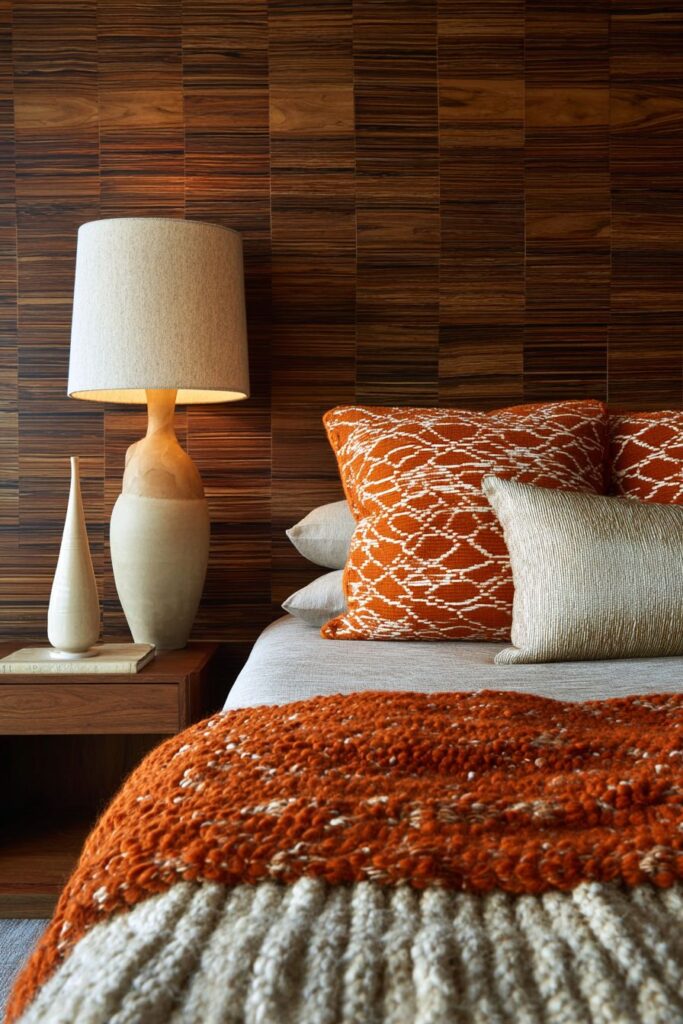
The bedding includes a handwoven coverlet in burnt orange and cream geometric patterns that echoes the linear quality of the wall treatment while introducing the era’s beloved warm color palette. This layering of geometric patterns—from the architectural slats to the textile design—demonstrates the mid-century fascination with abstract forms and mathematical proportions. The handwoven quality adds artisanal texture that contrasts beautifully with the precision of the wood paneling, creating a sophisticated interplay between crafted and manufactured elements.
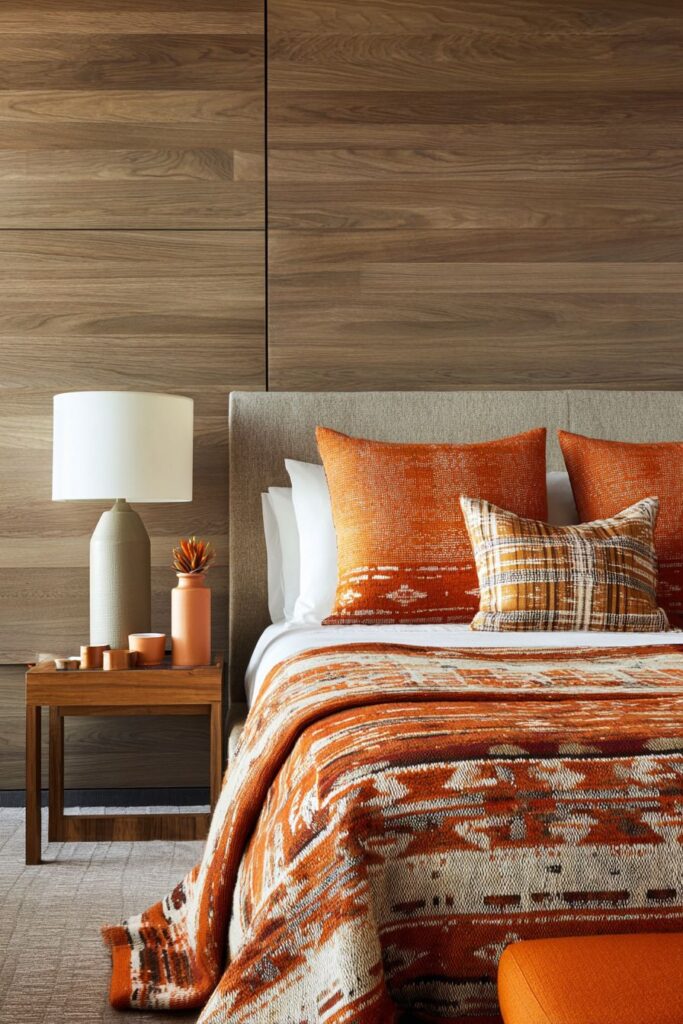
Low-profile nightstands flank the bed, their simple forms allowing the dramatic wall treatment to remain the focal point. Ceramic table lamps with tapered bases sit atop these nightstands, their sculptural silhouettes adding vertical interest without competing with the horizontal emphasis of the slat wall. The lamps’ simple, elegant forms exemplify mid-century lighting design where functionality and beauty merge seamlessly.
The sophisticated layering of wood textures—from the smooth nightstand surfaces to the dimensional wall slats—creates depth and visual complexity while maintaining the clean aesthetic that defines mid-century style. Natural materials dominate the palette, from the walnut wood to the ceramic lamps to the woven textile, demonstrating the era’s preference for honest, organic elements over synthetic alternatives.
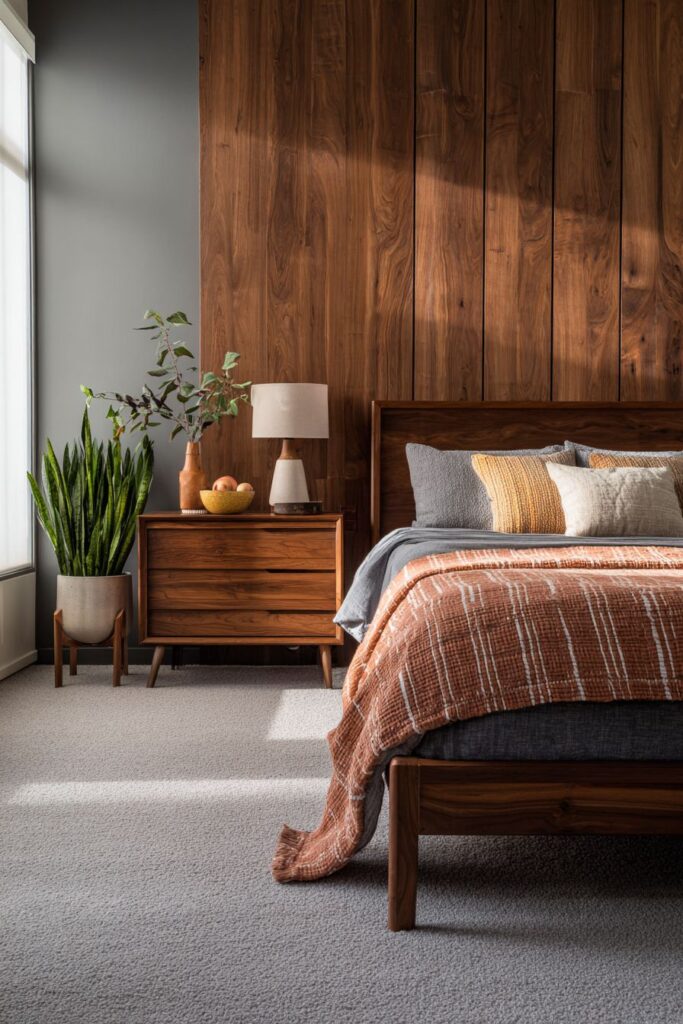
Key Design Tips:
- Install horizontal wood slat paneling behind the bed to create an architectural focal point with textural depth
- Choose warm wood species like walnut or teak that add richness without darkening the space
- Layer geometric patterns through textiles that complement rather than compete with architectural elements
- Select low-profile nightstands that support but don’t distract from dramatic wall treatments
- Use ceramic table lamps with simple tapered bases for authentic mid-century lighting that adds sculptural interest
9. Terrazzo Flooring With Indoor-Outdoor Flow

Original terrazzo flooring represents the height of mid-century material innovation, with subtle color flecks in grey, pink, and gold creating a sophisticated speckled surface that serves as both foundation and focal point. This durable, beautiful flooring choice exemplifies the era’s appreciation for materials that combine practicality with aesthetic appeal, requiring minimal maintenance while providing timeless visual interest. Partially covered by a flatweave rug with abstract patterns, the terrazzo remains visible at the room’s perimeter, allowing its distinctive character to contribute to the overall design.
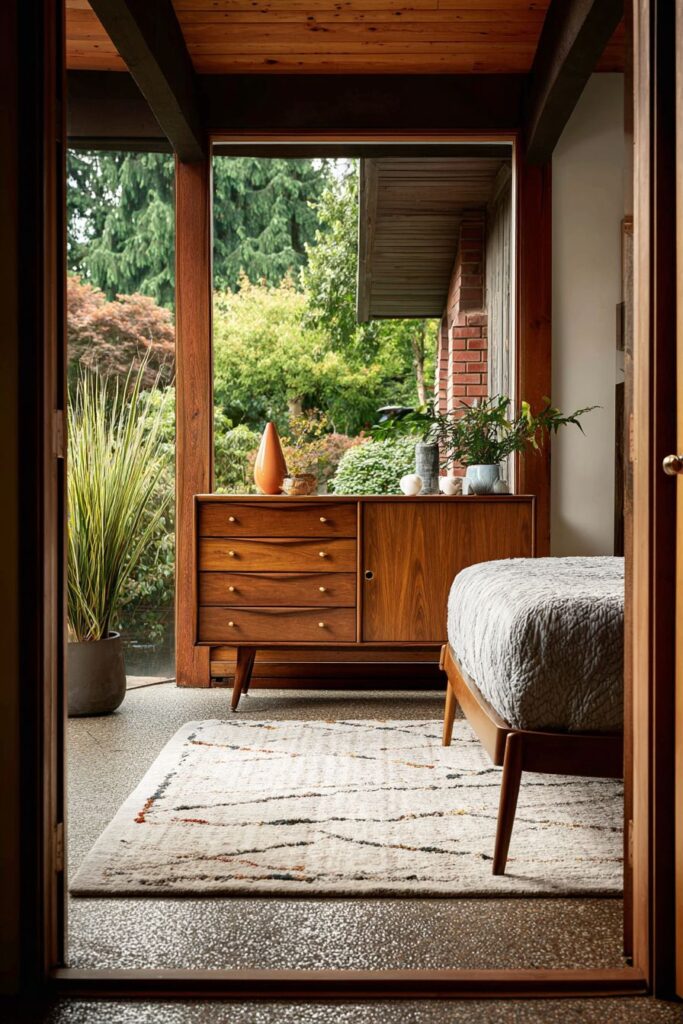
The furniture selection includes a spindle-leg bed frame that appears to float above the terrazzo floor, its slender vertical supports creating an airy, delicate silhouette that contrasts beautifully with the solid flooring beneath. A credenza-style dresser in rich teak provides substantial storage while maintaining the clean lines and organic warmth characteristic of mid-century case goods. The combination of these authentic period pieces against the terrazzo flooring creates a cohesive mid-century environment that feels both curated and comfortable.
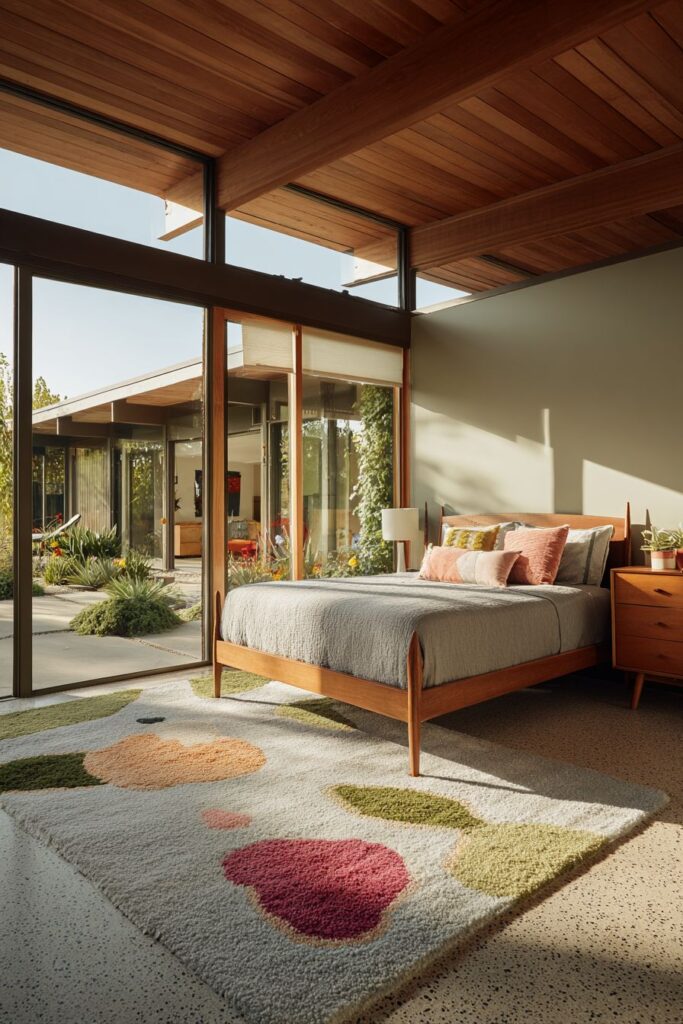
Large sliding glass doors open to an outdoor patio, creating a seamless flow between interior and exterior spaces that defines mid-century indoor-outdoor living. The terrazzo flooring extends this connection, its speckled surface resembling natural stone and creating visual continuity between the controlled interior environment and the organic outdoor setting. Natural daylight streaming through the glass doors illuminates the terrazzo’s subtle color variations, creating a dynamic floor surface that changes appearance throughout the day.
The authentic period materials on display—from the terrazzo flooring to the teak furniture to the natural fiber rug—demonstrate the mid-century commitment to quality craftsmanship and honest material expression. Each element contributes to a cohesive whole that celebrates the beauty of well-chosen materials and thoughtful composition.
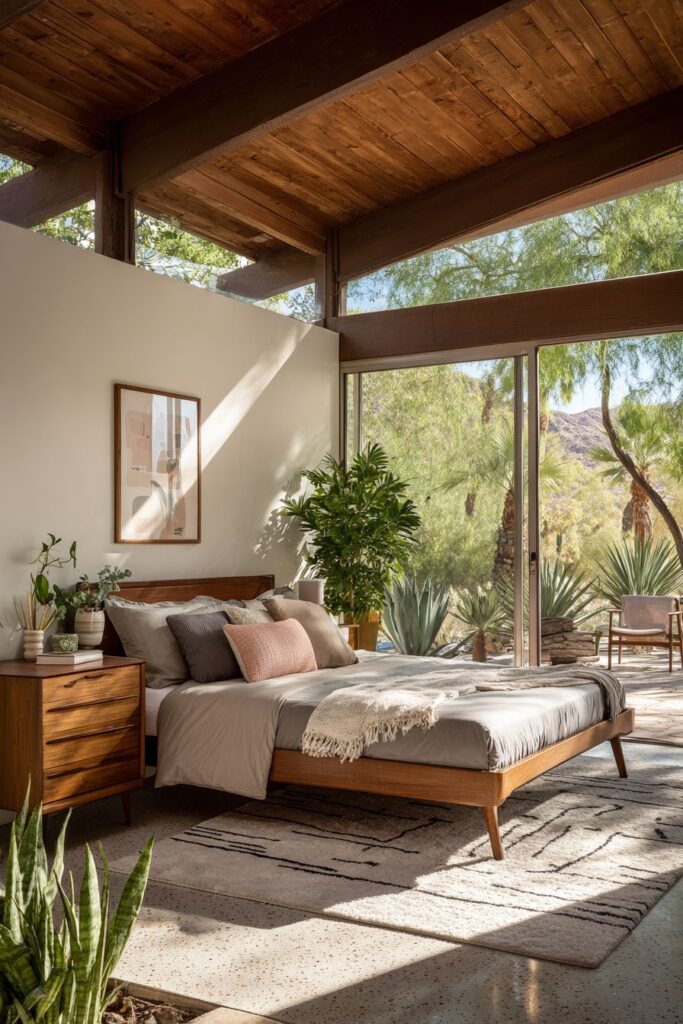
Key Design Tips:
- Consider terrazzo or similar speckled flooring for authentic mid-century appeal and timeless durability
- Choose furniture with spindle or tapered legs that appear to float above decorative flooring
- Install sliding glass doors to create seamless indoor-outdoor flow and maximize natural light
- Layer flatweave rugs over hard flooring to define spaces while allowing flooring to remain partially visible
- Select furniture in rich teak or walnut to create warmth against cool terrazzo tones
10. Curated Gallery Wall Display
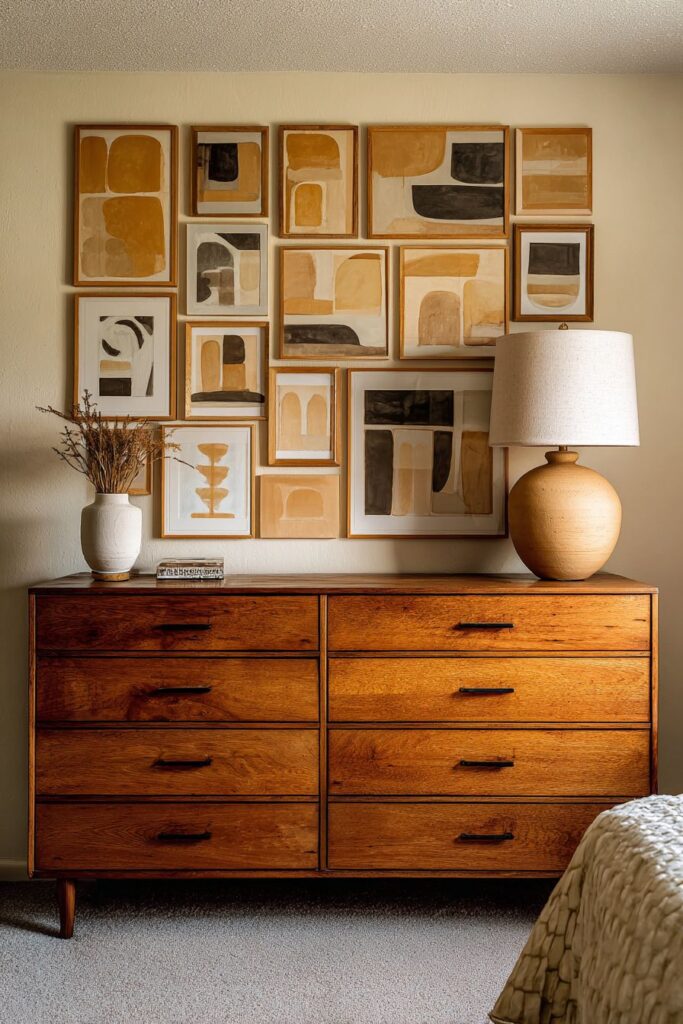
The mid-century approach to wall art emphasizes curation and composition, as demonstrated by a gallery wall featuring abstract art prints in wooden frames with clean lines, arranged in an asymmetric but balanced composition above a low rosewood dresser. This carefully orchestrated display transforms a simple wall into a dynamic focal point that reflects personal taste while honoring the era’s aesthetic principles. The wooden frames, with their simple profiles and warm tones, unite diverse artworks into a cohesive collection that feels intentional rather than haphazard.
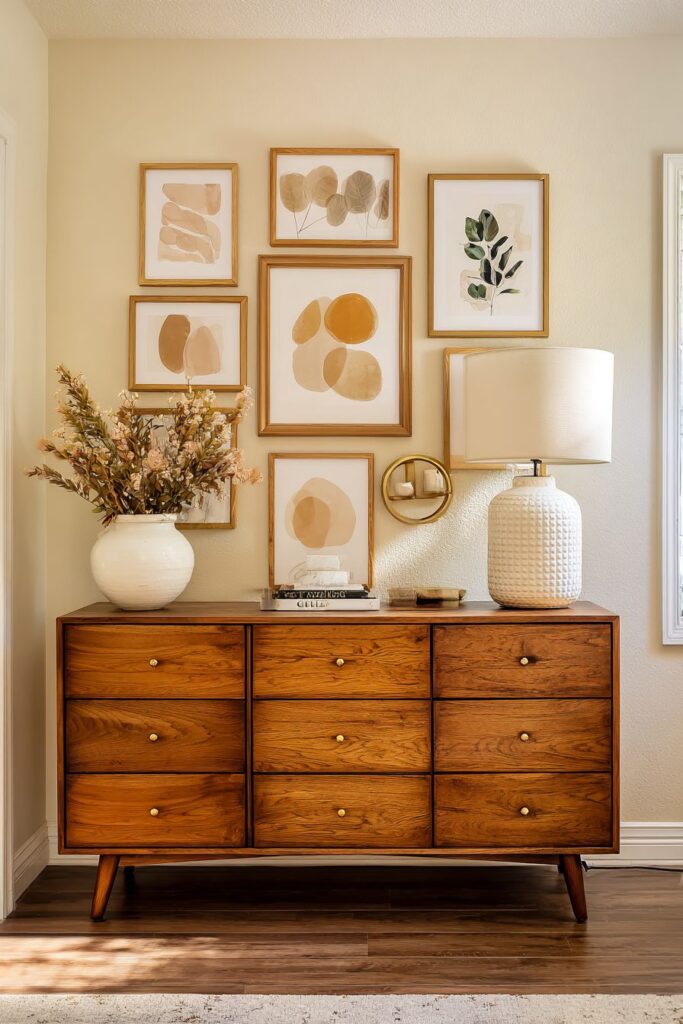
The abstract art prints themselves embody mid-century artistic sensibilities, with their focus on form, color, and composition rather than representational imagery. This artistic yet minimal approach to wall decor demonstrates how personal expression can be achieved within the constraints of a defined design aesthetic. The asymmetric arrangement creates visual interest and movement, guiding the eye across the wall in a deliberate pattern that feels organic rather than rigidly structured.
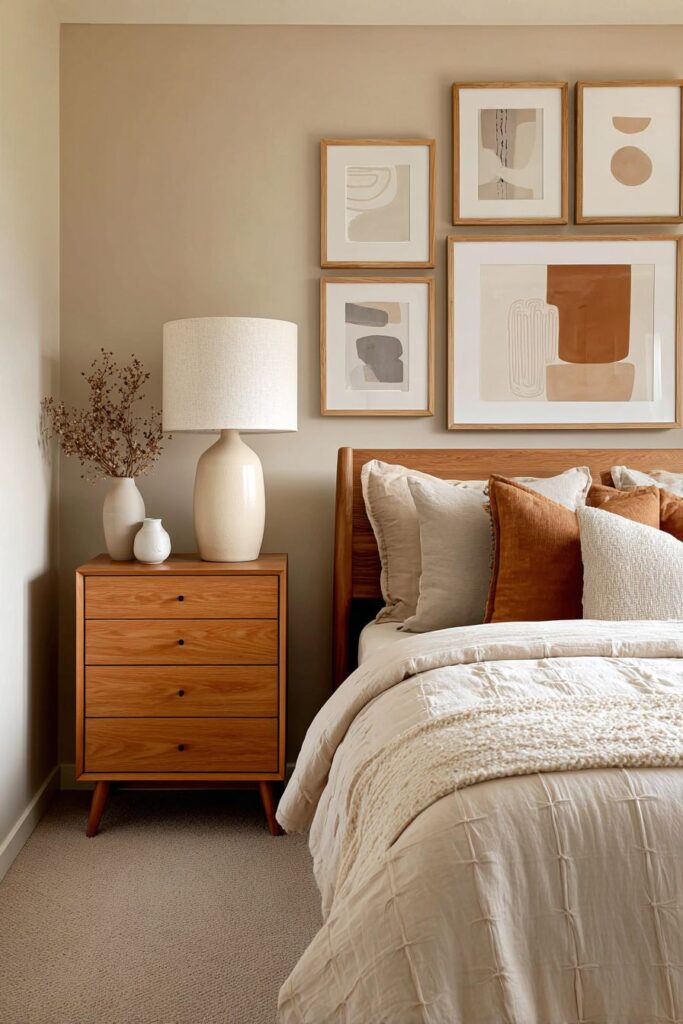
A ceramic table lamp with a linen drum shade sits on the rosewood dresser below, its warm glow highlighting the artwork above during evening hours while serving as a sculptural element in its own right. The lamp’s simple cylindrical form and natural linen shade exemplify mid-century lighting design, where understated elegance takes precedence over ornamental excess. The walls are painted in a warm cream color that provides a neutral backdrop allowing the artwork and furniture to command attention.
Soft natural lighting highlights the varied textures within the composition—from the smooth rosewood surface to the woven linen lampshade to the subtle texture of the art prints themselves. This layering of textures within a restrained color palette creates depth and interest without visual chaos, demonstrating the mid-century mastery of achieving complexity through simplicity.
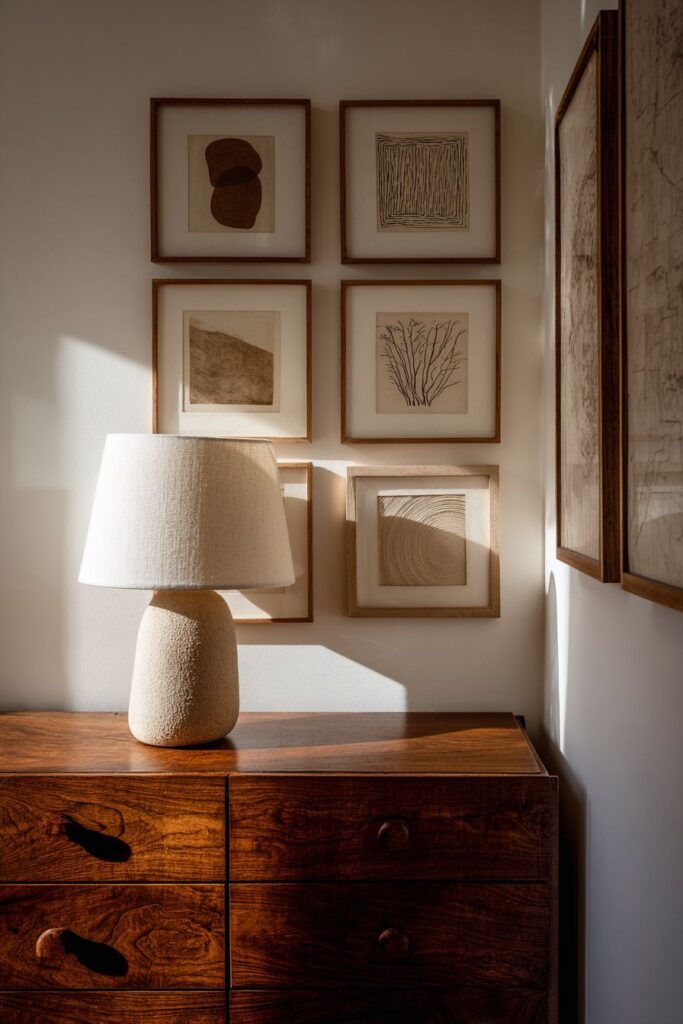
Key Design Tips:
- Create gallery walls with abstract art in simple wooden frames for authentic mid-century character
- Arrange artwork asymmetrically but maintain overall balance for dynamic visual interest
- Choose low-profile furniture like rosewood dressers to provide a foundation without competing with wall displays
- Use table lamps with linen drum shades for soft, even lighting that highlights artwork
- Paint walls in warm cream or neutral tones to provide a subtle backdrop for art and furniture
11. Mustard Yellow Upholstered Headboard
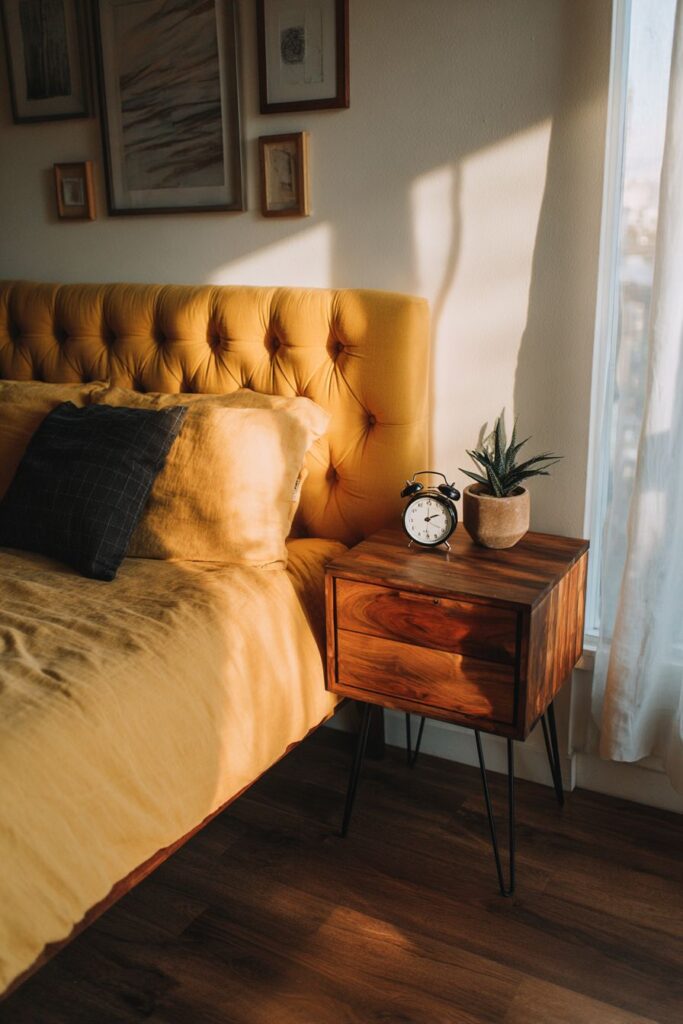
Bold color applied strategically can transform a mid-century bedroom, as exemplified by a tufted headboard upholstered in mustard yellow linen fabric with visible texture. This vibrant accent piece introduces the era’s beloved warm color palette while providing soft padding and visual comfort for the bed. Paired with a simple walnut bed frame, the headboard demonstrates how a single colorful element can energize an entire space without overwhelming the senses. The tufting adds subtle geometric patterning and dimensional interest to the otherwise smooth fabric surface.
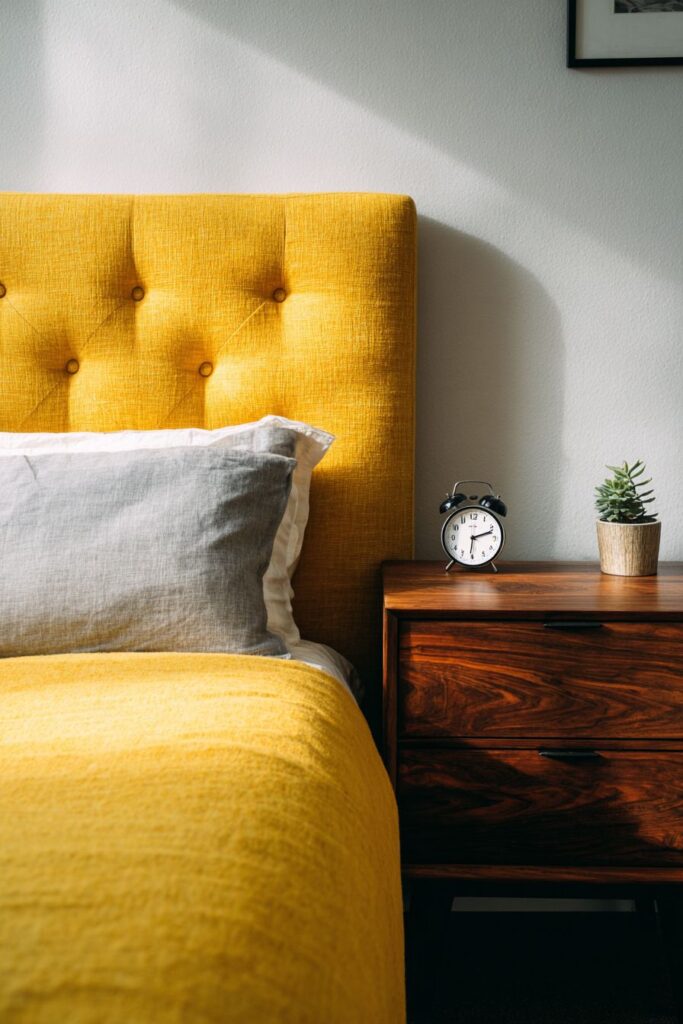
The nightstands showcase distinctive hairpin legs in black metal with walnut tops, representing the mid-century embrace of mixed materials and industrial-inspired design elements. These iconic tripod supports create an almost impossibly delicate appearance, making the nightstands seem to defy gravity while providing stable, functional surfaces. The contrast between the thin black metal legs and rich walnut tops creates visual interest through material juxtaposition, a hallmark of mid-century design innovation.
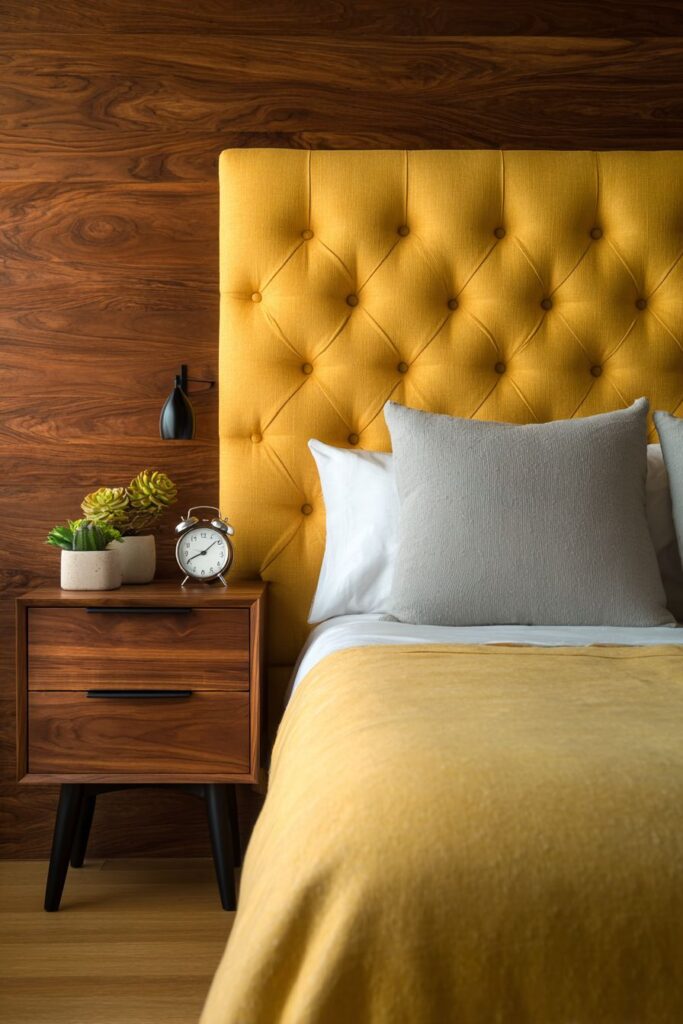
Styling touches include a vintage alarm clock and small potted succulent that provide personality without cluttering the clean surfaces. These carefully chosen accessories reflect the mid-century appreciation for objects that combine beauty and function—the alarm clock serves a practical purpose while its vintage design contributes to the overall aesthetic, and the succulent brings living greenery into the space with minimal maintenance requirements.
Golden hour sunlight creates warm ambient tones that make the mustard yellow headboard glow, demonstrating how mid-century design works in harmony with natural light to create dynamic, ever-changing spaces. The characteristic blend of organic materials like wood and linen with manufactured elements like metal hairpin legs exemplifies the era’s innovative approach to furniture design and material combination.
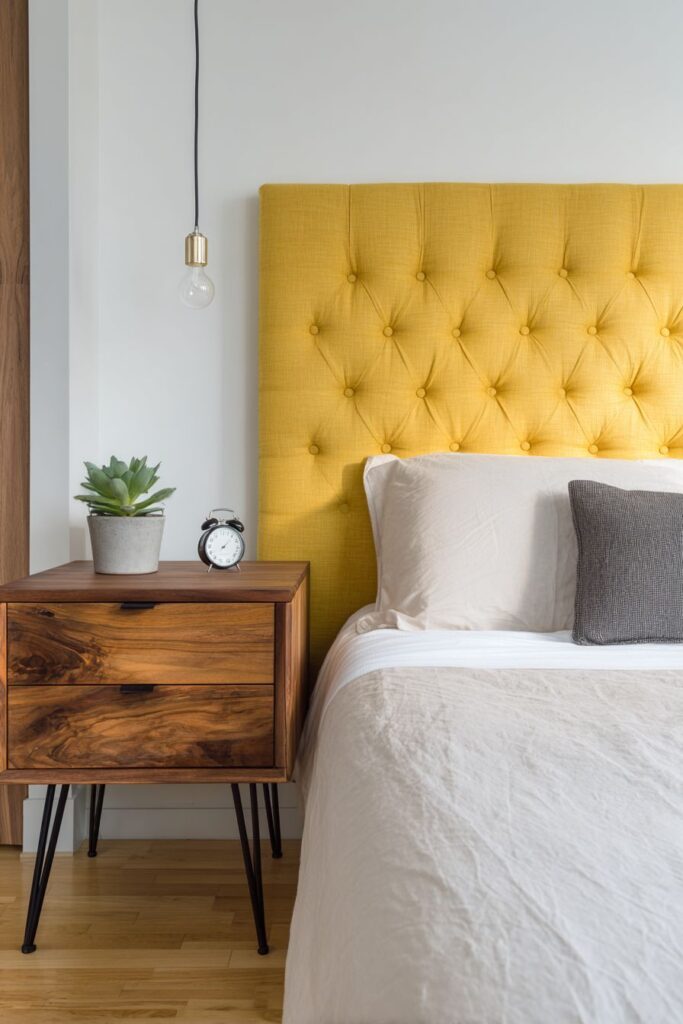
Key Design Tips:
- Upholster headboards in bold mid-century colors like mustard yellow, burnt orange, or teal for dramatic focal points
- Choose tufted designs that add textural interest and dimensional pattern to fabric surfaces
- Select nightstands with hairpin legs for authentic mid-century industrial aesthetic and visual lightness
- Mix materials like wood, metal, and fabric to create the characteristic mid-century blend of organic and manufactured
- Style nightstands with minimal accessories that combine function and decorative appeal
12. Corner Dressing Area Integration
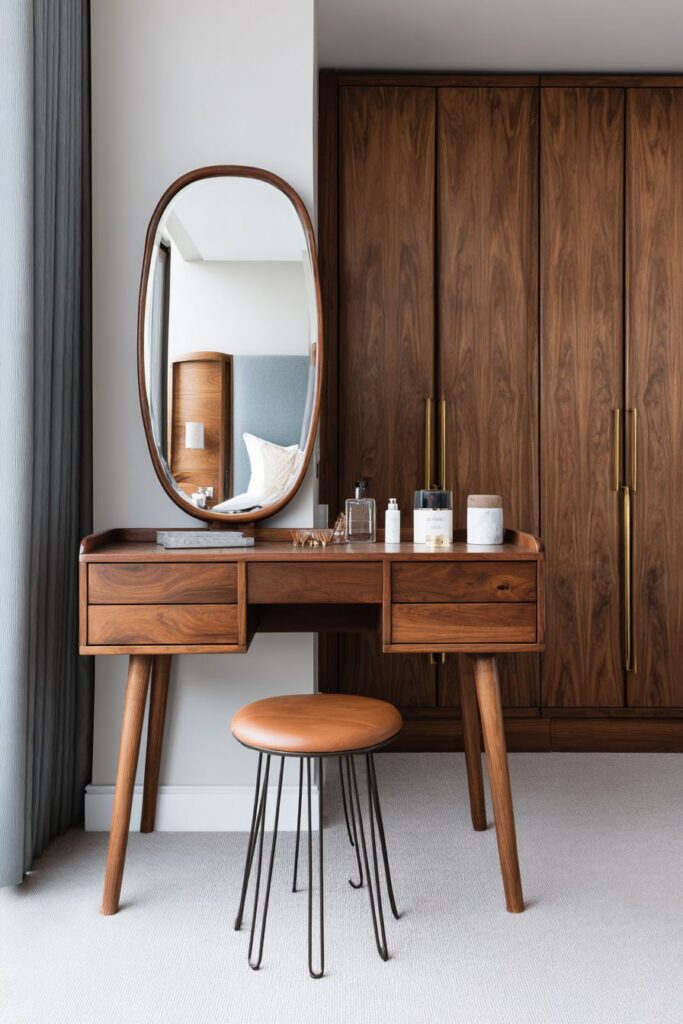
Thoughtful space planning allows even modest bedrooms to accommodate specialized functions, as demonstrated by a corner dressing area featuring a sleek vanity table in teak with a frameless oval mirror and wire-base stool with leather cushion. This grooming station exemplifies mid-century functional elegance, where every element serves a purpose while contributing to the overall aesthetic harmony. The teak vanity, with its warm tones and clean lines, provides necessary surface area for personal care while maintaining the visual lightness that prevents the corner from feeling cramped.
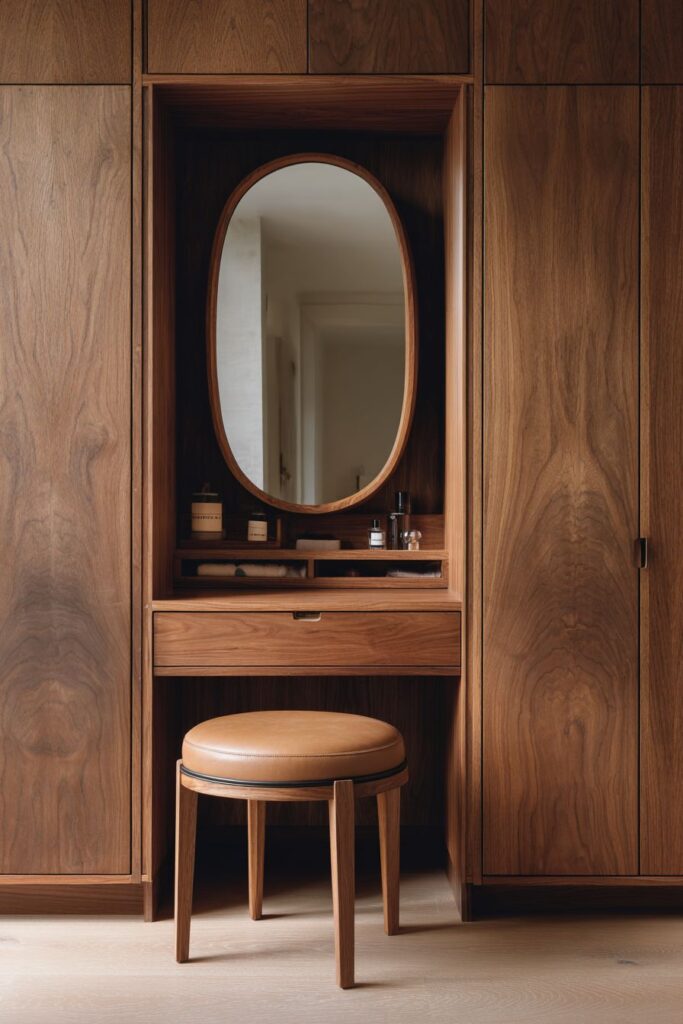
The frameless oval mirror creates an elegant focal point above the vanity, its simple shape and lack of ornamental frame keeping the emphasis on function while adding a touch of organic softness through its curved form. A wire-base stool with leather cushion provides comfortable seating that can be tucked completely under the vanity when not in use, demonstrating the mid-century genius for space-efficient furniture design. The combination of industrial wire and soft leather exemplifies the era’s material innovation and willingness to combine seemingly disparate elements.
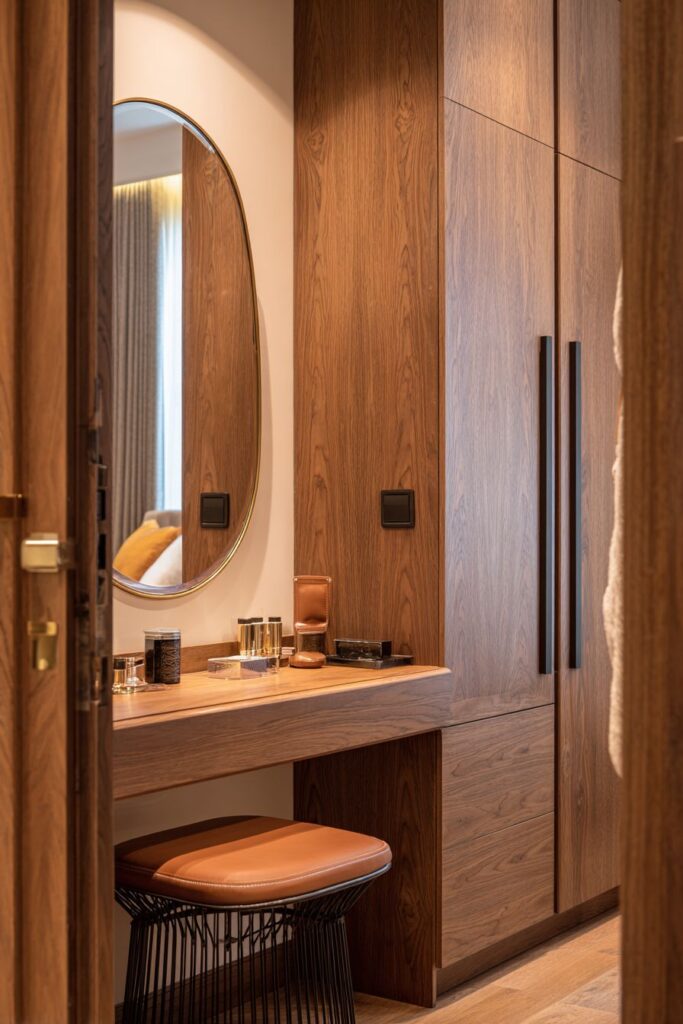
The vanity surface displays minimal cosmetic items in period-appropriate containers, maintaining the clean aesthetic even in this functional area. Adjacent built-in wardrobe doors feature vertical wood grain patterns that create visual height and integrate the dressing area seamlessly with the room’s storage solutions. This thoughtful integration of grooming space within the bedroom layout shows how mid-century designers addressed real-world needs without compromising design principles.
The functional elegance on display here—from the practical vanity setup to the space-saving stool to the integrated storage—demonstrates why mid-century design remains relevant for contemporary living. By addressing specific needs with well-designed solutions that maintain aesthetic cohesion, this dressing area becomes an asset to the bedroom rather than a compromise.
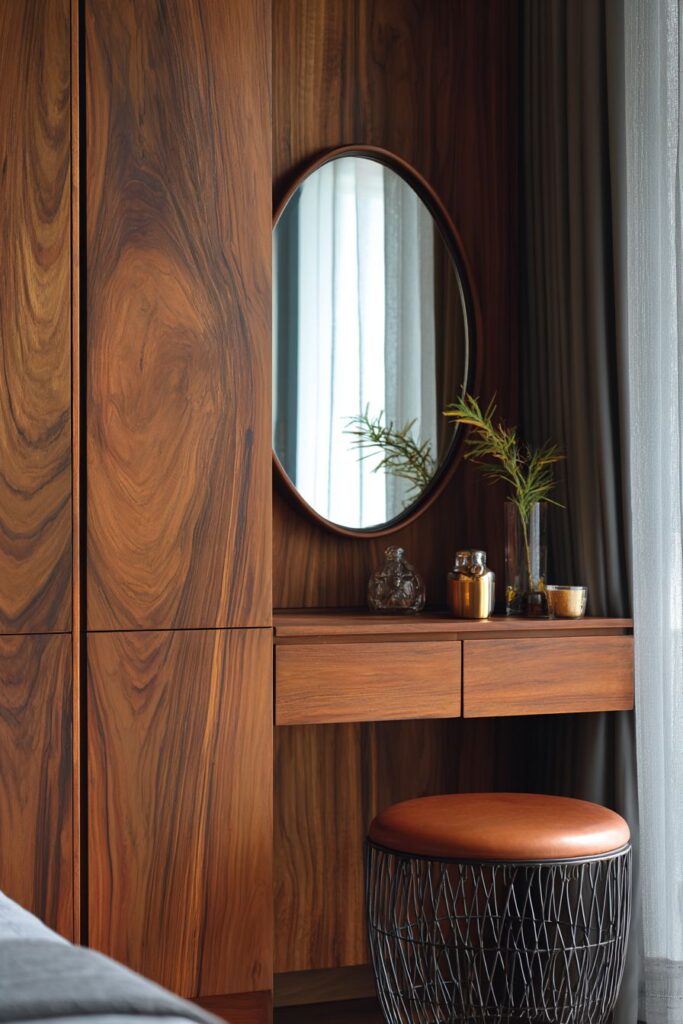
Key Design Tips:
- Create dedicated grooming areas with sleek teak or walnut vanity tables that provide function without bulk
- Choose frameless oval mirrors for soft organic shapes that complement angular furniture
- Select wire-base stools or chairs that can be tucked away when not in use for space efficiency
- Display only essential items on vanity surfaces, using period-appropriate containers to maintain clean aesthetics
- Integrate dressing areas with adjacent storage solutions for seamless spatial flow
13. Floating Nightstand Platform Bed
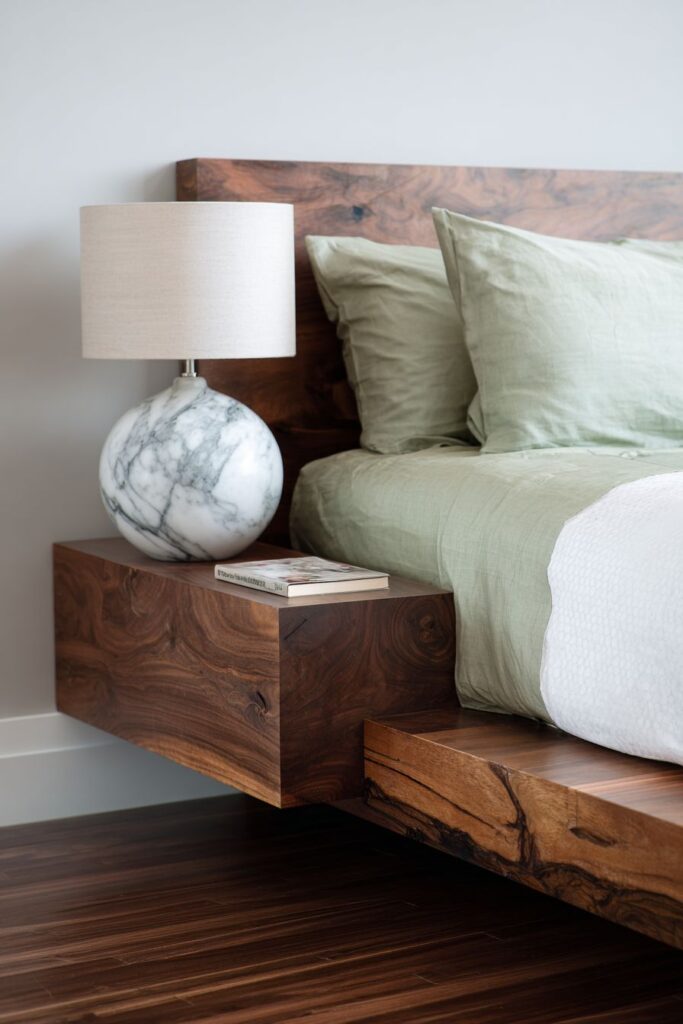
Innovation in furniture design reached new heights during the mid-century era, exemplified by a platform bed with attached floating nightstands in one continuous walnut piece. This integrated approach demonstrates the era’s emphasis on clean, uninterrupted lines and innovative construction methods that push beyond traditional furniture forms. The seamless connection between bed frame and nightstands creates a sculptural furniture piece that appears carved from a single block of walnut, showcasing the beauty of natural wood grain flowing continuously across the entire structure.
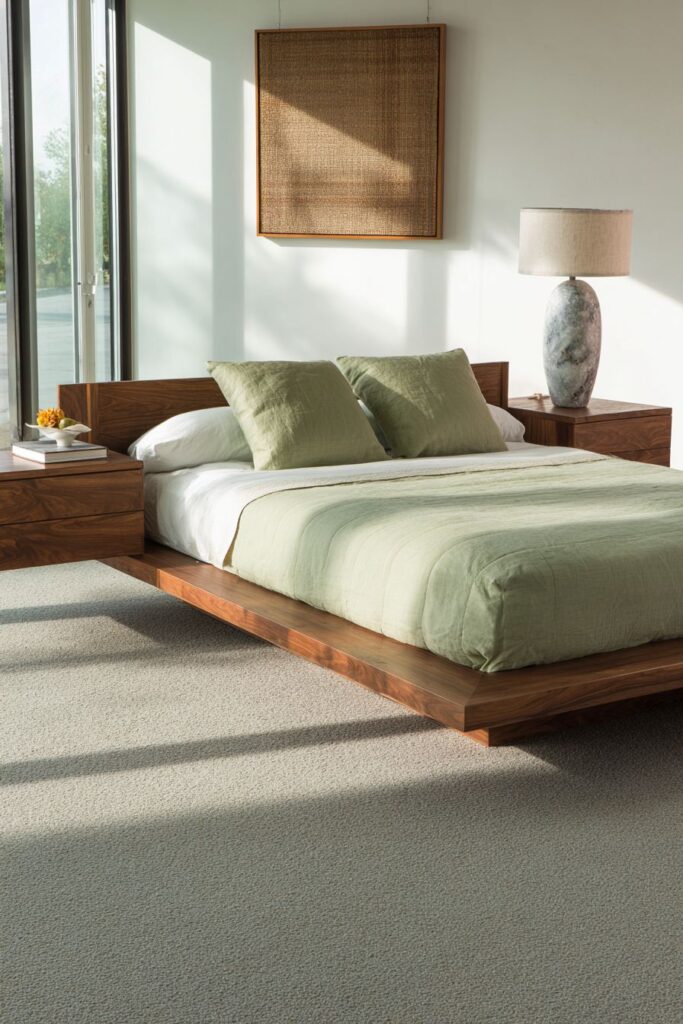
The bedding features a simple duvet in sage green with contrasting white sheets, providing a fresh, contemporary color palette that complements the warm walnut tones without competing for attention. This restrained approach to bedding allows the innovative furniture design to remain the focal point, demonstrating the mid-century principle that bold design statements work best when supported by simpler surrounding elements. The sage green introduces a touch of nature-inspired color that enhances the organic quality of the wood.
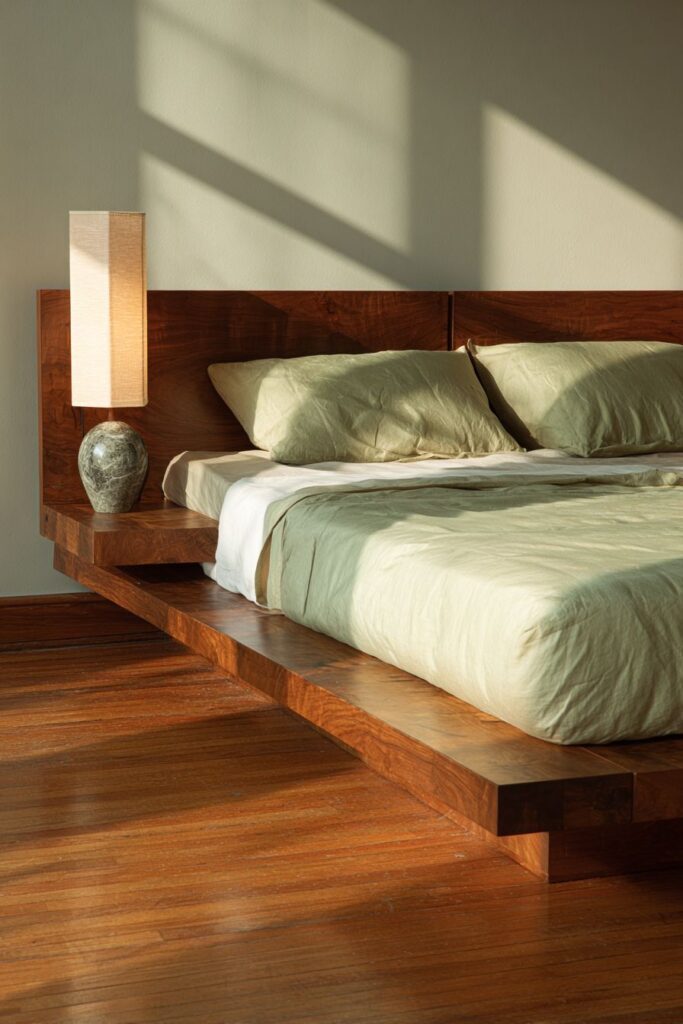
A sculptural table lamp with a marble base sits on the floating nightstand, its geometric form and luxurious material adding vertical interest and tactile appeal. The lamp’s presence on the integrated nightstand proves the functional success of this design innovation—the floating surface provides adequate space and stability for necessary bedside items despite its unconventional attachment to the bed frame. The marble base adds weight and substance that grounds the delicate-appearing structure.
Natural lighting highlights the innovative furniture design, casting shadows that emphasize the floating quality of the nightstands and the continuous grain pattern of the walnut. This seamless integration of form and function represents mid-century design at its most sophisticated, where technical innovation serves aesthetic goals while addressing practical needs.
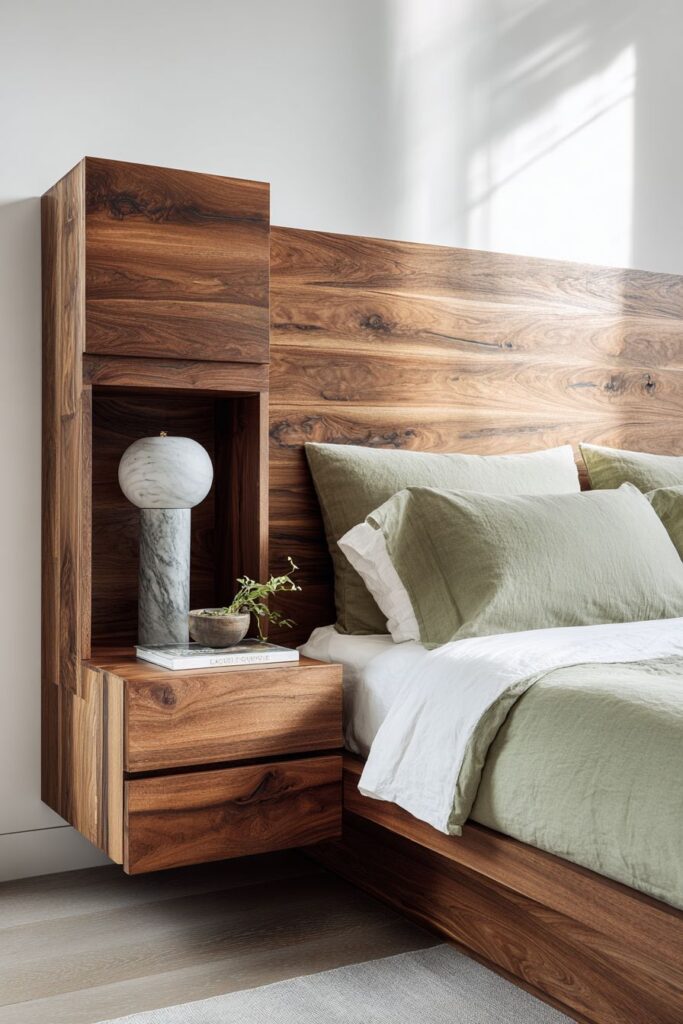
Key Design Tips:
- Seek out integrated platform beds with attached nightstands for statement-making mid-century furniture
- Choose designs in walnut or other richly grained woods that showcase continuous grain patterns
- Keep bedding simple in solid colors like sage green, grey, or cream to highlight furniture innovation
- Add sculptural table lamps with marble or ceramic bases for vertical interest and material variety
- Position beds to take advantage of natural light that emphasizes the floating quality and wood grain
14. Grasscloth Wallpaper Accent Wall
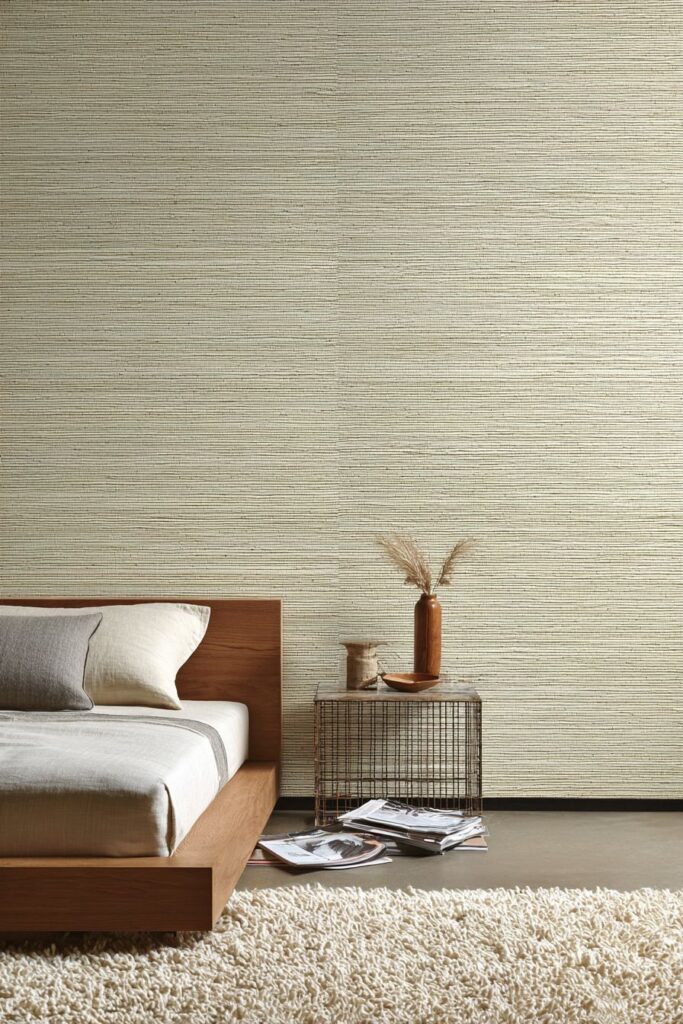
Natural materials extend beyond furniture to wall treatments in mid-century design, as exemplified by an accent wall covered in vintage grasscloth wallpaper with subtle texture variations in warm beige tones. This organic wall covering brings tactile dimension and natural beauty to the bedroom, its handwoven quality and irregular texture creating a sophisticated backdrop that feels both luxurious and earthy. The grasscloth’s vertical orientation subtly emphasizes ceiling height while its neutral tone provides warmth without overwhelming the space with color.
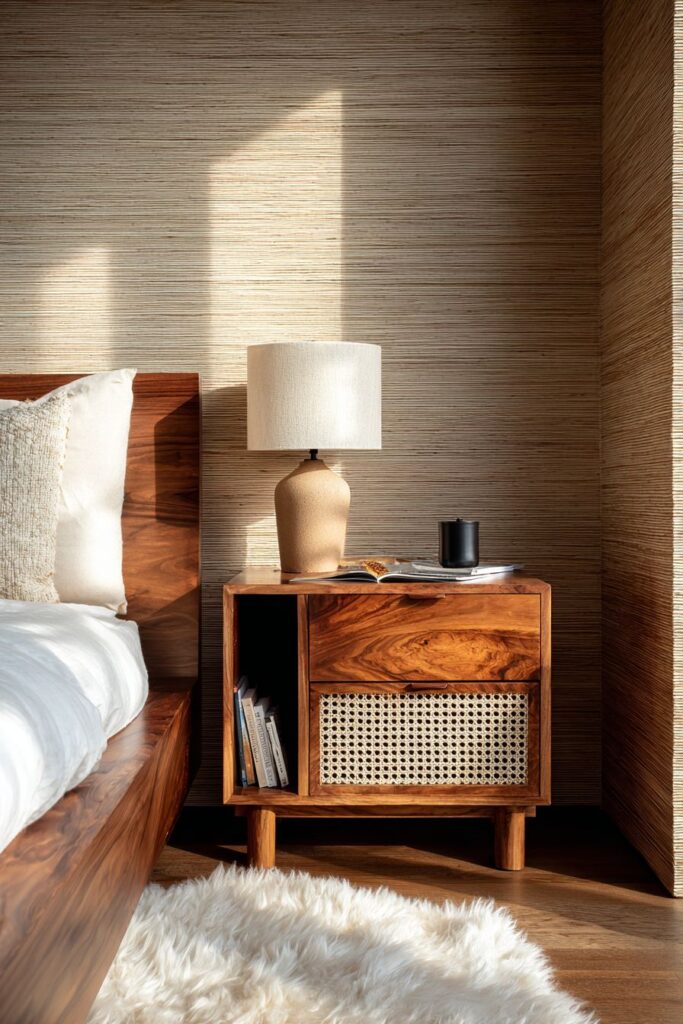
The room includes a low-slung bed with teak frame that maintains the mid-century emphasis on low, horizontal furniture profiles that make rooms feel larger and more open. A wire mesh magazine rack sits beside the bed, representing the era’s clever approach to functional storage that becomes decorative through honest material expression and thoughtful form. The wire mesh allows contents to be partially visible while maintaining an open, airy quality that doesn’t visually clutter the space.
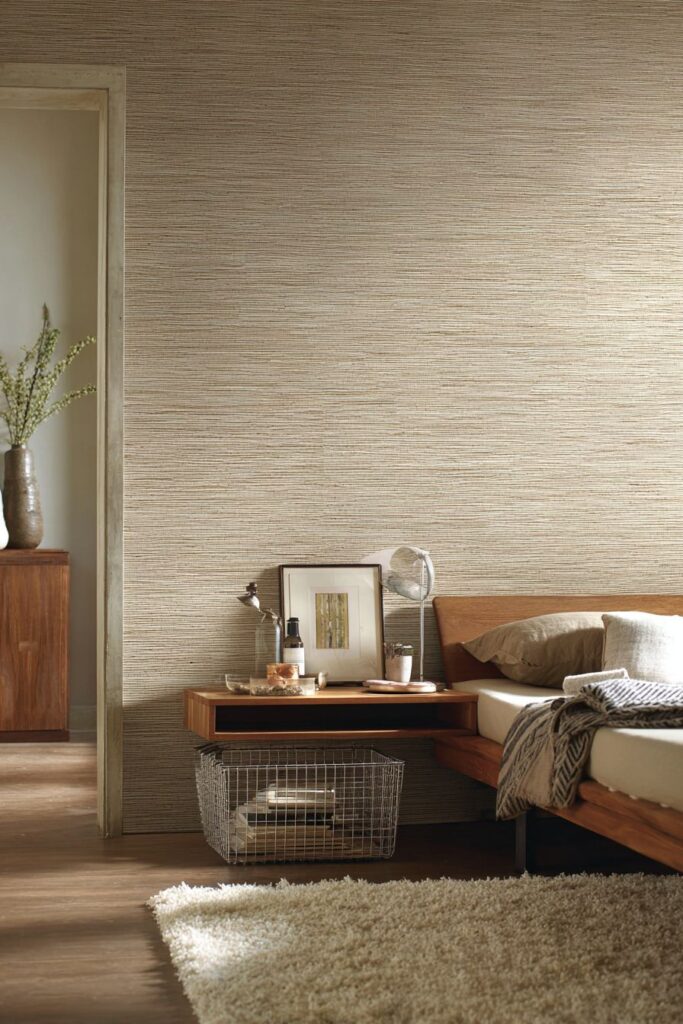
A shag area rug in cream adds soft texture underfoot, its deep pile creating a luxurious tactile experience that contrasts beautifully with the smooth teak furniture and organic grasscloth wall. This layering of textures—from the woven wall covering to the plush carpet to the smooth wood frame—demonstrates the mid-century mastery of creating visual and tactile interest through material variety rather than ornamental excess.
Diffused natural light emphasizes the grasscloth’s organic quality, highlighting the subtle variations in weave and color that make each section of the wall covering unique. The authentic period material choices on display create a cohesive environment where every surface contributes to the overall sensory experience of the room.
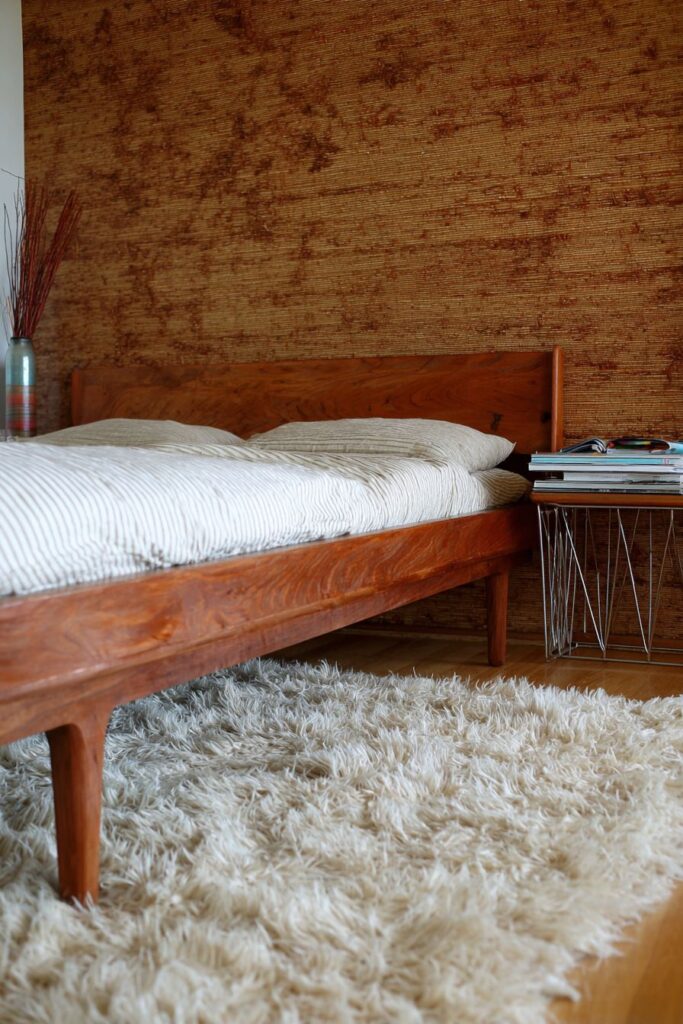
Key Design Tips:
- Install grasscloth wallpaper on accent walls for natural texture and sophisticated organic appeal
- Choose neutral beige or warm grey tones that add warmth without dominating the color palette
- Select low-slung bed frames in teak or walnut to maintain mid-century proportions
- Add wire mesh or other industrial-inspired storage pieces that combine function with sculptural form
- Layer soft textiles like shag rugs to create tactile contrast with smooth wood surfaces
15. Exposed Beam Ceiling Treatment
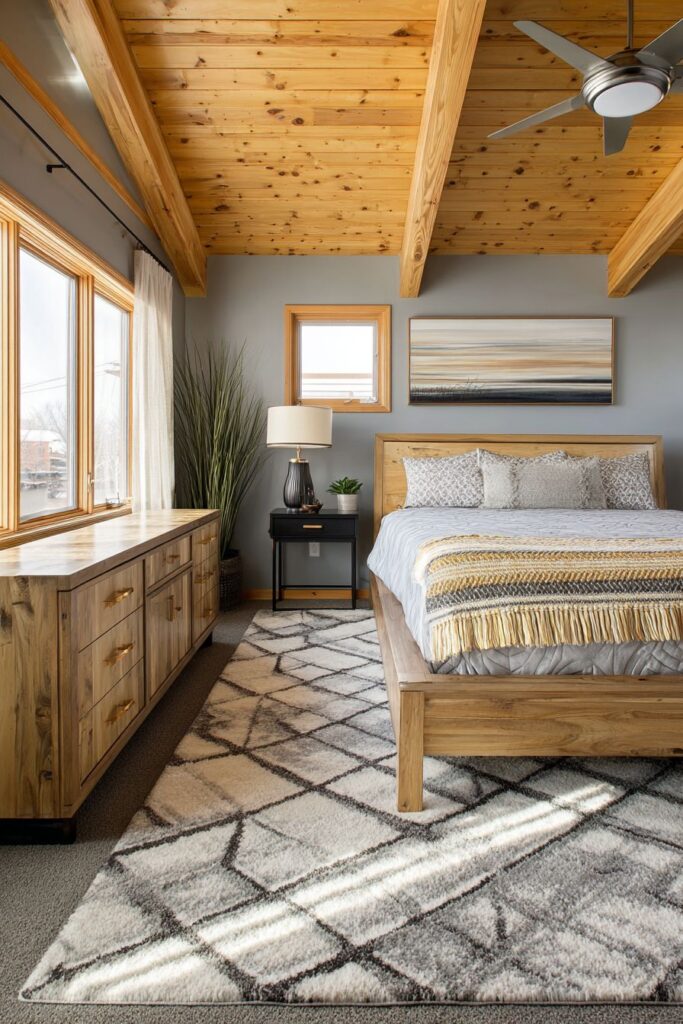
Architectural elements become design features in mid-century spaces, as demonstrated by a bedroom with exposed wooden beams in natural finish creating interest overhead. This ceiling treatment adds vertical dimension and structural character, transforming what is often a forgotten surface into an active participant in the room’s design story. The natural wood finish celebrates the material’s organic beauty, with visible grain patterns and warm tones that complement the furniture below while adding architectural gravitas to the space.
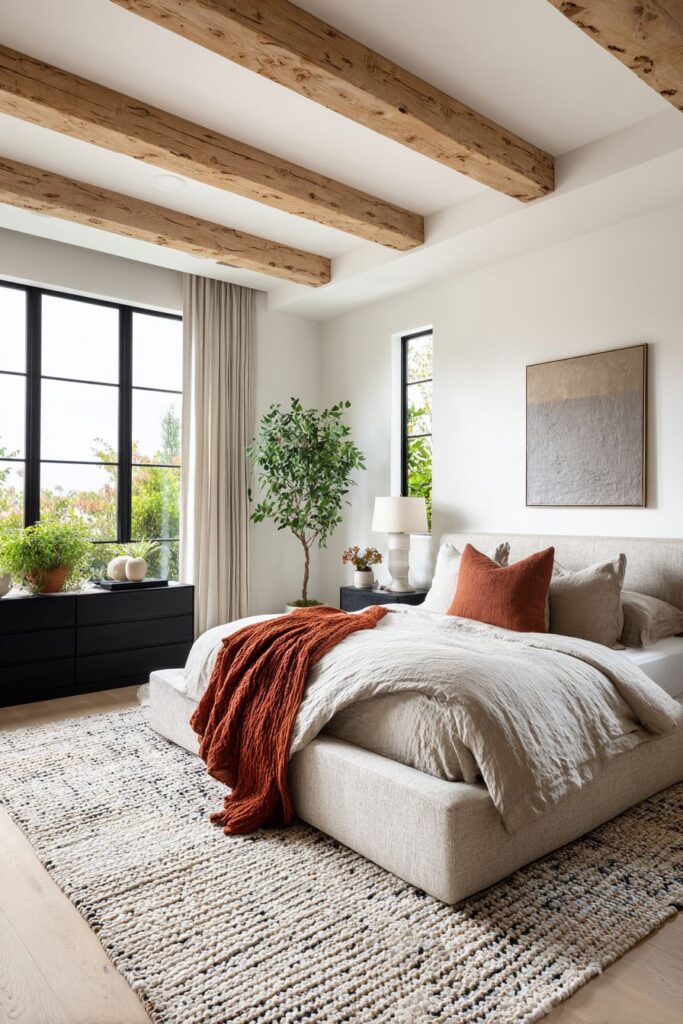
Below this dramatic ceiling, a simple platform bed with organic cotton linens and handwoven throw in earth tones provides a serene foundation. The restraint in bedding choices allows the eye to appreciate the ceiling treatment without visual competition, demonstrating the mid-century understanding that impactful design requires knowing when to add drama and when to exercise restraint. The handwoven throw introduces artisanal texture and warm color that connects the bed visually to the wooden beams above.
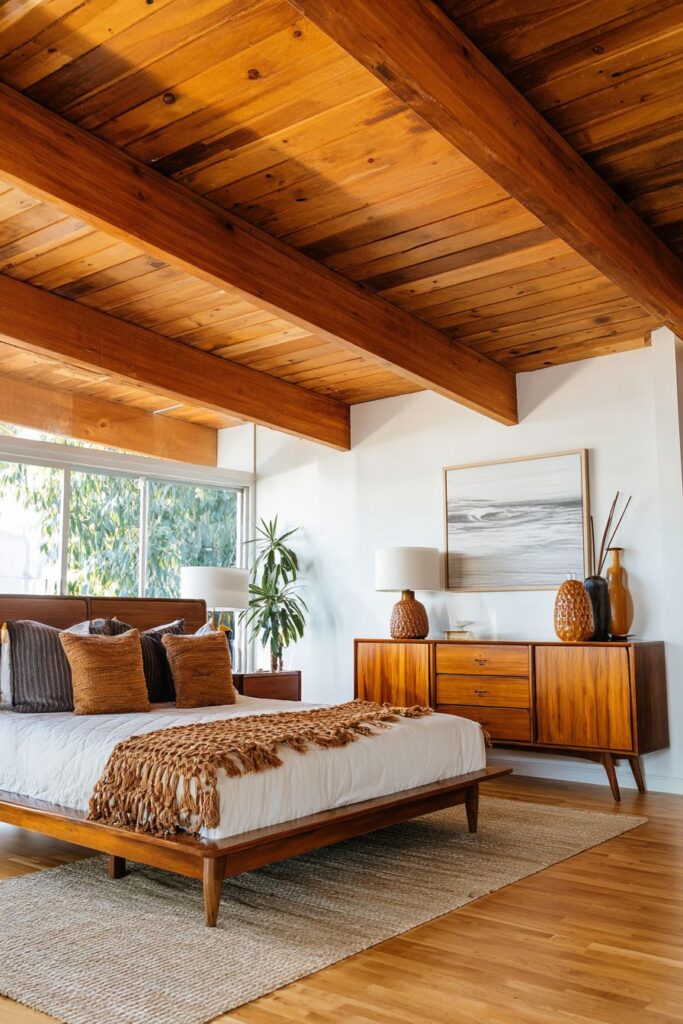
A sleek credenza serves as a media console with period-appropriate proportions, its low profile and clean lines maintaining the horizontal emphasis while providing practical storage for modern electronics. The credenza’s placement and scale demonstrate how mid-century furniture can accommodate contemporary needs without compromising aesthetic integrity. Its warm wood tones echo the ceiling beams, creating vertical visual connections that unify the room’s composition.
Natural light casts subtle beam shadows across the room, creating dynamic patterns that change throughout the day and emphasize the structural elements’ three-dimensional quality. This interplay of light and shadow adds movement and vitality to the space, showing how mid-century design embraces natural phenomena as integral design elements rather than factors to be controlled or minimized.
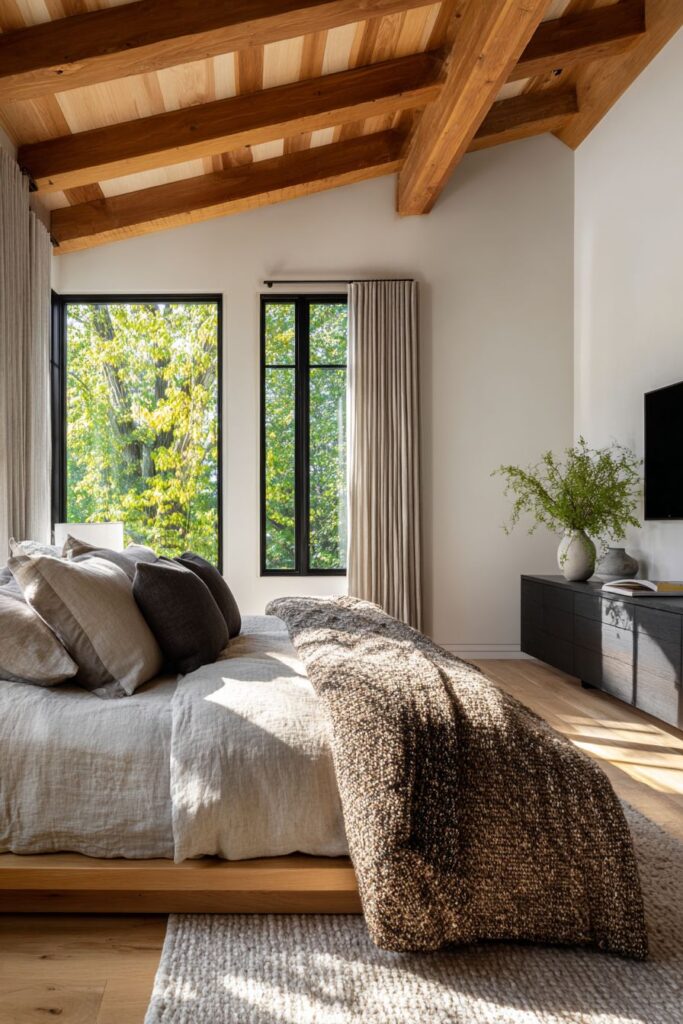
Key Design Tips:
- Expose ceiling beams in natural wood finish to add architectural interest and vertical dimension
- Choose simple platform beds with minimal styling to avoid visual competition with dramatic ceiling treatments
- Select credenzas and low-profile storage that maintains horizontal emphasis while providing practical function
- Use handwoven textiles in earth tones to create visual connections between floors and ceilings
- Embrace the shadows and light patterns created by structural elements as dynamic design features
16. Natural Linen Window Treatments
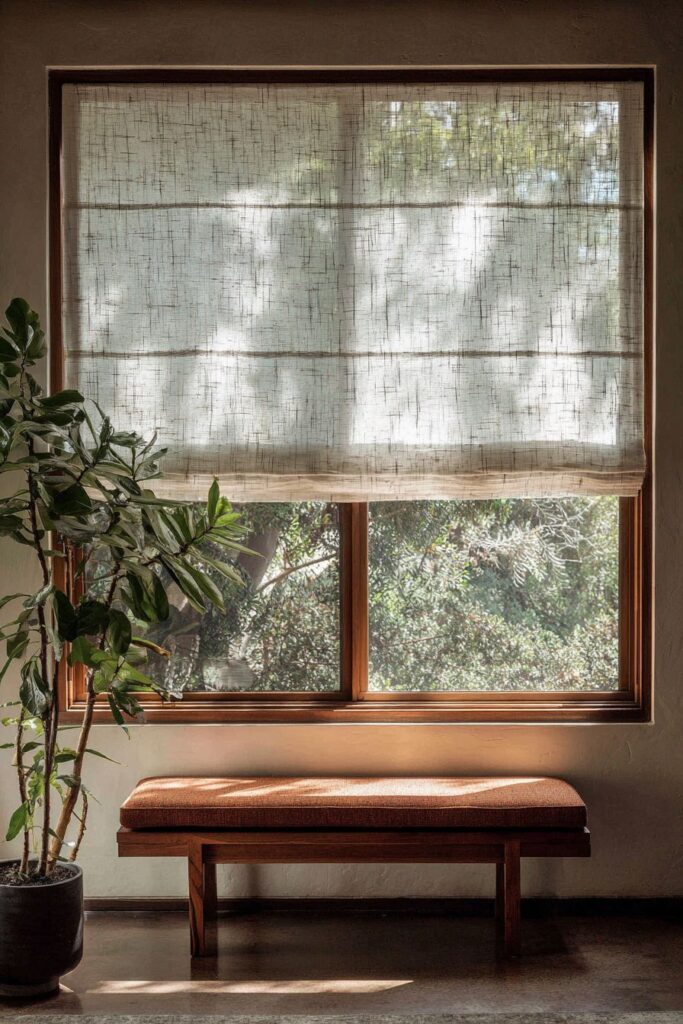
The mid-century approach to window dressing prioritized simplicity and natural light, exemplified by Roman shades in natural linen fabric that filter daylight softly into the space. These understated window treatments demonstrate the era’s preference for functional solutions that enhance rather than obstruct architectural features and natural illumination. The linen fabric’s subtle texture and neutral color provide privacy when needed while maintaining the room’s connection to the outdoors through filtered natural light.
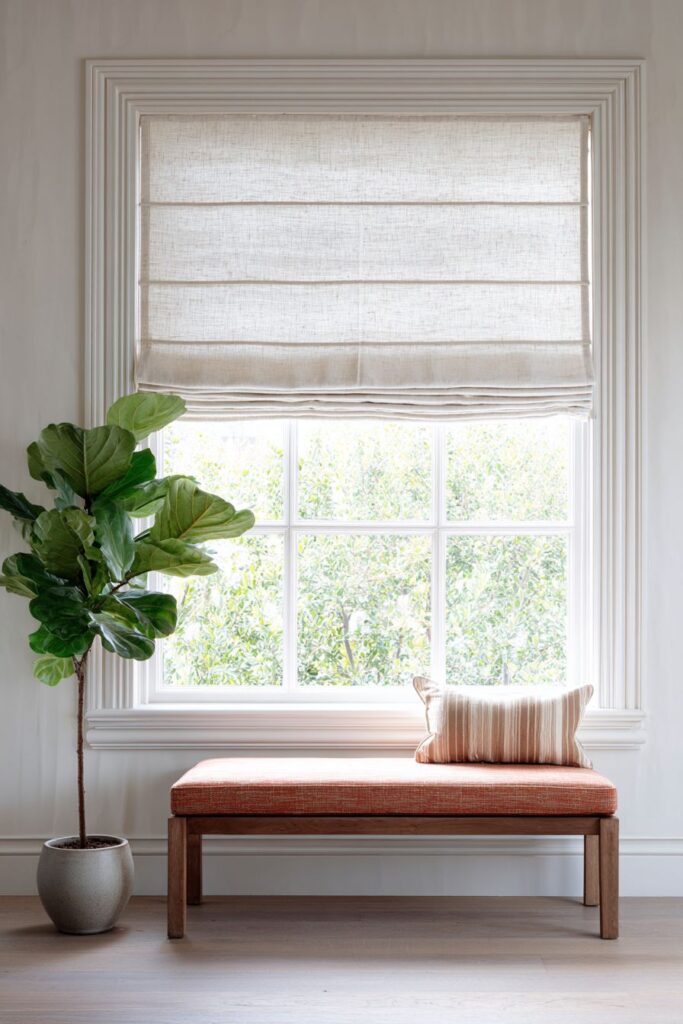
Below the window, a teak bench with thin cushion in rust-colored fabric provides seating while maintaining the clean lines and warm wood tones characteristic of mid-century furniture. This window bench serves multiple purposes—a place to sit and enjoy the view, a spot for reading in natural light, or simply a decorative element that draws the eye to the window and outdoor connection. The rust-colored cushion introduces the era’s beloved warm palette while providing necessary comfort for extended sitting.
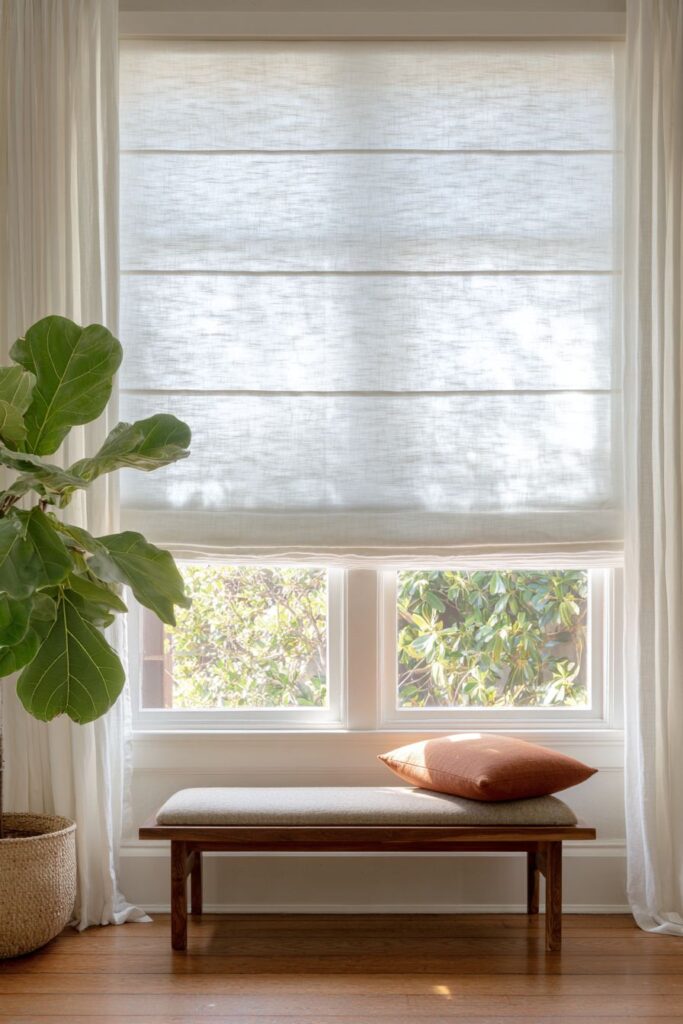
A potted fiddle leaf fig adds organic elements that reinforce the indoor-outdoor connection, its broad leaves creating sculptural silhouettes against the filtered window light. This incorporation of living plants reflects the mid-century appreciation for bringing nature indoors, creating spaces that feel vital and connected to the natural world. The fiddle leaf fig’s substantial presence and dramatic foliage make it a popular choice for mid-century interiors, where its architectural quality complements the clean lines of the furniture.
The minimalist approach to window dressing and the emphasis on connection to nature creates a bedroom environment that feels open, airy, and restorative. Soft diffused lighting throughout the space demonstrates how proper window treatment selection can enhance natural light quality rather than simply blocking it, creating the perfect balance between privacy and openness.
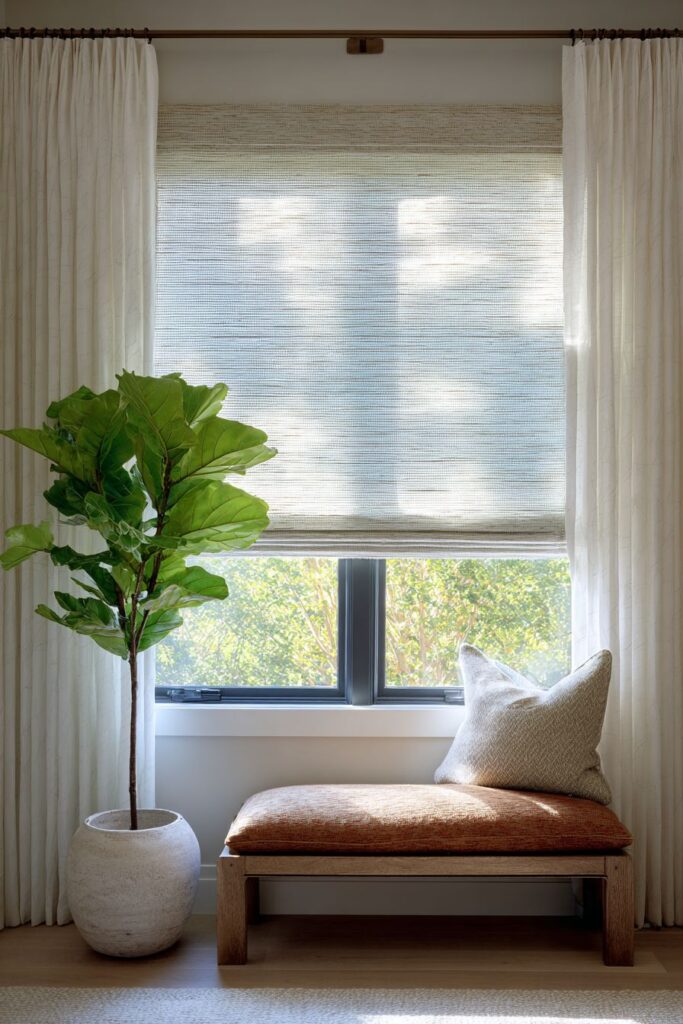
Key Design Tips:
- Choose Roman shades or simple roller shades in natural linen for understated window treatments
- Select neutral fabrics that filter light softly while maintaining connection to outdoor views
- Add window benches in teak or walnut with thin cushions for functional seating that enhances the architectural feature
- Incorporate large-leafed plants like fiddle leaf figs for sculptural organic elements
- Use warm-colored cushions and textiles to introduce the mid-century color palette while providing comfort
17. Color-Blocked Geometric Accent Wall
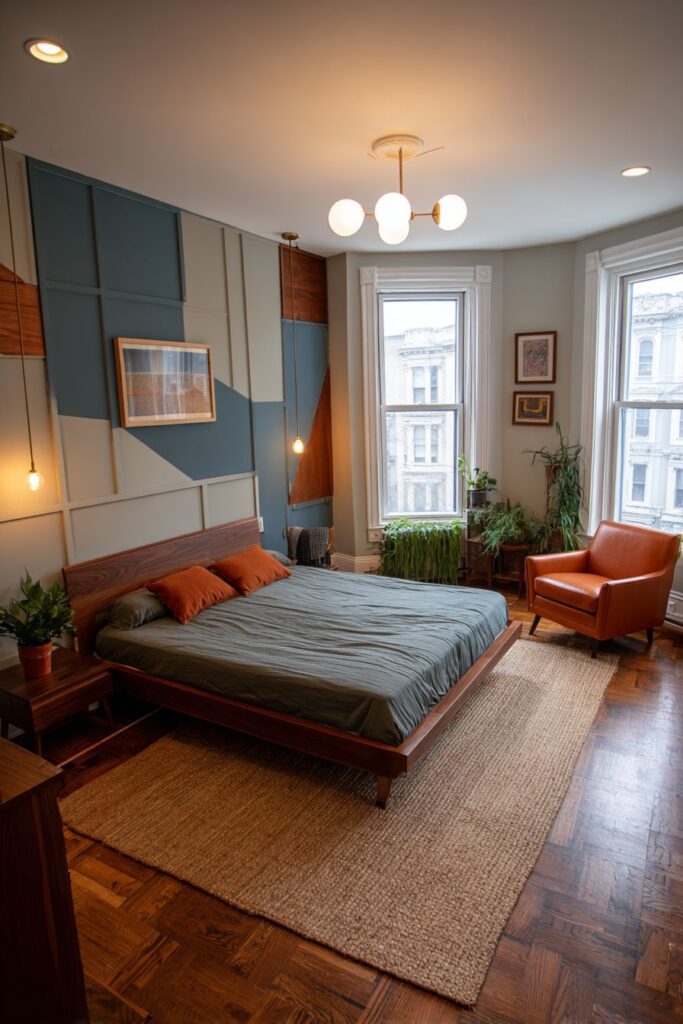
Bold geometric treatments can energize mid-century bedrooms when applied with restraint, as demonstrated by a color-blocked accent wall with sections in muted teal and warm grey. This graphic approach to wall design creates visual interest without overwhelming the space, using the era’s characteristic color blocking to define different areas and add dynamic energy. The muted tones—neither too bright nor too dull—exemplify the mid-century ability to use color boldly while maintaining sophistication and livability.
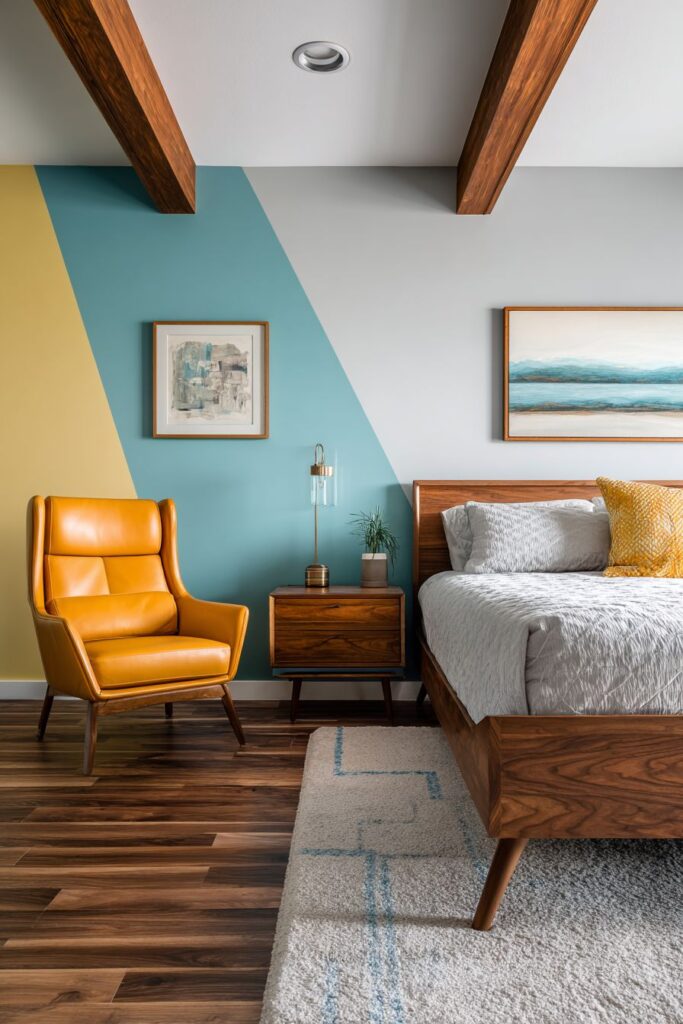
The furniture includes a walnut bed frame with simple lines that provides a warm, organic counterpoint to the geometric wall treatment. A compact armchair in tangerine leather introduces another signature mid-century color, its vibrant hue balanced by the small scale and strategic placement in the room. The leather upholstery adds luxurious texture and develops a beautiful patina over time, celebrating the mid-century appreciation for materials that age gracefully and tell the story of their use.

Cork flooring adds natural texture underfoot, its warm honey tones and subtle pattern creating a foundation that grounds the room’s bolder color choices. This sustainable, comfortable flooring material was popular during the mid-century era for its natural beauty, acoustic properties, and tactile warmth. The cork’s organic quality balances the geometric precision of the painted wall, creating dialogue between natural and designed elements.
The bold yet balanced use of period-appropriate colors and careful composition of furniture placement demonstrates mid-century design mastery. Each element contributes to the overall impact without competing for attention, creating a cohesive environment where color, form, and material work in harmony.
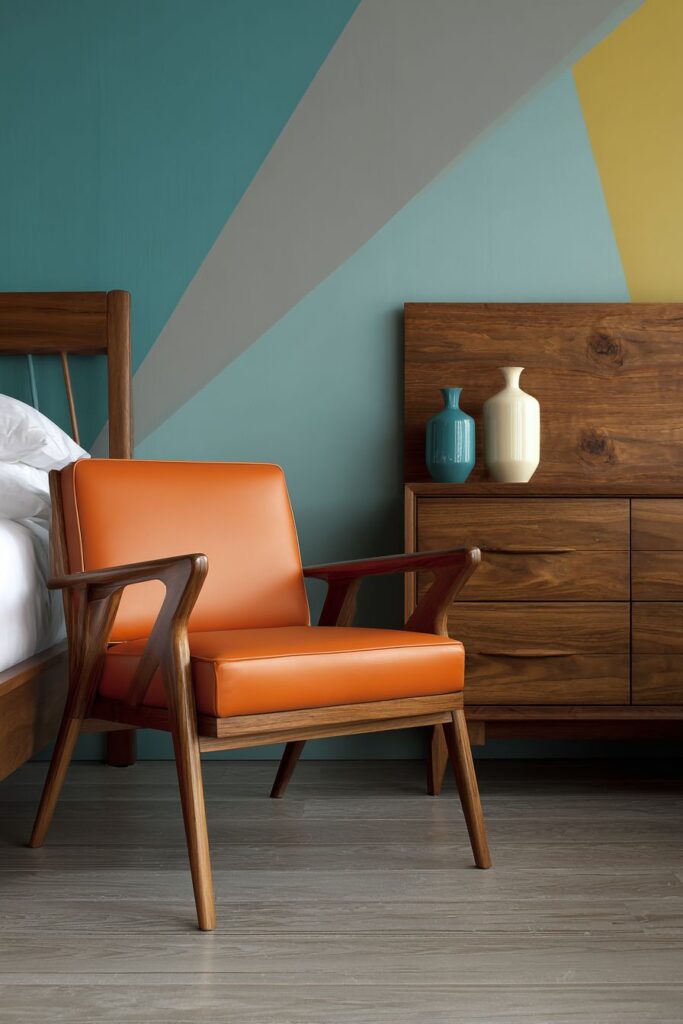
Key Design Tips:
- Create color-blocked accent walls using muted mid-century colors like teal, grey, mustard, or rust
- Use geometric sections with clean edges and simple shapes for graphic impact
- Balance bold wall treatments with simple bed frames in warm wood tones
- Add compact seating in vibrant colors like tangerine or burnt orange for additional color impact
- Choose cork or other natural flooring materials that provide textural warmth and sustainable beauty
18. Sculptural Ceramic Table Lamps

Lighting becomes art in mid-century bedrooms through carefully curated ceramic table lamps with distinctive sculptural qualities. A collection featuring varied forms—one with a gourd-like base in turquoise glaze, another with a cylindrical form in matte black—demonstrates the era’s appreciation for functional objects that serve as decorative elements. These handcrafted pieces, sitting on teak nightstands with minimal hardware, exemplify the mid-century understanding that everyday items deserve thoughtful design and artistic consideration.
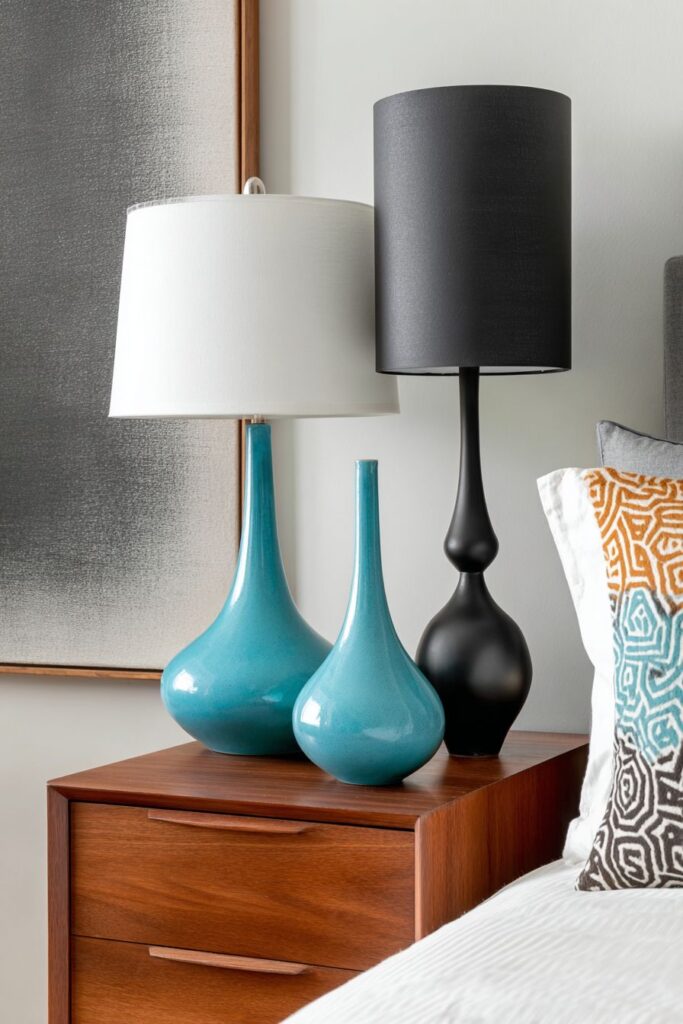
The lamps’ distinctive shapes and varied finishes create visual interest through diversity while maintaining cohesion through their shared ceramic material and mid-century aesthetic. The turquoise glaze on the gourd-shaped lamp introduces vibrant color and glossy surface quality that catches and reflects light, while the matte black cylindrical lamp provides sculptural presence through its simple geometric form and light-absorbing surface. This curated mix represents the era’s willingness to combine varied elements within a cohesive design framework.
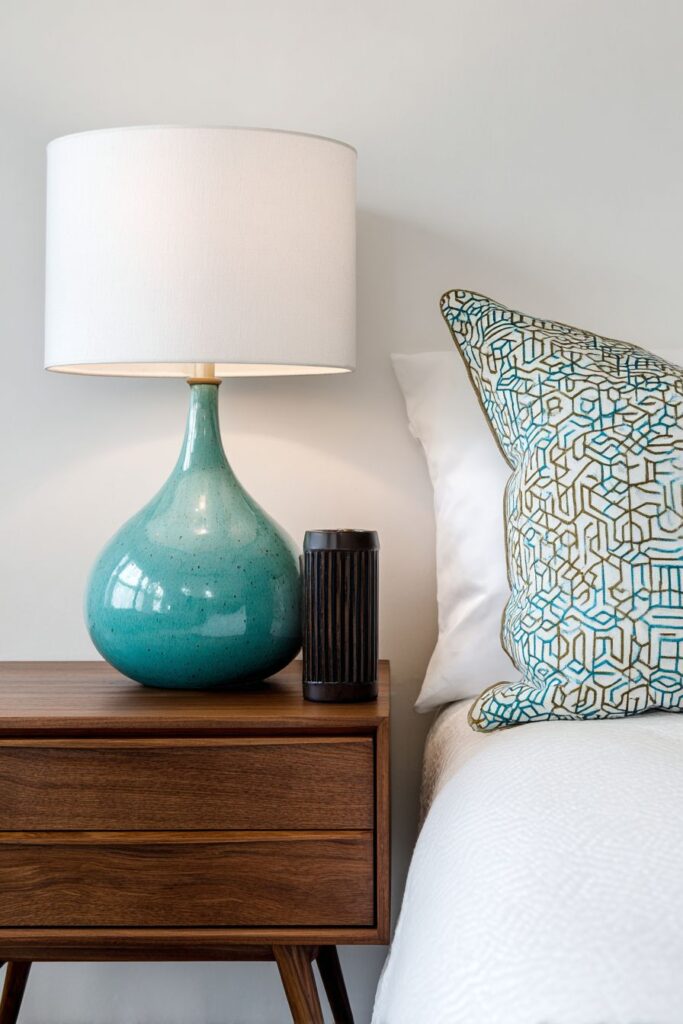
The bedding is kept simple in white with a geometric print pillow, allowing the sculptural lamps to command attention without visual competition. This restraint in textile choices demonstrates the mid-century principle of creating focal points through strategic emphasis rather than overall embellishment. The geometric pillow echoes the clean lines and abstract forms found throughout mid-century design, connecting the bed to the room’s overall aesthetic through subtle pattern.
The sculptural quality of period lighting and the curated mix of functional art pieces transforms these necessary bedroom fixtures into statement-making design elements. Each lamp contributes individual character while working together to create a cohesive lighting strategy that provides both practical illumination and aesthetic pleasure.
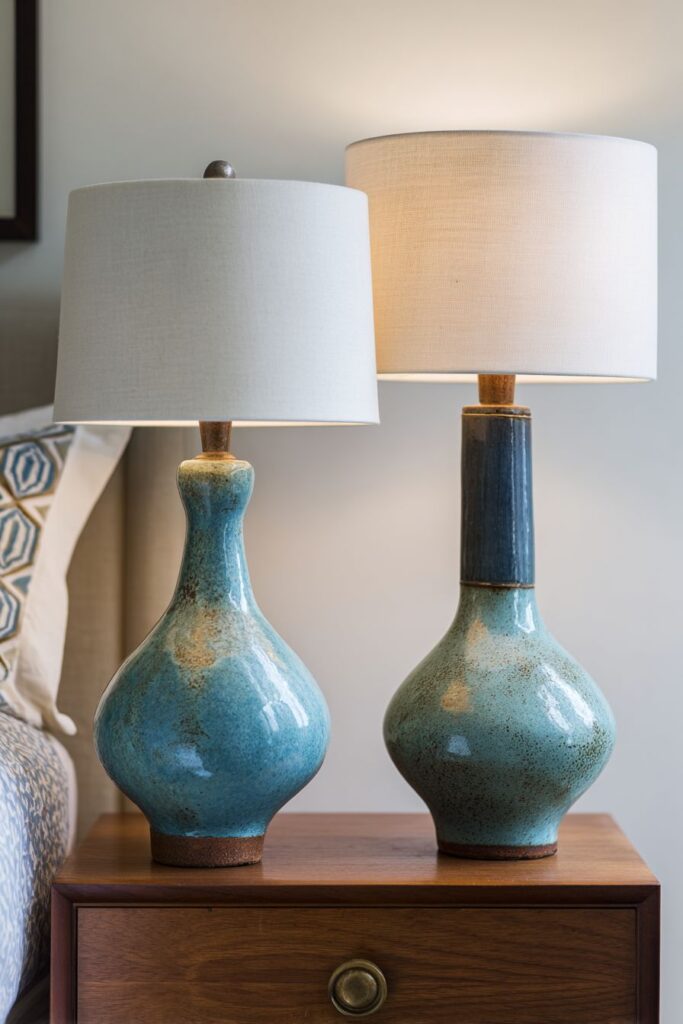
Key Design Tips:
- Collect ceramic table lamps with distinctive sculptural forms in varied shapes and finishes
- Choose lamps with authentic mid-century glazes like turquoise, mustard, or matte black
- Place varied lamps on matching nightstands to create unity while showcasing individual lamp character
- Keep bedding simple when featuring statement lighting to avoid visual competition
- Select geometric or abstract printed pillows to echo mid-century design principles
19. Compact Sitting Area With Innovative Materials
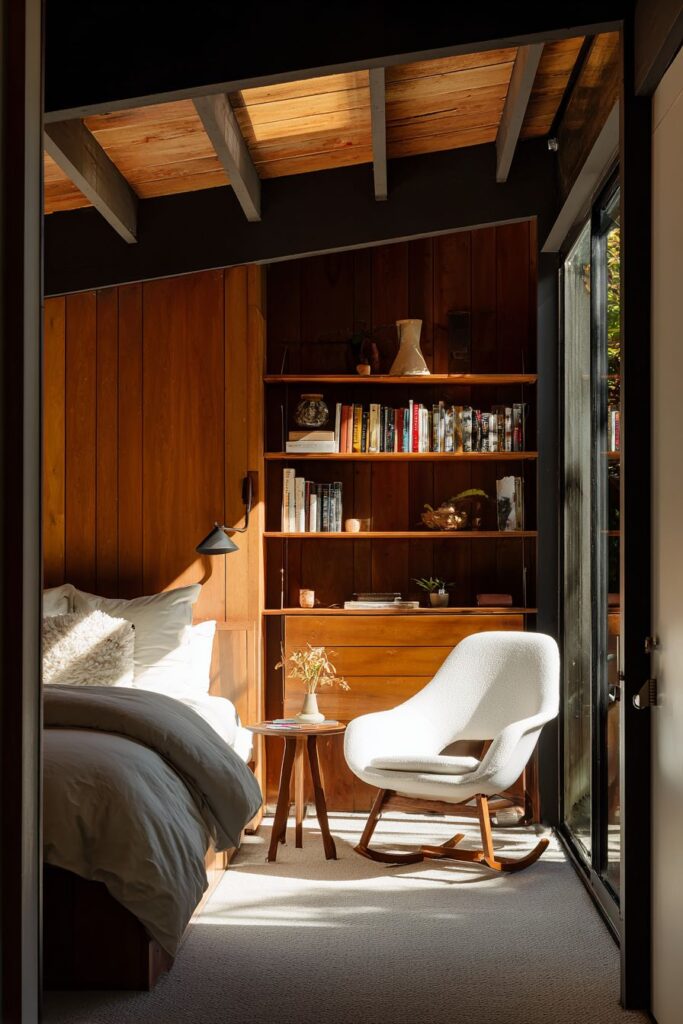
The mid-century era’s innovative use of modern materials is exemplified by a compact sitting area featuring two molded plastic shell chairs in white with wooden rocker bases. These iconic chairs represent the revolutionary use of fiberglass and plastic in furniture manufacturing, creating forms that were previously impossible with traditional materials and construction methods. The white shells provide clean, modern aesthetic appeal while the wooden rocker bases add organic warmth and gentle kinetic pleasure, demonstrating the era’s skill at combining high-tech and natural materials.
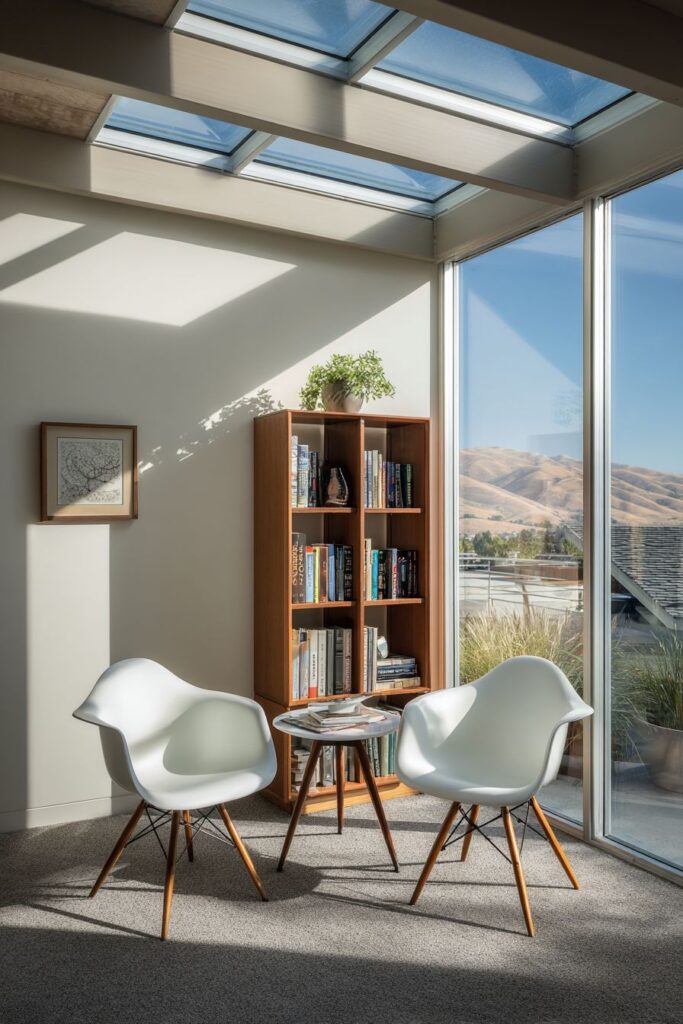
Positioned around a small tripod side table, these chairs create an intimate conversation area that maximizes function while minimizing space requirements. The tripod table’s slender legs and modest footprint exemplify mid-century space-efficient design, providing necessary surface area without visual or physical bulk. A floor-to-ceiling bookshelf in teak holds a mix of vintage books and decorative objects, turning necessary storage into a display opportunity that adds personality and warmth to the space.
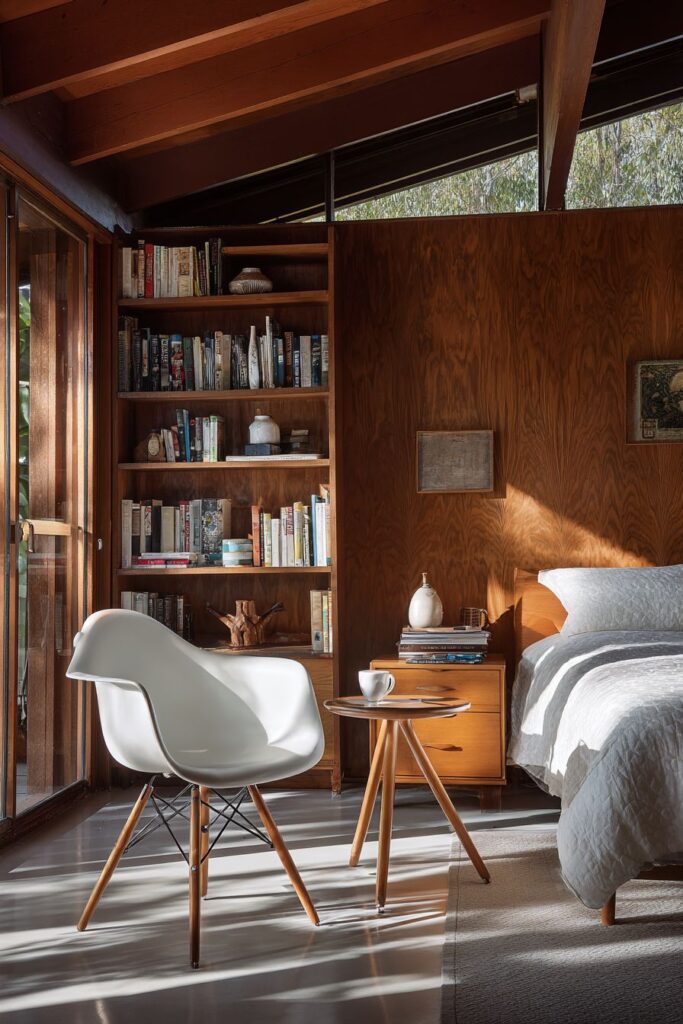
Natural light from clerestory windows above creates dramatic shadows that emphasize the chairs’ sculptural forms and the room’s architectural features. These high-placed windows provide abundant natural light while maintaining privacy, a clever architectural solution that exemplifies mid-century problem-solving. The dramatic shadow play created by this lighting approach adds visual interest and highlights the three-dimensional qualities of the furniture and architecture.
The efficient spatial planning characteristic of the era shines through in this arrangement, where every element serves multiple purposes—the chairs provide seating and sculptural interest, the bookshelf offers storage and display, and the windows deliver light and architectural drama. This holistic approach to design creates rooms that feel complete and purposeful without excess.
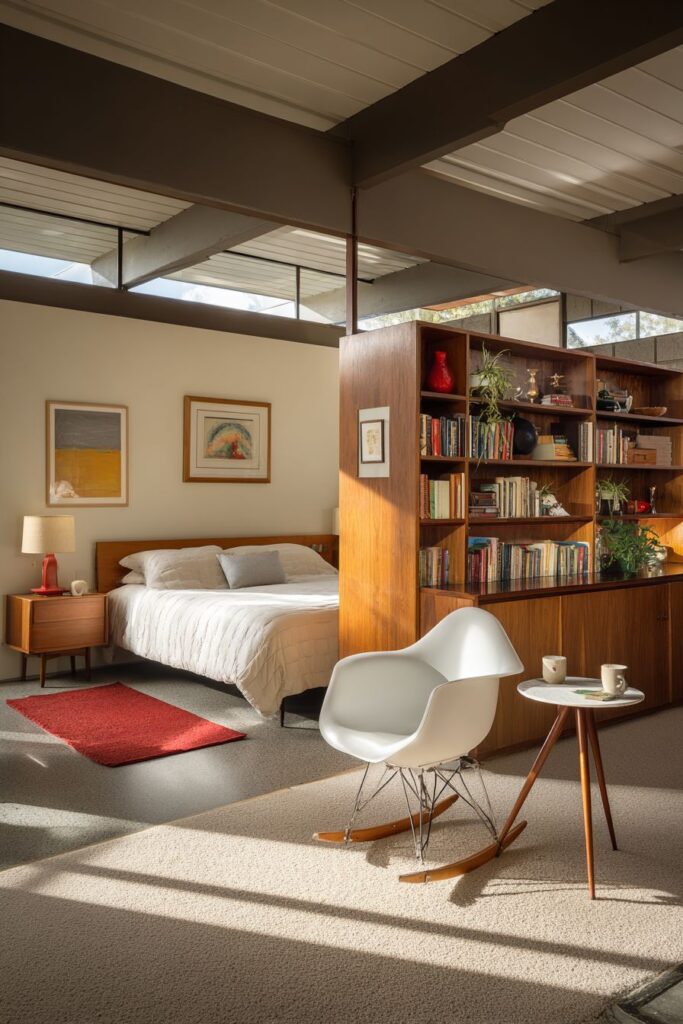
Key Design Tips:
- Incorporate molded plastic or fiberglass chairs for authentic mid-century innovative material use
- Choose designs with wooden rocker or dowel bases that combine modern and organic materials
- Use tripod tables or other space-efficient furniture for maximum function with minimal footprint
- Install floor-to-ceiling shelving in teak or walnut for storage that becomes an architectural feature
- Position furniture to take advantage of clerestory windows or other architectural lighting features
20. Brick Accent Wall With Material Contrast
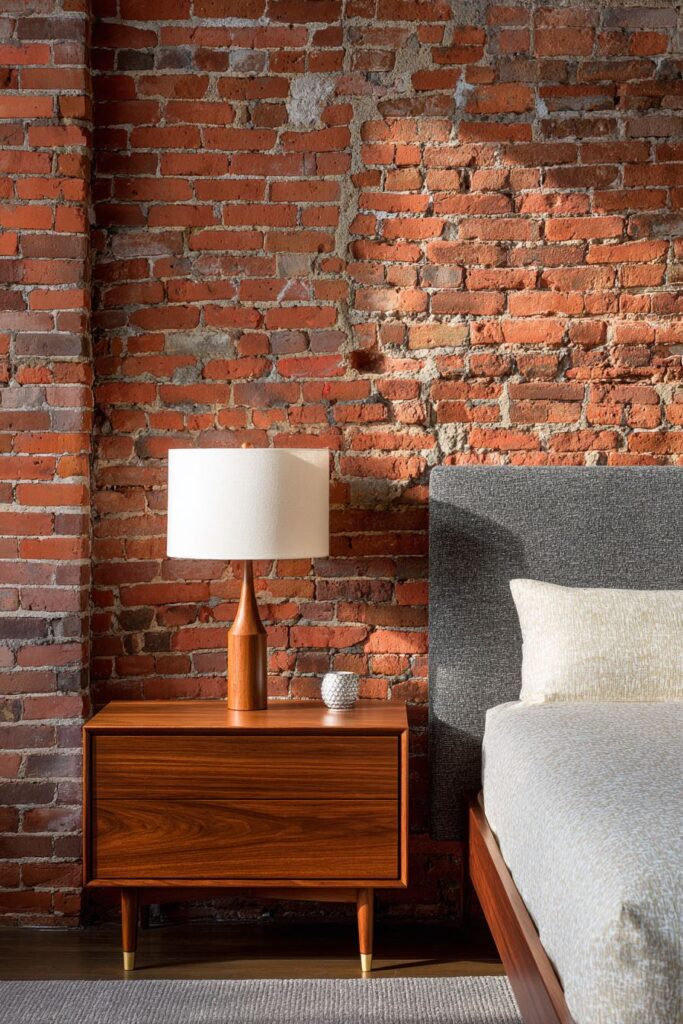
The interplay of rough and refined textures defines this mid-century bedroom featuring an original brick accent wall in warm red-orange tones that provides dramatic textural contrast to smooth walnut furniture pieces. This exposed brick, with its dimensional quality and natural color variations, brings an industrial-organic element that grounds the space with earthy authenticity. The warm red-orange tones complement rather than compete with the walnut’s reddish-brown hues, creating a sophisticated tonal story that feels cohesive despite the material diversity.
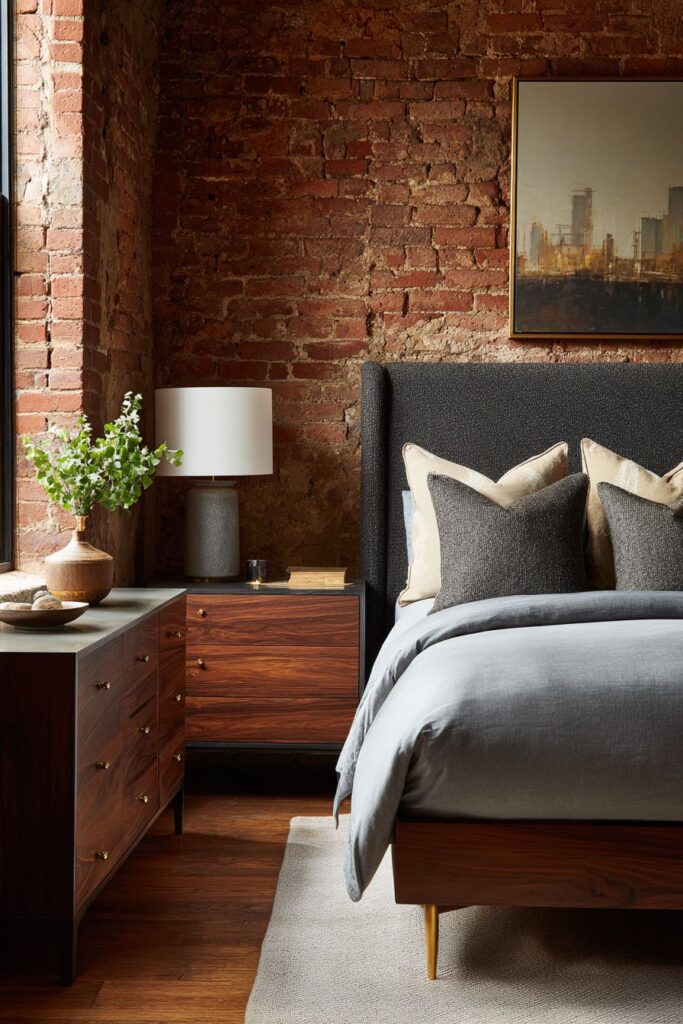
A low dresser with brass leg tips sits against the brick wall, its sleek walnut surface and refined hardware providing elegant contrast to the brick’s rough texture. Topped with a table lamp featuring a fiberglass shade, the dresser becomes a carefully composed vignette that showcases the mid-century mastery of material juxtaposition. The brass leg tips add subtle metallic accent that catches light and draws attention to the furniture’s delicate supports, while the fiberglass lampshade represents the era’s embrace of modern synthetic materials.
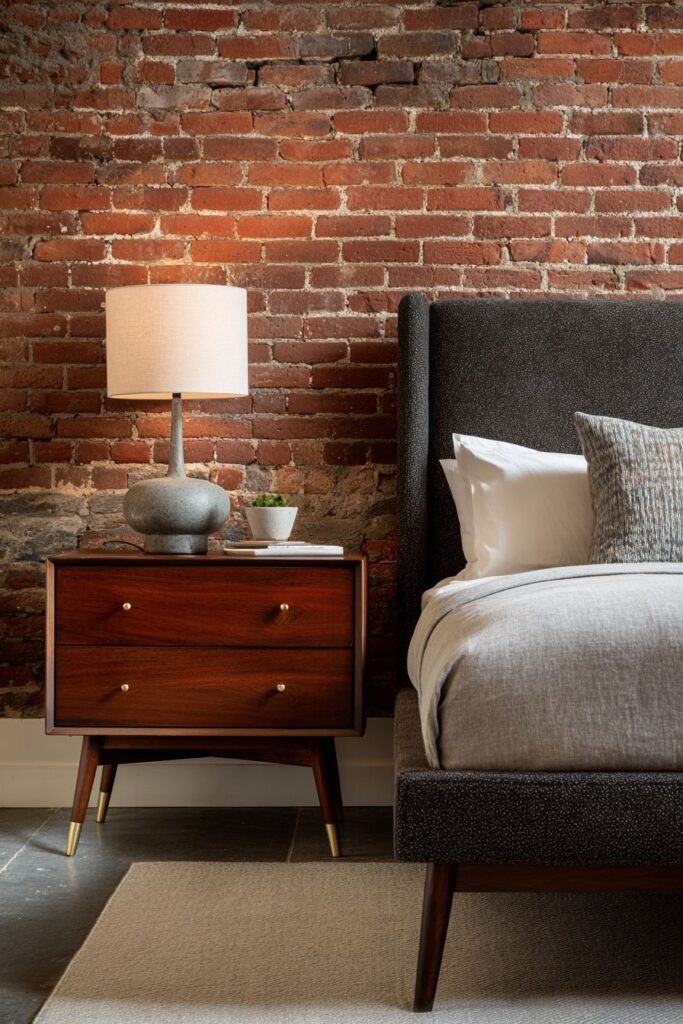
The bed includes an upholstered headboard in charcoal wool fabric that adds soft texture and visual warmth while providing comfortable support for reading or relaxing. This textile element introduces another material to the rich palette, its woven texture mediating between the rough brick and smooth wood. The charcoal color provides sophisticated neutral grounding that allows the brick wall and walnut furniture to command attention while ensuring the bed remains a comfortable, inviting focal point.
Natural lighting highlights the brick’s dimensional quality, emphasizing the mortar joints and individual brick variations that create depth and character. The authentic period materials and sophisticated interplay of textures demonstrates mid-century design at its most accomplished, where material diversity creates visual interest while maintaining overall harmony.
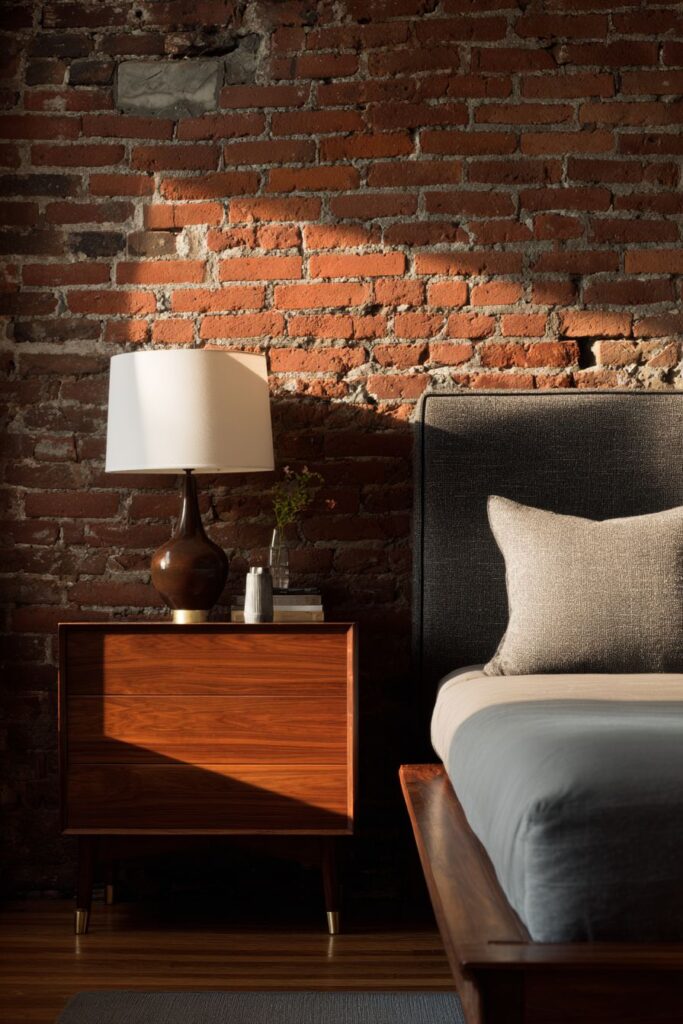
Key Design Tips:
- Feature exposed brick walls for textural contrast and industrial-organic character
- Choose warm-toned brick that complements rather than clashes with walnut furniture
- Select low dressers with brass leg tips or hardware for refined elegance against rough textures
- Add upholstered headboards in wool or linen to introduce soft textural elements
- Use fiberglass or similar period-appropriate lamp shades that showcase mid-century material innovation
Why These Mid-Century Bedroom Designs Are the Best
Mid-century modern bedroom design represents the pinnacle of thoughtful interior architecture, combining timeless aesthetic principles with practical functionality that remains relevant decades after the movement’s peak. These twenty bedroom designs showcase why mid-century modern continues to be one of the most sought-after interior design styles, offering solutions that address contemporary living needs while providing enduring visual appeal. The mid-century bedroom aesthetic achieves the perfect balance between minimalism and warmth, creating spaces that feel uncluttered yet inviting, sophisticated yet comfortable.
The emphasis on natural materials—walnut, teak, rosewood, oak, and organic textiles—ensures that mid-century bedrooms develop character and beauty over time rather than appearing dated or worn. These authentic wood species bring inherent warmth and organic patterns that synthetic materials cannot replicate, creating bedrooms that feel connected to nature even in urban environments. The careful selection of materials like terrazzo flooring, grasscloth wallpaper, and ceramic accessories demonstrates the mid-century commitment to quality craftsmanship and honest material expression that creates spaces of lasting value.
Clean lines and streamlined silhouettes characteristic of mid-century bedroom furniture create visual calm and spaciousness, essential qualities for restful sleeping environments. Platform beds with low profiles, nightstands with tapered legs, and dressers with minimal hardware all contribute to an uncluttered aesthetic that promotes relaxation and mental clarity. This design approach proves particularly valuable in contemporary homes where bedroom spaces often serve multiple functions, from sleeping to working to relaxation.
The mid-century color palette—featuring warm earth tones like mustard yellow, burnt orange, olive green, and teal alongside neutral creams and greys—creates bedrooms that feel both energizing and soothing. These colors, inspired by natural landscapes and organic materials, provide psychological comfort while adding personality and visual interest. The strategic use of color blocking and accent walls demonstrates how bold hues can be incorporated without overwhelming the senses, creating dynamic spaces that support both rest and inspiration.
Innovative furniture design from the mid-century era, including molded plywood chairs, fiberglass shells, and integrated platform bed systems, offers space-efficient solutions that maximize functionality while minimizing visual and physical clutter. These pieces represent breakthrough thinking in furniture construction and ergonomics, creating bedroom furnishings that serve practical needs while functioning as sculptural art. The combination of organic and manufactured materials—leather with metal, wood with plastic, ceramic with brass—demonstrates the era’s forward-thinking approach to material innovation.
The mid-century emphasis on indoor-outdoor integration through large windows, sliding glass doors, and minimal window treatments creates bedrooms that feel connected to the natural world, promoting better sleep and overall wellbeing. This architectural approach floods spaces with natural light, which regulates circadian rhythms and enhances mood while reducing dependence on artificial lighting. The seamless flow between interior and exterior spaces makes bedrooms feel larger and more open, addressing contemporary desires for spaciousness even in modest square footage.
Lighting design in mid-century bedrooms achieves the perfect balance between ambient and task illumination, using sculptural fixtures that serve as both functional necessities and decorative focal points. Globe pendants, ceramic table lamps, and slender floor lamps provide layered lighting that can be adjusted for different activities and moods while contributing to the overall aesthetic through their distinctive forms and materials. This thoughtful approach to illumination creates bedrooms that function beautifully at any time of day.
Storage solutions that integrate seamlessly with bedroom architecture—built-in teak cabinetry, floating nightstands, credenza-style dressers—maximize capacity while maintaining clean lines and visual calm. The mid-century approach to storage recognizes that bedrooms must accommodate numerous possessions without becoming cluttered or chaotic, leading to innovative solutions that conceal everyday items while displaying curated collections. This practical yet beautiful approach to organization creates bedrooms that remain functional and attractive over time.
The enduring appeal of mid-century bedroom design lies in its human-centered approach, where every element serves the needs of occupants while contributing to an aesthetically cohesive whole. From ergonomic lounge chairs for reading to efficient workspace integration to textured wall treatments that add visual interest, these bedrooms demonstrate that great design addresses real-world needs without sacrificing beauty. The result is sleeping spaces that support rest, work, relaxation, and personal expression—exactly what contemporary homeowners seek in bedroom design.
Conclusion
Creating a mid-century modern bedroom offers the opportunity to combine timeless design principles with personal style, resulting in a sleeping space that feels both historically grounded and refreshingly contemporary. The twenty designs explored in this article demonstrate the remarkable versatility of the mid-century aesthetic, from minimalist approaches featuring clean lines and neutral palettes to more expressive interpretations incorporating bold colors and textured materials. Each design showcases how thoughtful attention to furniture selection, material quality, color coordination, and spatial planning can transform an ordinary bedroom into an extraordinary retreat.
The key to successfully implementing mid-century bedroom design lies in understanding its core principles: honest material expression, functional beauty, integration with nature, and restraint in ornamentation. Whether you choose to feature a platform bed with geometric textiles, create a reading nook with iconic furniture pieces, incorporate dramatic lighting fixtures, or showcase textured wall treatments, the goal remains creating a harmonious space where every element serves both practical and aesthetic purposes. The mid-century movement’s emphasis on quality over quantity encourages investing in fewer, better pieces that will provide lasting value and enjoyment.
As you consider incorporating these ideas into your own bedroom, remember that successful mid-century design requires balance—between bold and neutral colors, smooth and textured surfaces, manufactured and organic materials, open and defined spaces. Start with foundational pieces like a quality platform bed and storage furniture in walnut or teak, then layer in textiles, lighting, and accessories that reflect your personal taste while honoring the mid-century aesthetic. Don’t be afraid to mix authentic vintage finds with contemporary pieces inspired by the era, as this combination often creates the most livable and personal spaces. The beauty of mid-century bedroom design is its adaptability—whether you’re working with a small urban apartment or a spacious suburban home, these principles can be scaled and adapted to create the perfect sleeping sanctuary that will remain stylish and functional for years to come.
